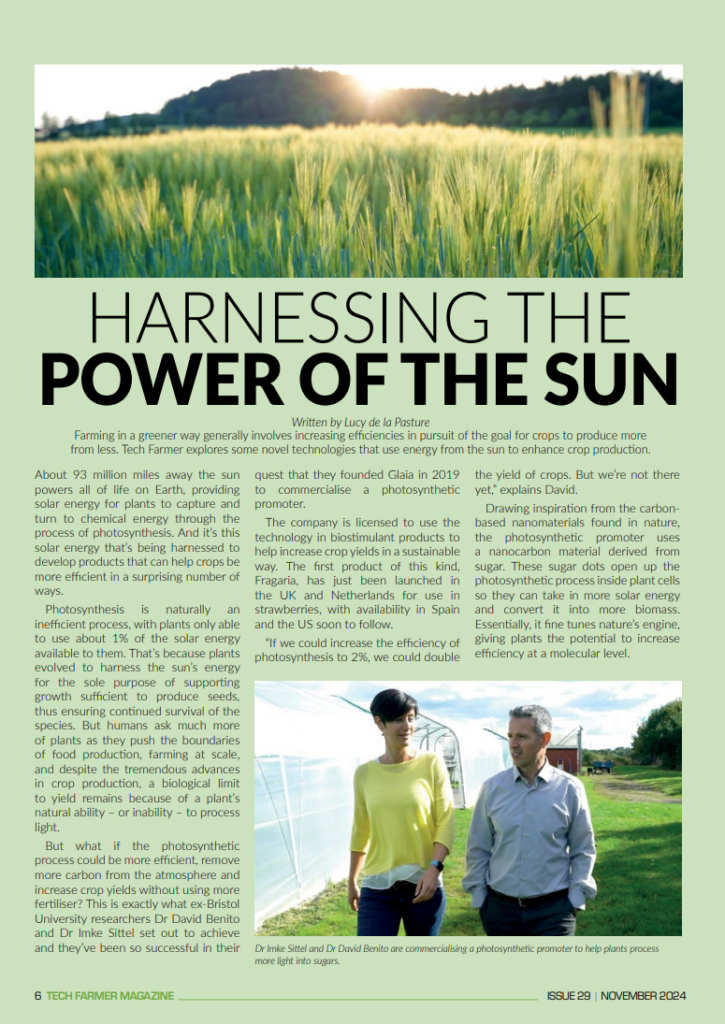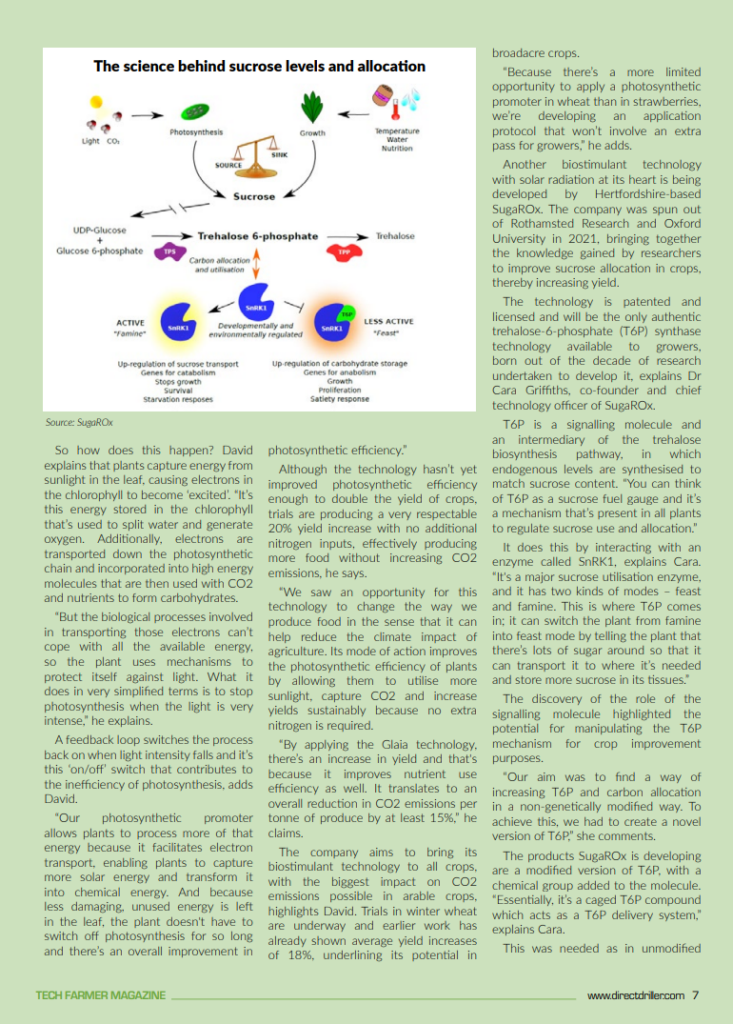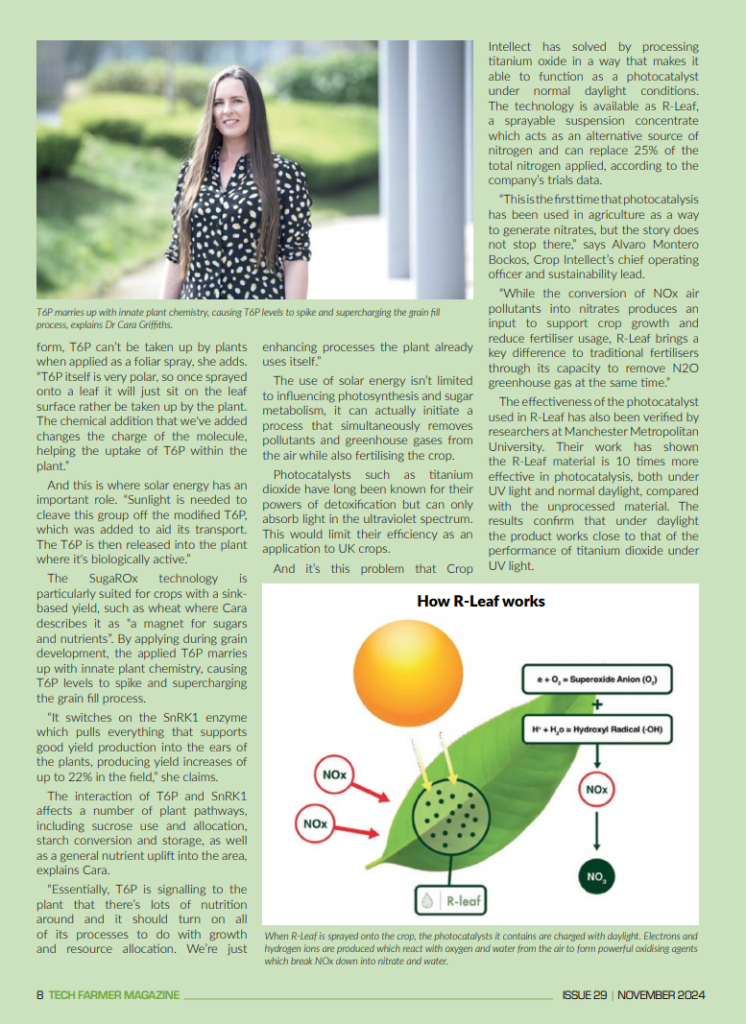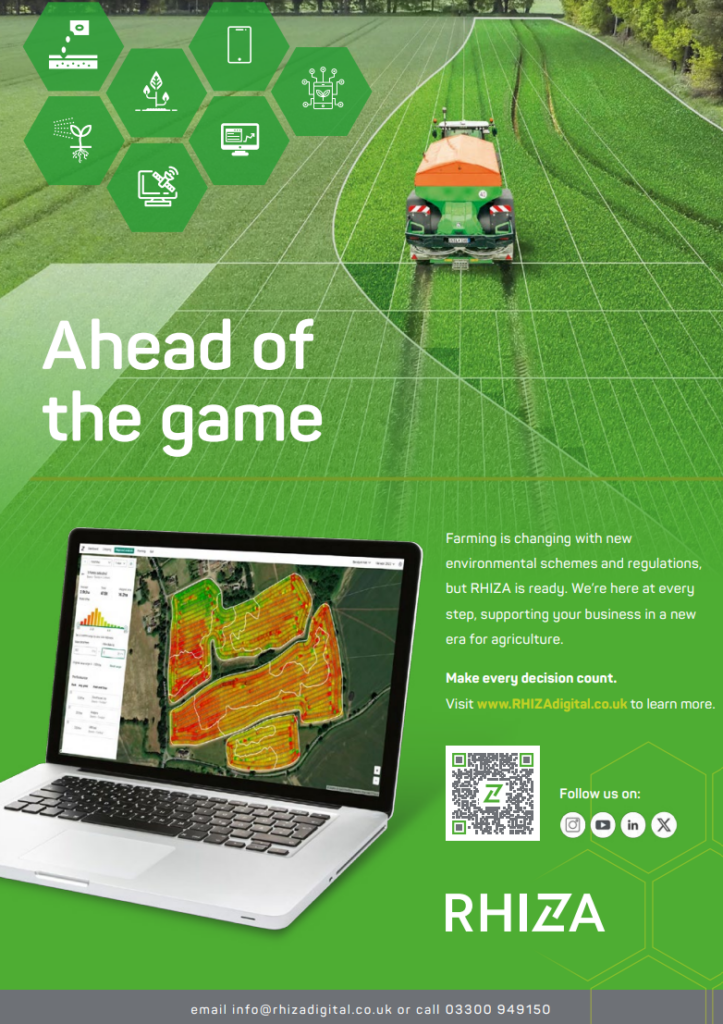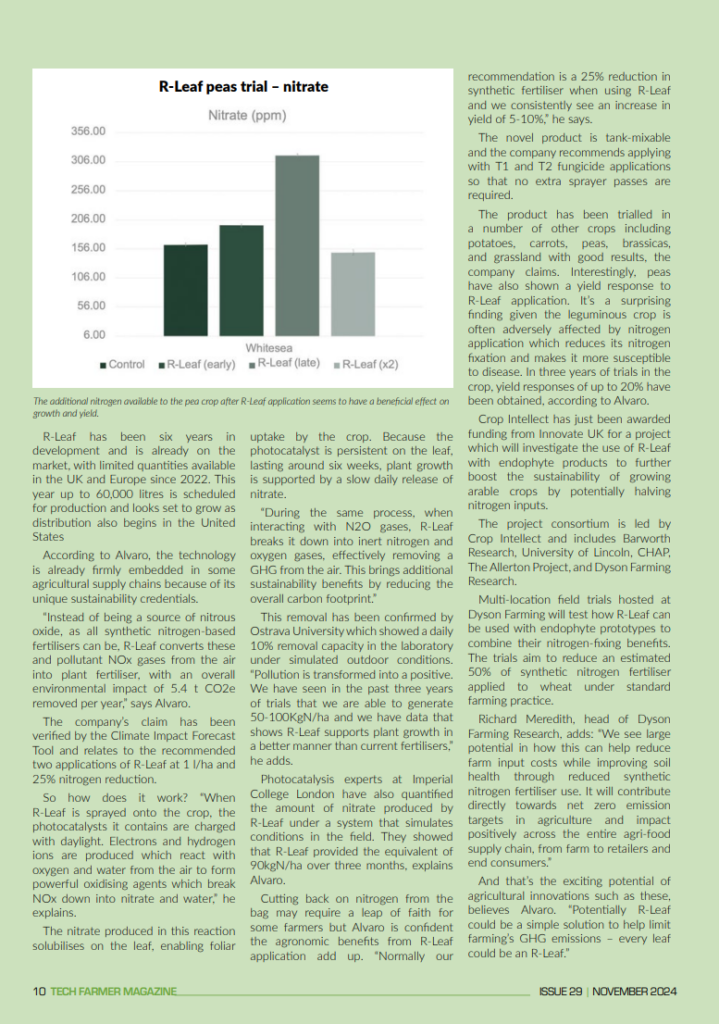If you would like a printed copy of any of our back issues, then they can be purchased on Farm Marketplace. You can also download the PDFs or read online from links below.
-
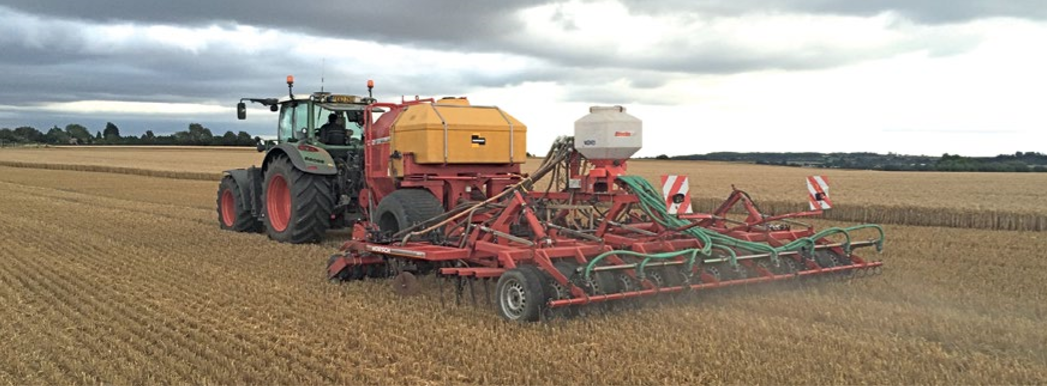
How To Start Drilling For £8K
Clive Bailye’s seed drill of choice is his 6m John Deere 750A , which has been used exclusively for 3-4 seasons. Last year, with an increased acreage, the founder and publisher of this Direct Driller magazine thought a second seed drill was necessary. Having just the one machine was a risk and in a difficult season would mean drilling was delayed. He looked around and found a good condition Horsch CO6 tine drill advertised in Germany.
Words and pictures by Mike Donovan
After delivery he rebuilt the coulters to a narrow profile so as to reduce soil disturbance. He says the tine drill is very useful driling after straw crops such as osr and also through the straw on second crop cereals.
Buying the drill from a German farmer was not particularly complicated, and provided him with a higher spec machine than Horsh sell in the UK. The seed dart tyres are much wider, and the machine is fitted with blockage monitors as well as full width front packers and also a liquid fert application system.
A sheaf of photos were taken, and Clive then asked for some of specific parts to show wear. The deal was done at under £5,000 which Clive says is the market value of these machines which are too large for small farmers to buy. Original owners like to buy new and sell when the machine is still in good condition.
Narrow tines with wear tiles
@Clive knew he wanted to make changes, substituting the Horsch tines and coulters for something far narrower, and has ended up getting his own design of tine made, which has a wear tile made from Ferobide, far harder than tungsten. The drill is on the farm primarily for osr and 2nd crop cereals drilled into chopped straw and the 25cm spacing is okay for these crops.
Comments on Clive’s on-line forum, TFF, said the drill many not be so good with beans, as the slot is a mere 12mm wide. And in barley the spacing may well be too wide as it needs to be thick. Clive points out that the seed pipe can actually be a bit wider than 12mm as it is in the shadow of the point. It would be good to have the option of using it for beans.

Above left: The cheap CO6 is being calibrated ready for its first outing

Above right: The adapted Horsch is being filled by the home built drill logistics trailer with seed and liquid starter fert.
Getting around the German instructions
The Horsch came, of course, with a control box and instructions in German. More on-line discussion revealed that English instructions were available on the Horsch website, and another explained that Horsch was sourcing some of these parts from Agton in Canada anyway. Zealman from New Zealand explained that the button marked with callipers should be held down for around 5 seconds. The menu is where you adjust the tramline sequence, valve layout and row numbers.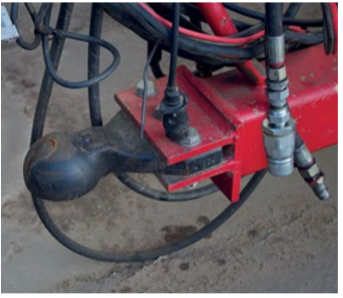
Ball hitch is a continental standard and provides a positive connection between tractor and drill

The Stocks Wizard has a rotor modified for Avadex which otherwise leaks everywhere
A Stocks Wizard is on the back of the drill and used for Avadex. Here again the knowledge of actual farmers is helpful. Alistair Nelson warned that the rotor and the surrounding shroud need to be changed, and he got good advice “from Rick at Stocks”. Clive has the same setup on the 750A and says that the Avadex leaks everywhere unless the modification is made. The drill was acquired and modified in 2016 and the results have been excellent.
The machine went through the residue without many problems and having the second drill has meant more timely planting. Clive has shown that moving into No-Till is not the expensive exercise so many farmers think it might be. The total cost, after modifications which included replacing all tines and coulters, was under £8,000.
Author Mike Donovan writes: we have featured a number of home made direct drills in @Practical Farm Ideas, and are always interested in seeing more. Please contact mike editor@farmideas.co.uk or 07778877514.
-

Farmer Focus – Tim Parton
Another year, another set of problems?
I can only feel at the time of writing that we are getting kicked yet again with what I can only describe as the worst budget I have ever seen in my life! Aside from what they are doing to farming; what on earth are they doing to the whole UK economy? I can only see inflation going up along with unemployment. Growth will grind to a halt. Where does the government think growth and wealth comes from? Certainly not from within! I can see the effects of this budget lasting for decades to come! Basically, we need growth of all industries to move forward and to have a thriving economy. With agriculture being a primary industry and integral for all other industries, wouldn’t you think that the politicians would want to get the foundations right first? After the mistakes that were made over 100 years ago about food security, have the government learnt nothing? Obviously not. Do they sincerely comprehend where their food comes from? Rant over. Back to farming.
All crops have been drilled here. Thanks again to Micheal Kavanagh for helping out whilst I am continuing my rehabilitation. It does seem to go on and on; at the same time, getting kicked and punched from so many directions along the way! Yet on the flip side, I have had so many messages of support from around the world, of which I will always be grateful and humbled.
It has been another tough autumn but one that once again shows the benefits of getting one’s soil functioning and in order. The last time I did an infiltration test I was down to thirty seconds per inch. Where I started all those years ago it was taking six and a half minutes. You can see how my soil has improved. I always like to prove to myself what is working and what is not, or needs amending, and this year my soil came into its own, allowing us to travel and get seeds into the ground in good conditions, where others could not travel. In my experience this has always been half the battle of having the patience to only go drilling when the conditions are right. I just cannot see the point of mauling seed into the ground, knowing full well that you are likely to have half a crop which will lose you money long term in more ways than one; since, more than likely you will have compaction issues moving forward, which will have to be resolved in order to keep profitable.
All seeds are drilled with my biological seed drench, along with nutrition, humates and wood vinegar. As I explained in my last article, wood vinegar has so much to give, which I go into in a lot more detail on my website at timpartonfarming.com All wheat is companion cropped with beans, or clover, or both, depending on the field. We all should be fully aware that nature never grows monocrops, so why on earth would we? When we can now get paid for planting a companion crop through SFI, why would you ever think of planting without when there are so many benefits to be had, from fixing nitrogen, sharing nutrients, water and keeping ground covered to suppress anything else germinating, the right combination just keeps on giving and we get paid for the privilege (government allowing)?
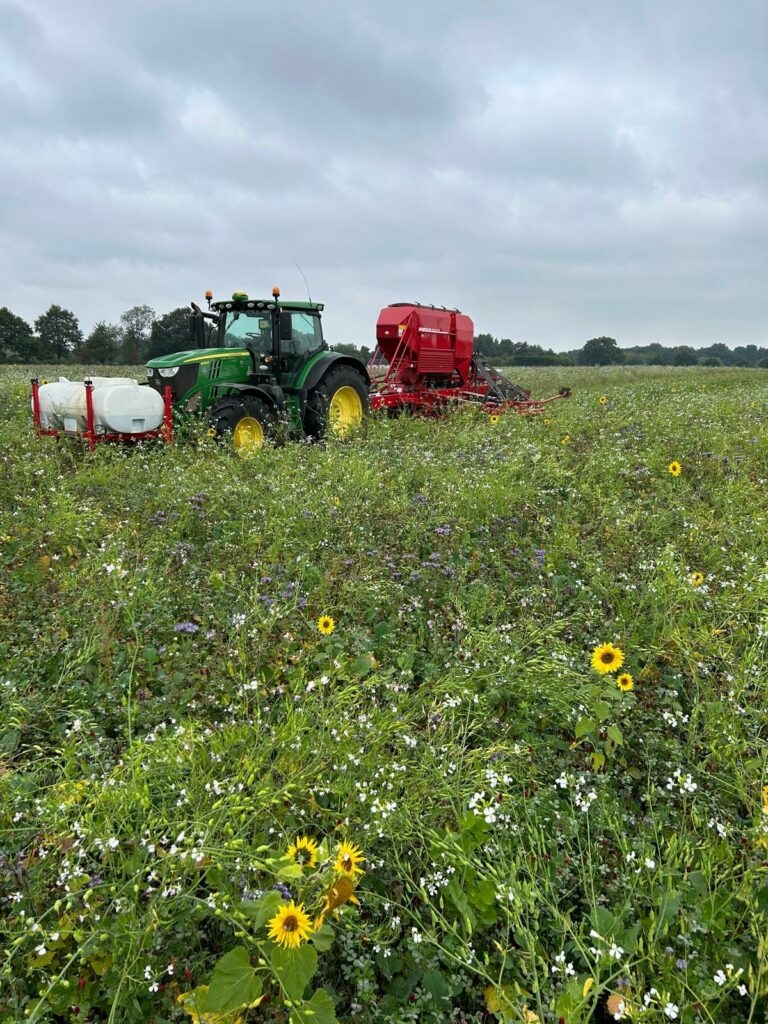
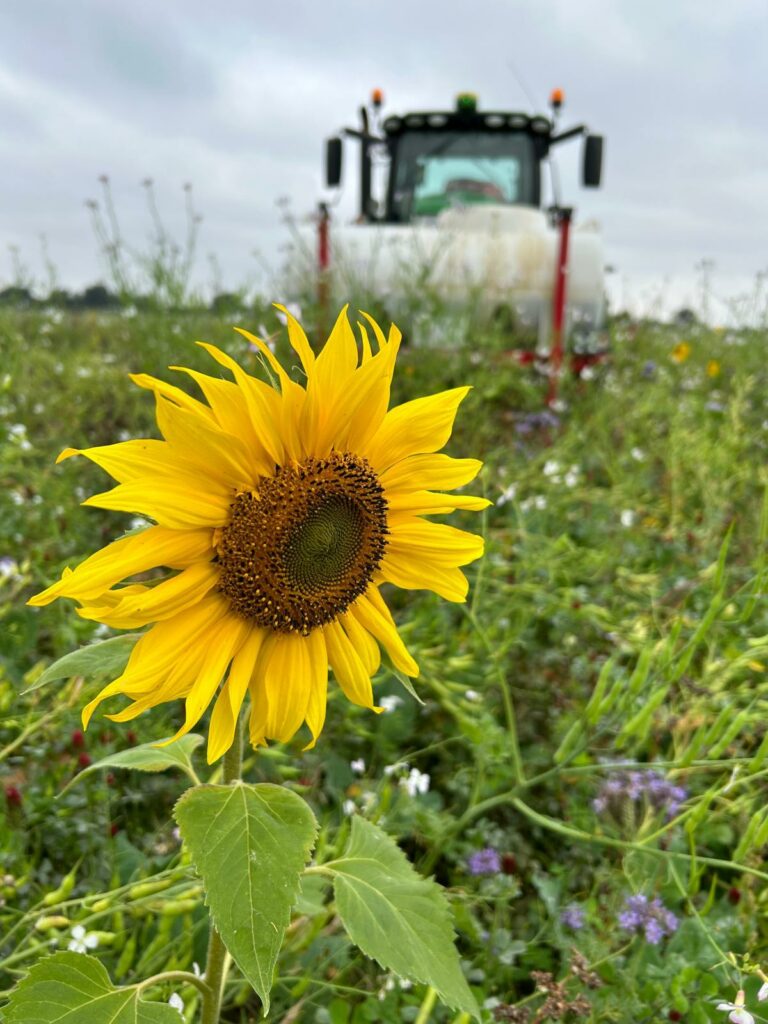
I know, from being lucky enough to speak around the world, we UK farmers are very much envied on the help we are offered to improve our own soils and don’t we just need that help in today’s climate of inclement weather and wheat gushing into the country pushing our prices ever lower! If you had money to invest, the return agriculture gives certainly would not inspire to invest now, would it? But has the government gone far enough to want to stop corporate investors from investing in agriculture? I think not, they have just got it wrong yet again! Back to farming, I promise!
The Green Farm Collective (GFC) board has been working hard to find the right reward for our members, selling certified regenerative wheat into the baking industry and will be gaining momentum this year, if all goes to plan. One thing that we are all passionate about is that we want to be as transparent as possible, ensuring that we cannot be accused of green washing. This is something that must always be exposed, in my opinion, as we need to get full public support behind the movement of regenerative agriculture so they can regenerate themselves along the way and be part of the journey. Having a healthy body and living in a healthy environment – every person has the right to these basic needs; the right to know how their food has been produced and know exactly what they are eating. It is up to us all to demand a higher price for this nutrient rich product and not let it be diluted into conventional stores for a conventional price, as its worth so much more.
The other big thing is that it’s so important to keep control of the carbon sequestered on farm, as this belongs to farm and should be marketed separately, in my opinion along with natural capitol. They should not be allowed to be amalgamated in with produce, as once we allow that to happen, we will never get the benefits in financial gain and don’t we need every avenue of income at the moment? We all need to come together on this one whoever you decide to trade with, but at GFC we will be able to get you a good price on all three moving forward.
The other one that has saddened me this year is the introduction of gene editing (GE), which is not too dissimilar to genetic modification (GM). I am old enough (only just) to remember when GM crops were being introduced into the States, with all the claims of how farmers were going to make more money, better for the environment, blah blah. When in reality they have just been a disaster for the environment and there is plenty of evidence showing a knock-on effect to human health, meaning, for me, there is nothing to like! I can achieve most the claims that are being made for their introduction from just plain nutrition and epigenetics. Epigenetics is one of the main reasons of retaining home saved seed, with the offspring aiming to always be an improved version of their parents. Having the right immune system to go back into the environment, they have become adapted too, but as a very much evolved and therefore improved version.
Once you have let the genie out of the bottle you cannot put it back in and how many times over the years have we been told that products are safe, when in reality they are not? Household budgets spent a third of their income on food in the 1940s with 92-98% of their fruit and vegetables coming from gardens and allotments, meaning everybody had a connection to mother earth, which is so important in my opinion. Present day and we spend 10-12% on food. Some people have had little respect for what goes into their bodies, leading to obesity and other health problems. Surely once they understand the difference nutrient rich food can have on their own health, they would value what they are putting into their bodies and be willing to increase their spend on food? Similarly in industry the foundation to success, health equals wealth, all starting with soil.
I have been out on the talking circuit spreading the word of regenerative agriculture: the first one being at “Land Alive”, which is a new conference, down in Somerset. The conference was well attended and was a real pleasure for me to be speaking, along with Andy Neal (Rothamsted) and Ian Wilkson (Farm-Ed) on the big debate “Glyphosate V Tillage”, which made for a very interesting debate. I have also been speaking down in London, firstly for the under 35s Farmers’ Club chaired by Andrew Court, which was a very enjoyable evening for all those who attended. Then moving on to be part of the panel at “Banking for Change” hosted by Soil Association Exchange, which was addressing the financial barriers to farm transition to regenerative agriculture and was attended by all the major banks who are looking to be a part of helping the transition. The move towards Regen is happening, but not fast enough for me, as the clock is ticking.
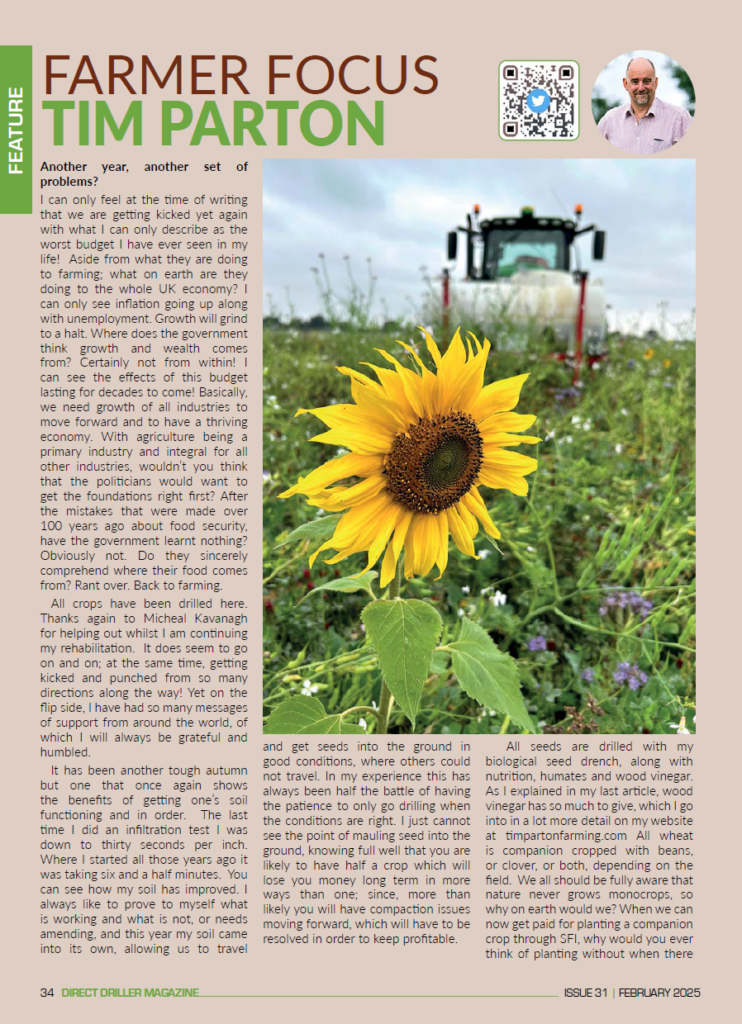
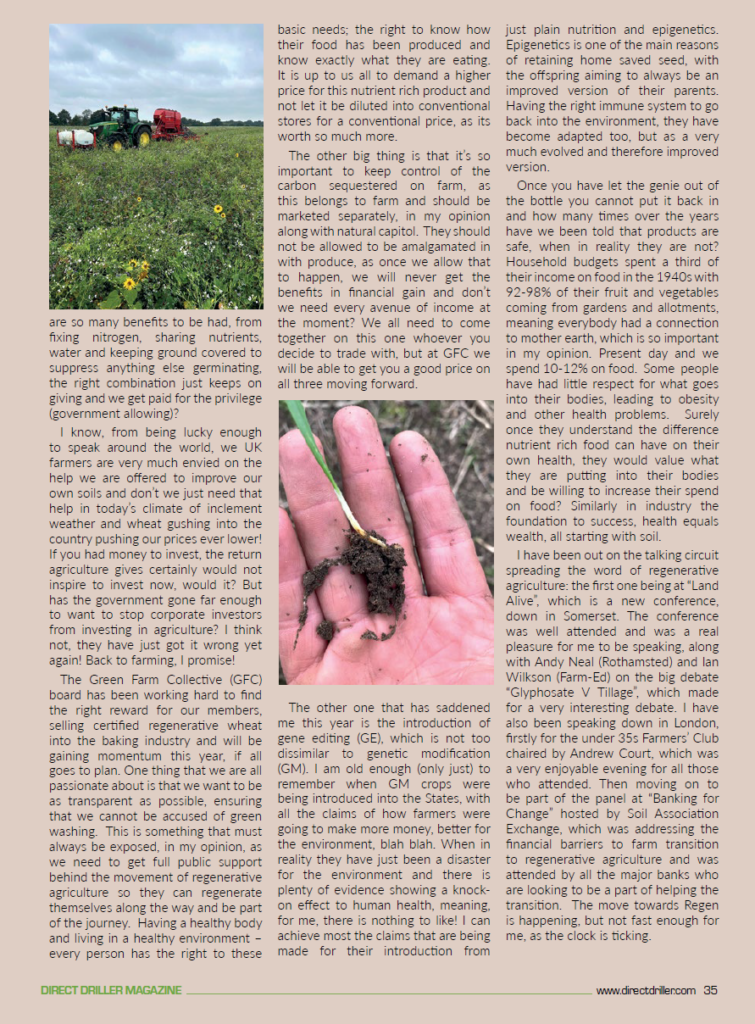
-

Smart phosphorus management to boost yields in depleted soils
WRITTEN BY JOHN HAYWOOD – UNIUM BIOSCIENCE
Standfirst: Environmental conditions play a significant role in determining the availability of phosphorus (P) to plants.
With the challenges of another wet season, and potentially depleted soil reserves, many growers are looking for ways to support winter crops and optimise phosphorus uptake in spring crops.
As an essential macronutrient, phosphorus is crucial for plant energy transfer, root development, and flowering and insufficient phosphorus can lead to decreased yields. However, phosphorus often exists in forms that are not readily accessible to plants, and environmental factors such as soil pH, temperature, moisture, and microbial activity directly influence how much phosphorus plants can absorb.
Factors affecting phosphorus uptake
Soil pH
Soil pH is one of the most critical environmental factors affecting phosphorus availability. In acidic soils (with pH levels below 5.5), phosphorus tends to bind with aluminum and iron, forming insoluble compounds that plants cannot absorb. In contrast, in alkaline soils (with pH levels above 7.5), phosphorus forms insoluble compounds with calcium. The optimal soil pH for phosphorus availability typically lies between 6.0 and 7.0, where phosphorus remains in its most accessible form – orthophosphate.
Farmers often adjust soil pH by applying lime to raise pH or sulfur to lower it, improving phosphorus availability. Without proper pH management, even soils with high phosphorus content can lead to deficiencies, as phosphorus remains locked in forms unavailable to plant roots.
Soil moisture
Soil moisture also has a significant impact on phosphorus availability. In waterlogged or overly saturated soils, oxygen levels decrease, leading to anaerobic conditions that can slow down the release of phosphorus from organic matter. In such environments, phosphorus may also bind with iron, further reducing its availability.
Conversely, in dry soils, the lack of moisture inhibits the movement of phosphorus toward plant roots. Phosphorus is relatively immobile in soil – plants need phosphorus to be dissolved in soil water to absorb it, unlike nitrogen, which can move more freely with water. As a result, drought conditions can lead to phosphorus deficiencies because plants struggle to absorb the nutrient without sufficient water to facilitate its uptake.
Maintaining balanced soil moisture through irrigation and proper drainage helps ensure that phosphorus remains accessible to plants. Cover crops and organic matter can also improve water retention in the soil, indirectly promoting better phosphorus availability.

Temperature
Temperature influences both the chemical reactions in the soil and the biological processes that control phosphorus cycling. At lower temperatures, the microbial activity responsible for breaking down organic matter slows down, reducing the release of phosphorus into the soil. This is especially problematic in colder climates where spring planting begins before the soil warms sufficiently to support microbial decomposition.
In higher temperatures, microbial activity increases, releasing more phosphorus into the soil. However, extremely high temperatures can cause soil to dry out, limiting phosphorus movement toward roots. In regions with fluctuating temperatures, such as temperate climates, phosphorus availability can vary seasonally.

Microbial activity
Soil microorganisms, particularly mycorrhizal fungi, play a key role in phosphorus availability. Mycorrhizal fungi form symbiotic relationships with plant roots, extending their ability to access phosphorus in soil particles. This is particularly important in soils with low phosphorus levels, as the fungi help extract phosphorus from insoluble compounds.
Environmental factors like soil pH, temperature, and moisture all influence microbial populations and activity. In harsh conditions—whether too hot, cold, dry, or wet—microbial activity decreases, limiting phosphorus availability. Managing the soil environment to support healthy microbial populations through the addition of organic matter and minimal tillage practices can enhance phosphorus uptake by plants.
Erosion and soil compaction
Physical conditions such as soil erosion and compaction also impact phosphorus availability. Erosion can strip away the topsoil, where most phosphorus is stored, leading to deficiencies. Compacted soils, on the other hand, reduce root growth and limit the movement of phosphorus toward plant roots. Reducing tillage and implementing erosion control measures, such as planting cover crops and maintaining ground cover, can mitigate these effects.
Supporting your crops in less-than-ideal conditions
Many growers are considering what can be done to give autumn crops a helping hand, given the wet weather of the past season and depleted soil reserves, as well as the potentially compromised establishment of this year’s winter cereals. Phosphate biostimulants are worth considering, providing an alternative and cost-effective option to applying foliar phosphate, which can give inconsistent results.
Calife Extra is a stimulant designed to improve crop rooting and maximise nutrient uptake. It essentially tricks the plant into scavenging and therefore boost its roots and exudates which feed the soil biology.
Working in synergy with this is Luxor which provides an efficient phosphate supply through maximising availability and reducing adsorption in the soil. Because Luxor contains pidolic acid (L-GPA), the overall combination helps a crop to make the most of this availability while increasing nitrogen assimilation.
Ultimately, by adjusting soil pH, maintaining optimal moisture levels, supporting microbial activity, and preventing erosion, farmers can improve phosphorus availability, enhancing crop yields and promoting sustainable soil health.

New phosphorus decision-making tool launched
An easy-to-use online tool allows farmers to assess the phosphorus biological availability in their soils by entering their post code.
Developed by Unium Bioscience, ‘Phosphate Power’ is a free, easy to use online tool that helps farmers assess the phosphorus biological availability in their soils.
A critical nutrient during germination and establishment phases, phosphorus availability can often be limited by various soil and environmental factors. Phosphate Power offers tailored recommendations depending on the phosphate bioavailability in the soil. By using the phosphorus index, based on peer-reviewed data, it informs farmers whether their soils are biologically optimised to provide what the crop needs.
“The new service is simple and practical,” explains John Haywood at Unium Bioscience. “It links environmental conditions such as soil moisture, temperature, soil texture and location to a forecast for the next seven days to help growers with precise, location-specific information. This enables informed decision making on how best to supply crops with phosphorus at a very critical and sensitive time in the plant’s physiology,” he says.
If phosphorus availability is limited, the tool provides advice on appropriate actions, such as the application of seed treatments, foliar phosphorus products, or biostimulants, which encourage root growth to enhance phosphorus absorption from the soil.
“Seed treatments are a sensible choice when you are planting outside optimal conditions to boost establishment and root growth – for planting from October to April,” says John.
“Depending upon your soil P levels, it will help to dictate whether you need to mine reserves – the only way to do this is to push out more roots, more active roots in terms of pushing out more exudates to feed soil biology or by supplying an efficient form of phosphorus – organic or inorganic – based on your soil’s pH, placing it strategically near the root structure, or using effective foliar treatments for optimal uptake,” he says.
This model is the next step to help farmers make informed decisions, question practices or recommendations and to stimulate debate as to how to manage phosphorus uptake better.
One of the key advantages of this tool is its ability to help farmers during the critical early stages of crop development, ensuring that their plants have the necessary nutrients for optimal growth. By leveraging environmental data, Phosphate Power aims to maximise efficiency, leading to healthier crops, improved yields, and reduced input costs.
In trials with Cambridgeshire arable farmer Russ McKenzie, Unium has achieved lower costs and increased yields with its nutrient programme. “We are excited to be able to bring this tool to help growers optimise their yield potential in the same way,” he says.
“It’s designed to help farmers make better decisions about phosphorus management and improve crop yields, while also reducing costs and maximising return on investment,” adds John.
By integrating this tool into their practices, farmers can expect to optimise crop phosphorus uptake and enhance their overall production efficiency.
Phosphate Power will be available to growers nationwide, helping them achieve optimal results through smarter nutrient management.
Farmers can access Phosphate Power by visiting uniumbioscience.com/phosphate-calculator/ where they can quickly input their postcode to receive a detailed analysis of the phosphorus content in their soils.
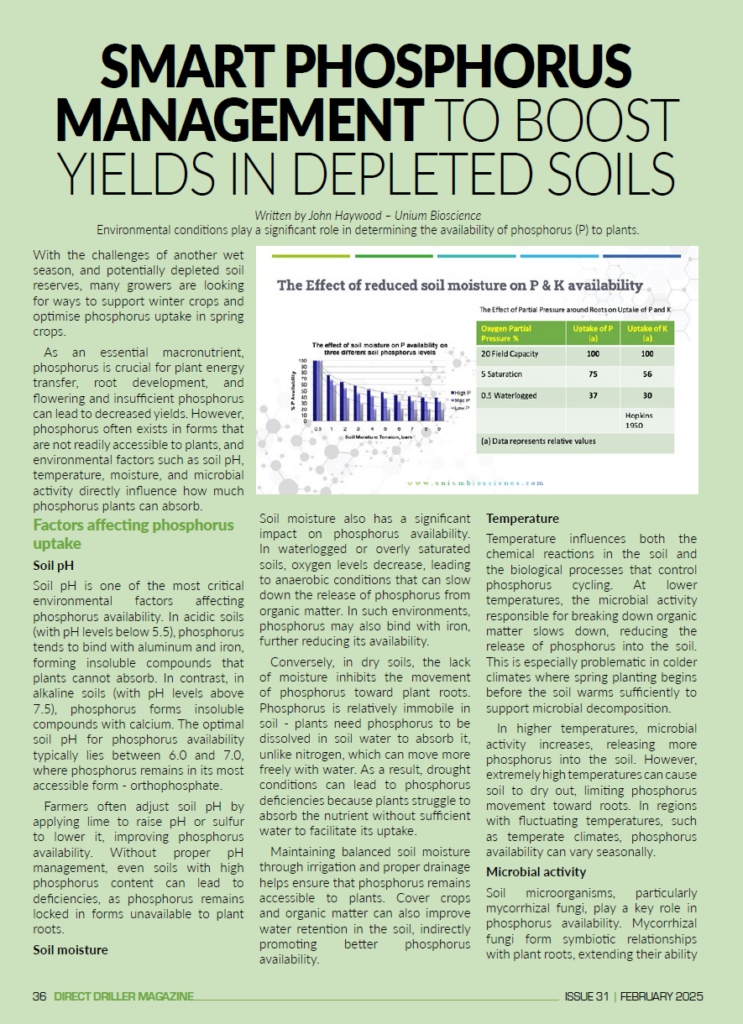
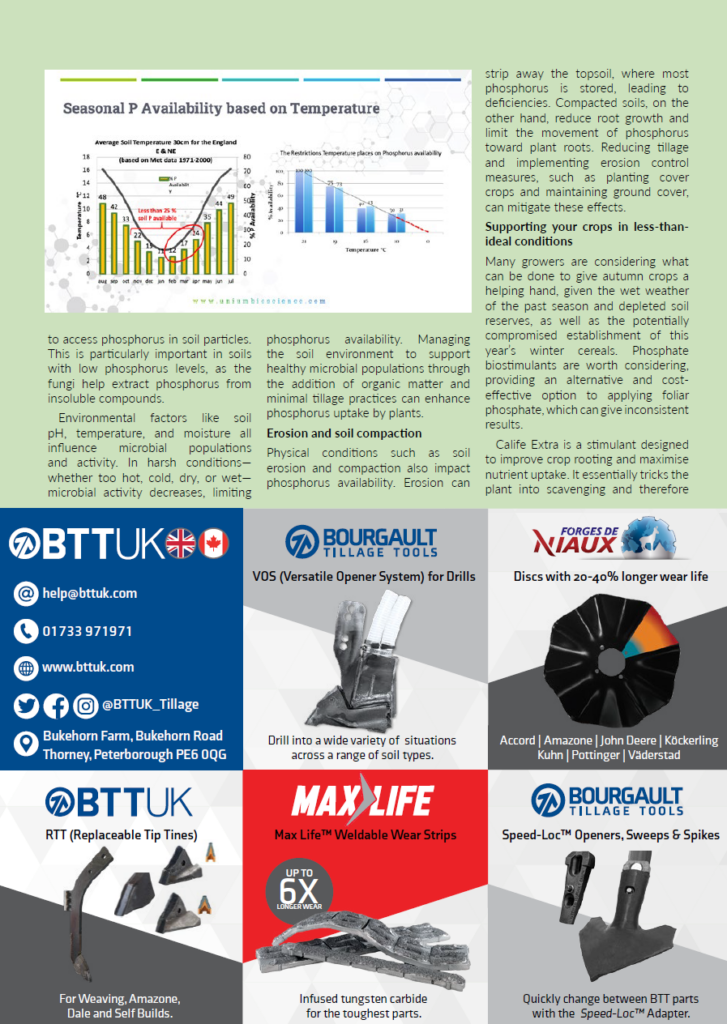


-
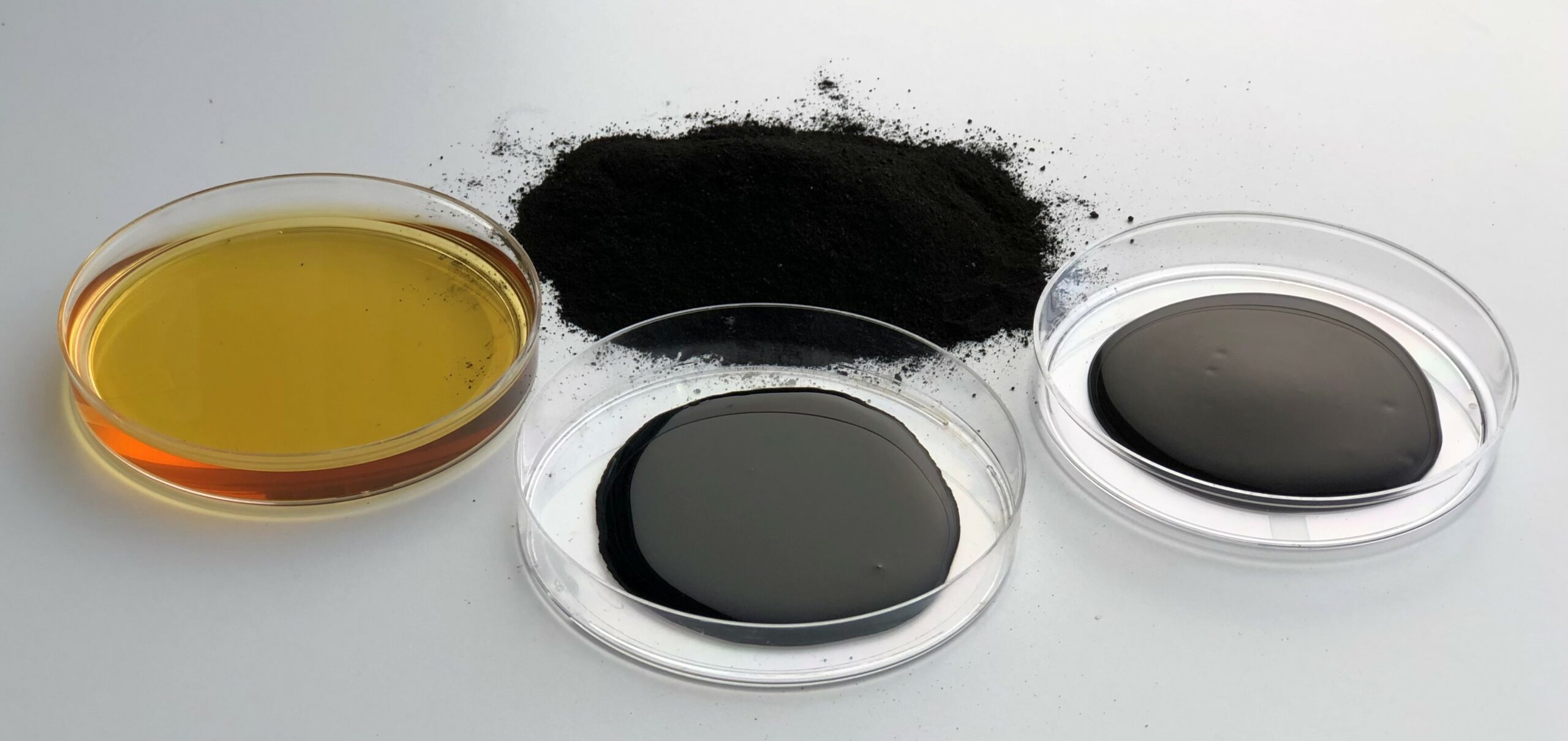
Humic Substances: a background to their classification, properties, origins and uses in Agriculture.
Written by Tim Smales from Humi-Cert.com
Humic substances play a vital role in a healthy soil. We’ll review what humic substances are, their benefits, the various amendments that are available and some examples of how they are used in agriculture. Having an understanding of these substances and their properties is of great use in understanding how they can benefit agriculture.
It is important to understand that there is a difference between soil organic matter and humus. Soil organic matter is defined as carbon containing compounds which have originated from living beings. This is still decomposing at various rates in the soil. Humus is the black/brown substance found in the top layers of soil. It is formed by the physical, chemical and microbiological transformation of biomolecules from the debris of living organisms via a process named humification. Humus is a stable component in the organic matter of the soil and is resistant to further degradation. The term ‘Humic substances’ is used to describe the three organic, carbon based, compounds which make up humus. These substances are humin, humic acid and fulvic acid, which have been separated into groups based on their solubility and physical properties. They exist in abundance in terrestrial and aquatic environments and are rich in oxygen-containing functional groups such as carboxyl, hydroxyl, carbonyl, quinone and methoxy groups 1, giving them their ability to chelate and interact with nutrients.
Humins are large molecules and have thehighest molecular weight of the humic fractions. Humin is not soluble in solutions at any pH and resists movement and leaching in the soil. It is dark brown to black in colour and has a Cation Exchange Capacity (CEC) of approximately 100.

Stevenson, F.J.; Hunus Chemistry: Genesis, Composition, Reactions, John Wiley & Sons, NY, 1994 Humic acid consists of molecules of moderate molecular weight around 10x smaller than humin. It is only soluble in alkaline solutions. It has higher molecular activity than humin and a higher CEC, of approximately 400. Amendments are more commonly added to soil and are resistant to leaching. It is dark brown to black in colour.
Fulvic acid has the lowest molecular weight, around 10x smaller than that of humic acid. It is soluble in solution at all pHs. Fulvic acid has the highest bioactivity levels of the humic fractions, possessing the highest CEC, of over 1000. Its smaller size allows it entry to the plant through the leaves, stem or roots and is able to deliver trace minerals directly into plant cells. Although it is of great value in the soil it is principally used for foliar applications in agriculture. It is leachable through the soil and light yellow to brown in colour 2.
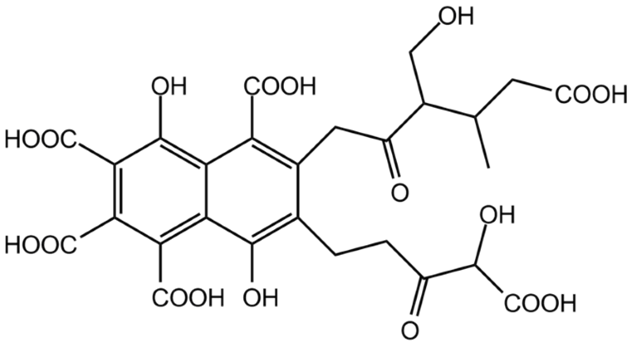
Buffle, J.; Greter, F.C.; Haerdi, W: Measurement of complexation properties of humic acid and fulvic acids in natural waters with lead and copper ion selective electrodes. Anal. Chem. 49, 1977, 216-22 Soil benefits Humic acids are able to increase soil nutrient availability by chelating, retaining plant nutrients (such as NH4+, Mg2+, Ca2+ and Na+) and co-transporting them to plants. Humic substances are able to buffer, retain water, improve aggregation and increase the carbon sequestration of the soil 1.
Microbiology benefits Humic substances are able to directly increase microbiological activity and indirectly influence nitrogen availability by promoting the growth and activity of these soil microorganisms, such as nitrogen fixing bacteria and mycorrhizal fungi3. One interesting study carried out over three years of soil-applied humic acid showed an increase in numbers of fungi considered beneficial to plants whilst numbers in strains considered pathogenic decreased 4.
Plant Benefits Humic substance amendments have been shown to increase crop yields, nitrogen use efficiency and nitrogen uptake 5 . Humic Acid can directly increase nitrogen uptake by stimulating enzyme activity in root cells 3. Increased root growth and mass through auxin-like properties of humic substances is also seen 6. Fulvic acid, in particular, can increase foliar micronutrient uptake and increase the nutritional value of the crop 7. Germination and seedling development can also be improved 2.
Environmental benefits Humic substances have been shown to be excellent fertiliser carriers/stabilisers and research 8 has evidenced reductions in nitrogen leaching and in fertiliser usage. Humic substances can also immobilise organic contaminants and harmful heavy metals in the soil, very useful properties for environmental cleanup 9 , and can reduce the salinity in saline soils as well as inhibiting salt accumulation 10. Humic and fulvic acids were shown to bind to glyphosate (herbicide), cypermethrin (insecticide) and azoxystrobin (fungicide), showing promise to clean contaminated water 11. An additional study evidenced humic acids were able to neutralise the antimicrobial effect of glyphosate 12.

Humic amendments
Firstly, by increasing soil organic matter with regenerative practices there will be an associated humic matter increase which is of huge benefit 13. Compost and manure (aerobic and anaerobic) applications will contain humic matter. Many of the humic amendments available are extracted from ancient mineral deposits, from lake sediments, peats, brown coals and shales. Humic and fulvic acid are contained in these mineral deposits, generally with significantly more humic acid than fulvic acid, and the humin content will vary from one deposit to another. Therefore, mineral sources can vary greatly in humic substance content and the biofunctionality they possess. It is worth noting that deposits will contain a host of micro and macro nutrients in low percentages. Generally humic substances from compost, manure and the soil are at a lower stage of humification, when compared to mineral sources, and their decomposition and biological activity is likely to be faster 14. Mineral sources will generally have a far higher humic substance content and the humic substances will have a greater longevity after application.
As described previously humic acid is soluble in alkaline solutions. Commonly potassium hydroxide is used as a base to extract humic acid from the mineral source and this results in the formation of potassium humate. You might find this marketed as a liquid product or a dehydrated powder/granule. If we stopped processing at this point, we would also have a product which retains the fulvic acid component from the mineral source. This potassium humate product will contain the additional nutrient potassium, from the potassium hydroxide, which is also useful as a crop nutrient. To separate the fulvic and humic acid an acid is added to the solution to reduce the pH. The fulvic acid will remain in solution (soluble at all pHs) and the humic acid will precipitate and drop out of solution (insoluble in acidic solutions). These fractions can then easily be separated. It is now easy to see why this alkaline extracted potassium humate is not compatible with acidic tank mixes, as it will precipitate out and block the sprayer. Generally, humin is only present in small amounts in these mineral sources. It is most often filtered and/or settled out and will not be found in commercial products. Other sources of fulvic and humic acids can be associated with fermented products, the decomposition of organic matter and extraction from water sources. A small number of products in the market, produced with the use of additional proprietary chemistry, contain humic acid that is soluble in acidic tank mixes.
The mineral source can be left chemically unaltered, but mechanically processed; crushed, powdered or micronised. As with many materials, increasing the surface area of a product will dramatically increase its functionality. A powdered raw mineral (or a dispersible granule made with powder) would be the most useful for soil or substrate amendment, when compared to a coarser raw mineral addition. There are also products which contain the micronised mineral in suspension/dispersion. The benefit of these micronised products is that they retain their original pH of 4-5 and will blend with an acidic tank mix with no fear of the product precipitating out in the spray tank. They also retain all the humic substances in the original ratio found in the mineral source: humin, humic and fulvic acid.
There is no universal testing protocol used to establish the humic and fulvic acid content of products. By their very nature they are not standardised molecules, and their size and chemical make-up can vary greatly. This makes accurate analysis very technical and difficult with some analytical methods capable of grossly overestimating the percentage content of a product. Much research was done to establish a more accurate analytical method, resulting in the creation of international standard ISO 19822:2018, which is regarded as the best method currently available. When making a purchase decision based on the content of humic substances it would be wise to establish how the content has been measured and whether it is likely to be accurate.
There is a huge body of research addressing the use of humic substance amendments in agriculture and so there is a great deal of useful information. However, the description of the humic substances is often very vague and rarely contains an accurate humic or fulvic acid content, making it difficult to establish a usage rate. Additional factors of the materials source and its manufacturing process will also affect the functionality of the humic substance. It can be challenging to transfer directly any research findings, where research trials are performed globally, in varying climates, on a variety of crops input with varying humic substance inputs. When applying humic products to the soil it would be wise to do this over several years as results can improve year on year, rather than presuming an application over one season will give a completely representative result.
Some examples of how humic substances can be used in agriculture.
Fulvic acid is widely used for foliar applications to increase nutrient uptake and use efficiency. It is a popular addition to foliar fertiliser blends and has also been used to increase the efficiency of foliar applications of glyphosate.
Urea and humic acid have become widely used together, particularly on pasture where increases in yield, efficiency and nitrogen losses have been recorded using solid products 15. Increased nitrogen efficiency was also evident in a study using foliar applied urea and humic acid on pasture 16.
Applying humic acid with phosphate applications has been shown to increase the fertiliser efficiency and improve yield 17,18.
Humic acid was shown to reduce nitrate leaching and ammonia volatilisation whilst increasing yields in a lucerne crop fertilised with dairy slurry 19.
Humic acid has been shown to work in synergy with seaweed applications in increasing yield 20.
A small humic acid addition is popular with anyone brewing compost teas and has been shown to have a synergistic effect when applied with plant growth promoting bacteria applications 21.
Too much of a good thing? – It is possible to over apply, and an over application can potentially lead to nutrient tie up due to the potent chelation effect of humic substances 22.
I hope this short review has provided some useful insight into humic substances and how they can be applied in an agricultural setting. I also hope you have gained some additional working knowledge when purchasing humic amendments, knowing what fractions you are buying and the source of the humic substances allowing you to generate a value assessment of a product.
Full list of References
1 Yang, F.; Tang, C.; Antonietti, M.; Natural and artificial humic substances to manage minerals, ions, water and microorganisms. Chem Soc. 2021 Rev. 50, 6221-6239
2 Pettit, R. E. Organic matter, humus, humate, humic acid, fulvic acid and humin: their importance in soil fertility and plant health. 2004, CTI Research, 1-17
3 Canelles, L.P.; Olivares, F.L.; Aguiar, N.O.; Jones, D.L.; Nebbioso, A.; Mazzei, P.; Piccolo, A. Humic and fulvic acids as biostimulants in horticulture. Sci. Horti. 2015, 196, 15-27.
4 Li, Y.; Fang, F.; Wei, J.; Wu, X.; Cui, R.; Li, R.; Zheng, F.; Tan, D. Humic acid fertilizer improved soil properties and soil microbial diversity of continuous cropping peanut: A three year experiment. Scientific Reports. 2019, 9:12014
5 Ma, Y.; Cheng, X.; Zhang, Y. The impact of humic acid fertilizers on crop yield and nitrogen use efficiency: A meta-analysis. Agronomy. 2024, 14, 2763.
6 Jindo, K; Martim, S.A; Navarro, E.C.; Pérez-Alfocea, F.; Hernandez, T.; Garcia, C; Aguiar N.O.; Canellas, L.P. Root growth promotion by humic acids from composted and non-composted urban garden wastes. Plant Soil. 2012 , 209-220.
7 Nikoogoftar-Sedghi, M. et al. Fulvic acid foliar application: a novel approach enhancing antioxidant capacity and nutritional quality of pistachio. BMC Plant Biology. 2024 , 24:241
8 Olk, D.C.: Dinnes, D.L.; Scoresby, J.R.; Callaway, C.R.; Darlington, J.W. Humic products in agriculture: Potential benefits and research challenges – A review. Journal of Soil Sediments. 2018, 18, 2881-2891.
9 Lanyi. K; Assessment of the relations between the spectroscopic characteristics of soils and their ability to adsorb organic pollutants. Microchemistry Journal. 2010 , 79:249-256
10 Huang, R. The effect of humic acid on the desalinization of coastal clayey saline soil. Water supply. Vol. 22 No. 9, 7242
11 Makrigianni, E.A.; Papadaki, E. S.; Chatzimitakos, T.; Athanasiadis, V.; Bozinou, E.; Lalas, S.I. Application of humic and fulvic acids as an alternative method of cleaning water from plant protection products residues. Separations. 2022, 9, 313. 2020, Vol. 5 October 161-171
12 Shehata, A.A.; Kuhnert, M.; Haufe, S.; Kruger, M. Neutralization of the antimicrobial effect of glyphosate by humic acid. Chemosphere, 2014, 10, 258-261
13 Banach-Szott, M.; Debska, B.; Tobiasova, E. Properties of humic acids depending on land use in different parts of Slovakia. Environmental science and pollution research. 2021, 28:58068-58080
14 Rose, M.T.; Patti, A.F.; Little, K.R.; Brown, A.L.; Jackson, W.R.; Cavagnaro, T. R. A meta-analysis and review of plant-growth response to humic substances: practical implications for agriculture. Advances in Agronomy. 2014 , Vol. 124
15 Espi, P.; Ridgway, H. Bioactive carbon improves nitrogen fertiliser efficiency and ecological sustainability. Scientific reports. 2020, 10:3227
16 Howells, N. Foliar feed for grassland. 2021. EIP Wales Study
17 Xiong, Q. et al. The effective combination of humic acid phosphate fertiliser regulating the form transformation of phosphorous and the chemical and microbial mechanism of its phophorous availability. Agronomy 2023, 13 1581.
18 Awaad, M.S.; El-Shazly, M.A.; Deshesh, T.H.M.A. Effect of potassium humate and phosphorous fertilization on faba bean plants of yield and its content of nutrients. Menoufi J. Soil Sci.
19 Huang, Y; Shi, H.; Sindhoj, E.; Wang G.; Liu, F.; Gao, X.; Du, H.; Du, L.; Zhang, K. Humic acid combined with dairy slurry as fertilizer can increase alfalfa yield and reduce nitrogen losses. Agriculture 2024, 14, 1208
20 Sarhan, T.Z. Effect of acid and seaweed extracts on growth and yield of potato plant. Mesopotamia j. of Agric. 2011 , Vol. 39 No. 2
21 Da Silva, MSRA.; dos Santos, BdMS.; da Silva CSRA.; AntunesLFS,; dos Santos RM.; Santos CHB.; Rigobelo EC. Humic substances in combination with plant growth-promoting bacteria as an alternative for sustainable agriculture. Front. Microbiol. 2021, 12:719653
21 Seyedbagheri, M. Influence of humic substances on soil health, fertilizer and water use-use efficiency.
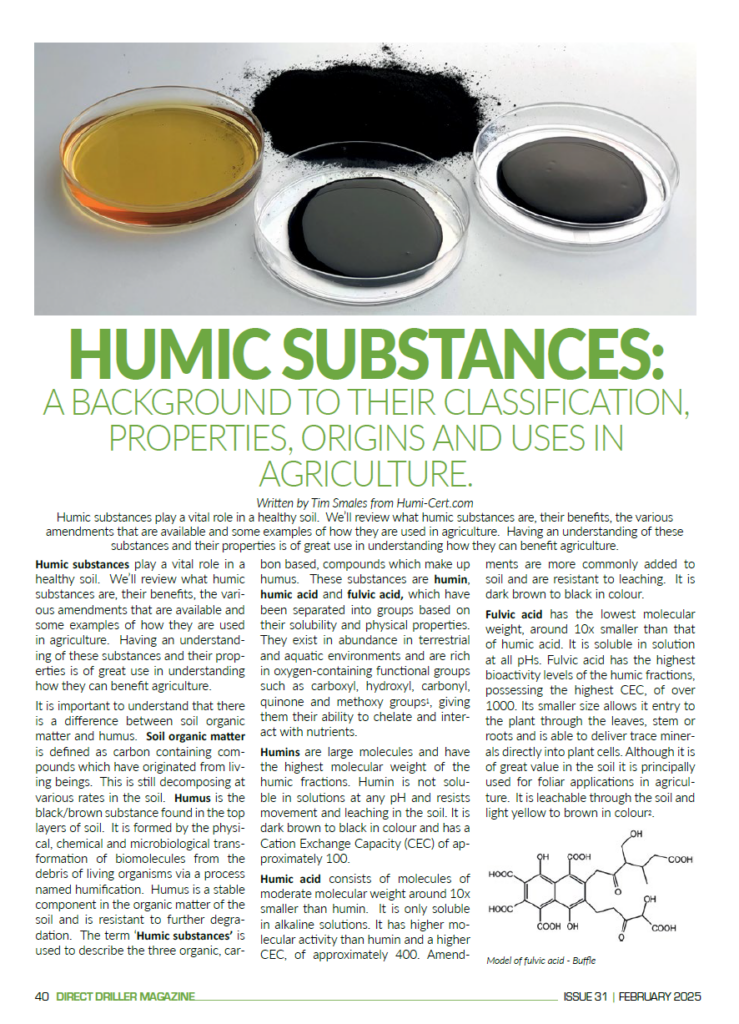
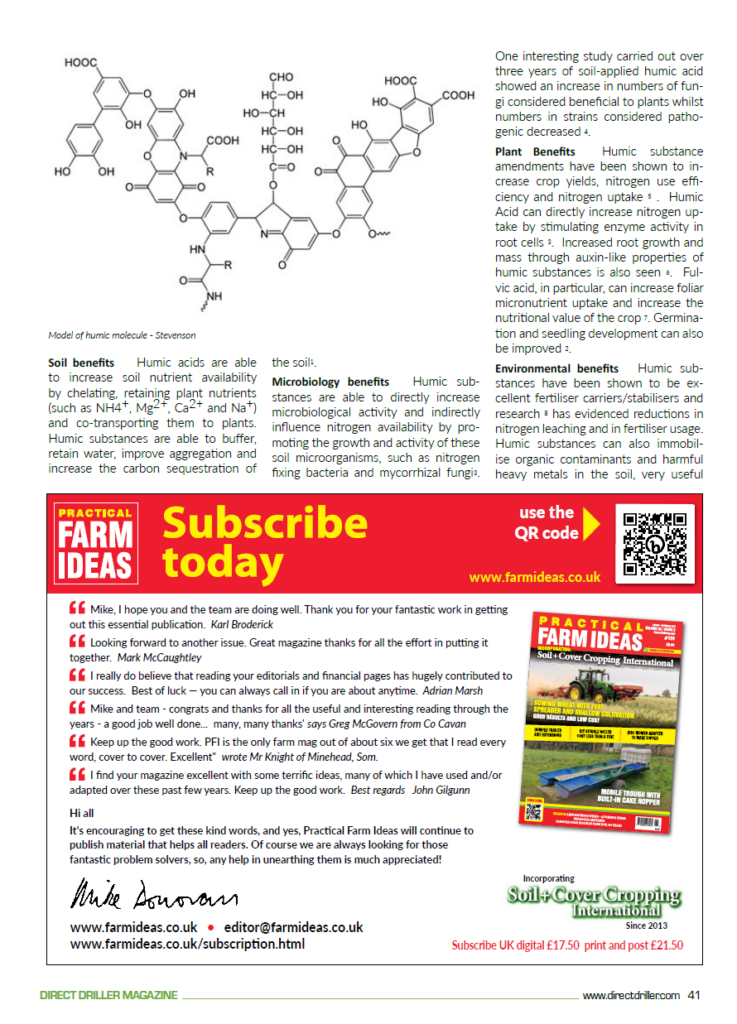
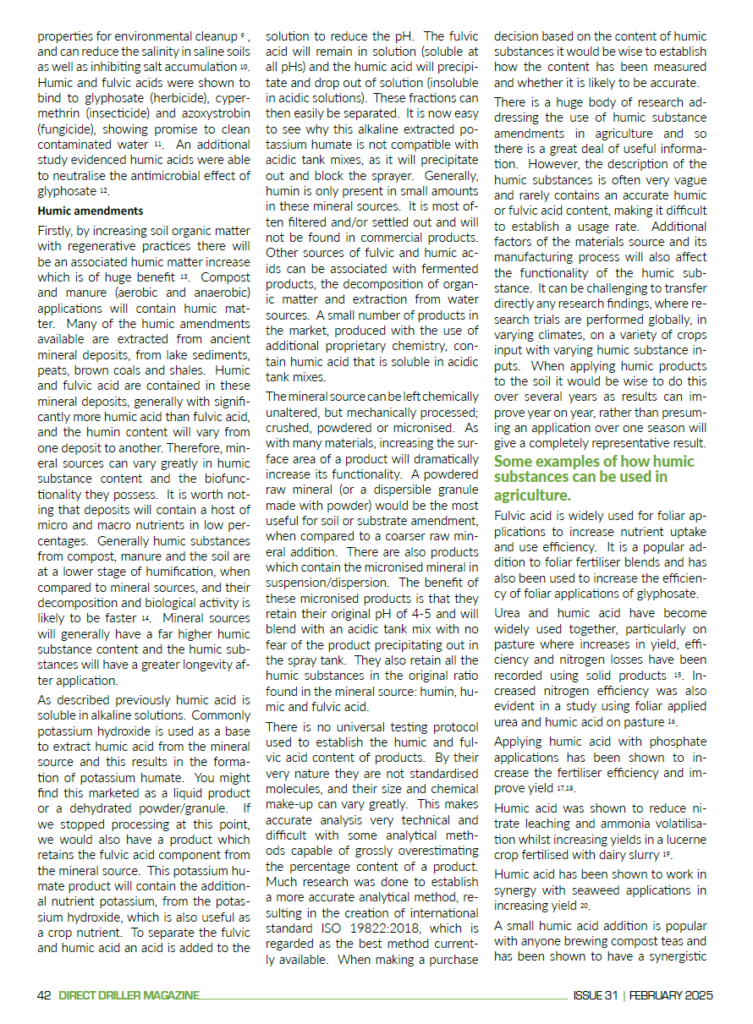
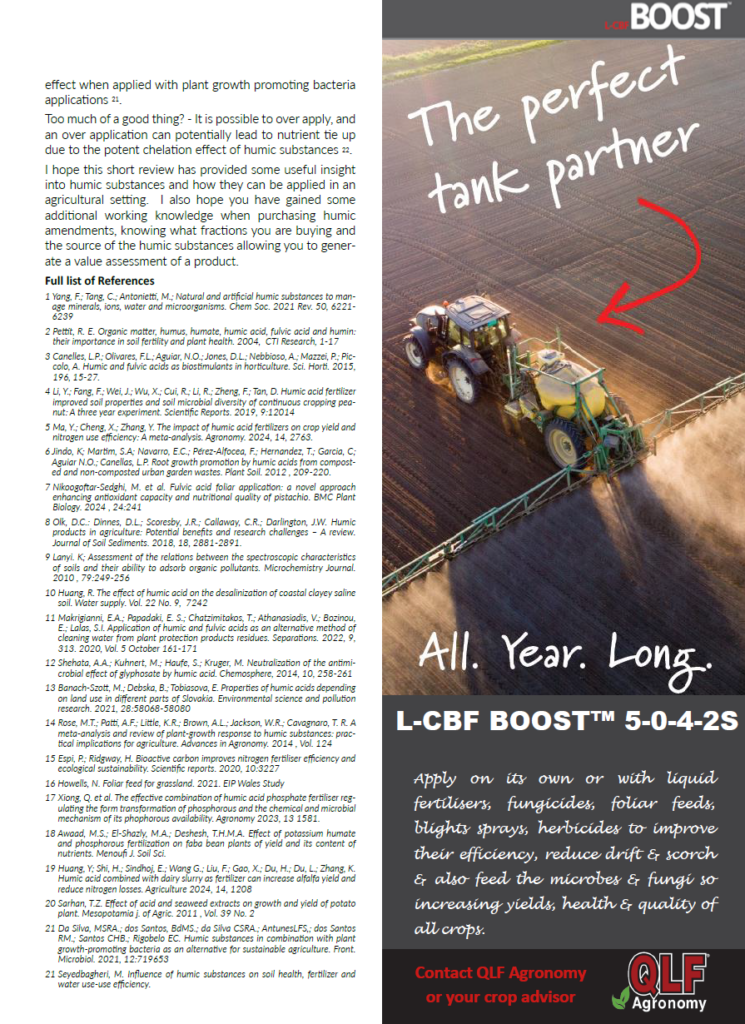
-

Plan ahead to get the most from soil sampling
Soil sampling is an essential tool in understanding the nutrient availability of soils, but unless the results are interpreted correctly it could be a wasted exercise.
That’s according to Simon Francis, Technical and Services Manager for ProCam, who explains that not only is soil sampling required for farm assurance compliance purposes and to meet the statutory requirements of an increasing number of SFI schemes, but it is also time well invested in ensuring crops can perform to their full potential.
Unless soils are sampled and tested in a timely and accurate manner, and the results interpreted appropriately by an experienced agronomist, it is unlikely the investment in soil sampling will generate a viable return.
Sampling prior to sowing any crop is key, as it provides an essential opportunity for growers to assess the nutrient status of soils and to make plans to redress any identified imbalances or deficiencies.

Soil sampling is an essential tool in understanding the nutrient availability of soils, but it could be a wasted exercise unless the results are interpreted correctly explains Simon Francis. Each field should be tested at least every 4-5 years. Some growers might elect to sample more frequently, but there’s generally no need to unless there’s a specific reason such as a change of cropping or land use.
That said, in extreme cases, for example where continuous high rainfall or an extended period of waterlogging has caused nutrient stores to be depleted due to leaching, increasing the frequency of testing could prove useful. Another example could be where a lack of organic matter prevents nutrients from being retained thus causing leaching losses to be exacerbated.
Water logging will also compromise root development in the establishing crop, affecting its ability to access nutrients. Understanding what is available to the crop during the early stages of development is therefore vital to maximise potential.
Irrespective of the soil type, the very least growers should be doing it to test each field to build a basic picture of the farm’s P, K and Mg indices as well as pH and organic matter: testing organic matter content can provide a good indicator of general soil health, from which it is possible to begin to understand the soils capacity to retain both moisture and nutrients.
Beyond this, the next step is to build a more comprehensive understanding of the macro and micronutrients available to plants, so that a tailored nutrient programme can be drawn up proactively rather than reactively during the season.

Soil sampling is essential to maximise the performance of new crops, with ProCam’s SoilSense service taking testing to the next level step by analysing not only the chemical composition of soil, but also the wider availability of macro-nutrients. ProCam’s SoilSense service takes soil testing to this next level step by analysing not only the chemical composition of soil, but also the wider availability of micro- and macro-nutrients[RA1] .
SoilSense also provides an in-depth picture of physical soil health and an advanced understanding of other key indices such as soil carbon, cation exchange capacity and structure.
Armed with this level of detail, growers will not only remain compliant with the basic crop assurance requirements plus any additional information required by the various SFI schemes, but will also be able to work with their agronomist to develop a clear and detailed nutrient programme that ensures each crop in the rotation has access to the full complement of nutrients required to enable them to reach their full potential.
For growers who want to take things even further, an analysis of the soil’s biological constituents including protozoa, mycorrhiza and saprophyte populations as well as positive and negative bacteria population dynamics can be assessed to give a full appreciation of the soil’s health.
For further information about SoilSense visit procam.co.uk or contact your local ProCam agronomist or local ProCam depot or e-mail soilsense@procam.co.uk.
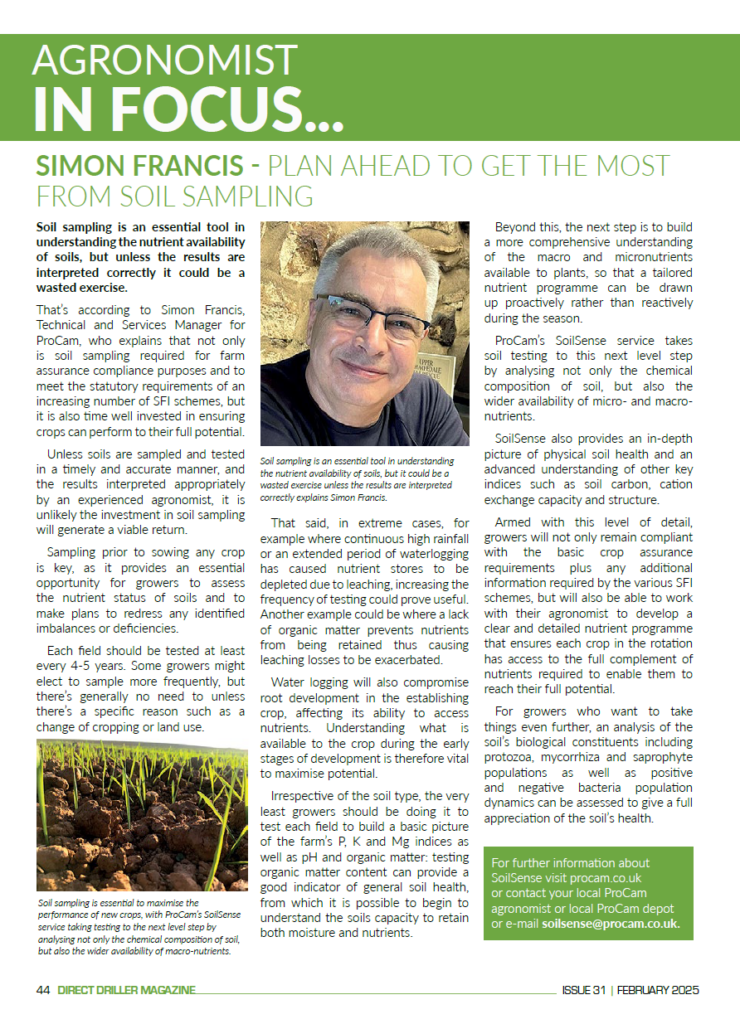
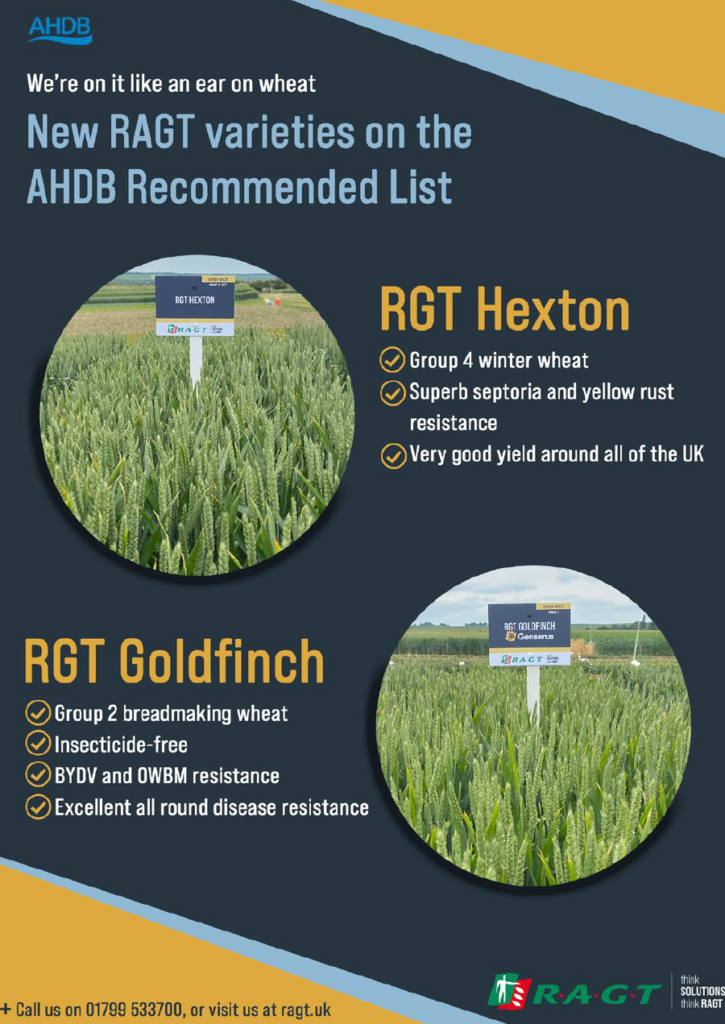
-
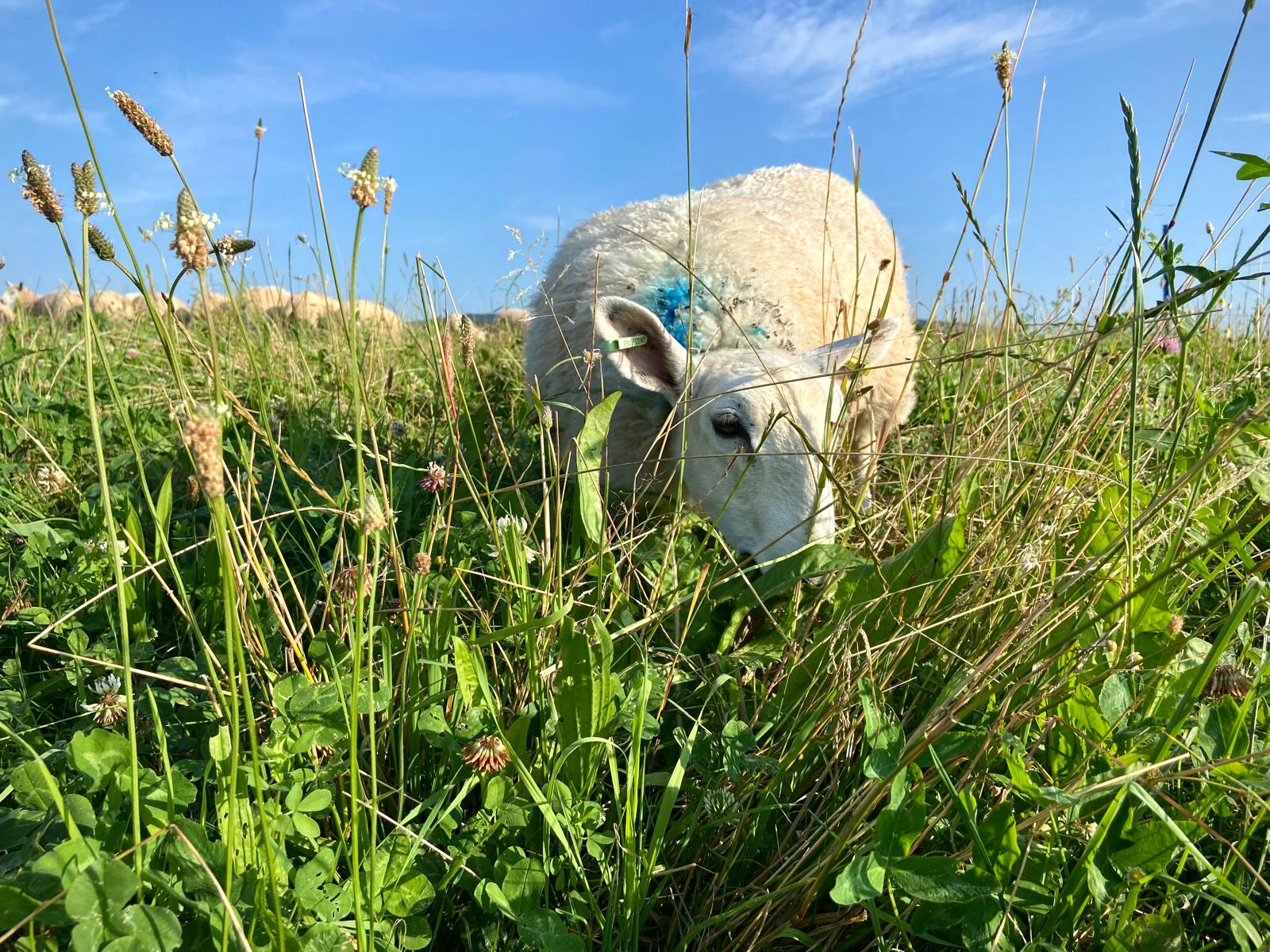
Farmer Focus – Billy Lewis
Dec 2024
Another tough year of compromises, setbacks and stress, all as a direct result of the not-so-great British weather. The lack of sunlight throughout the year coupled with the continuous and unprecedented rainfall events that we’ve been receiving really has made for a hard time, especially on the arable side of the business.
Over the past couple of years, we’ve managed to get decent catch crops established straight after harvest and had some great success direct drilling the following cereals straight in ‘on the green’. However, much to my displeasure we didn’t get a whole lot of that done this autumn, and the plough had to come out in all of its glory. A very late harvest coupled with the need for a considerable amount of remedial cultivations meant that agronomically and economically inverting the soil was the correct thing to do in a lot of places. I was delighted when the first furrows came over in a wheat stubble to reveal a soil that was in beautiful condition. It was very reassuring to see the effects of the direct drilling, grazed cover crops, compost applications and companion cropping that had been carried out on that block of land over the previous three seasons. The oats that are now growing there look absolutely stunning.
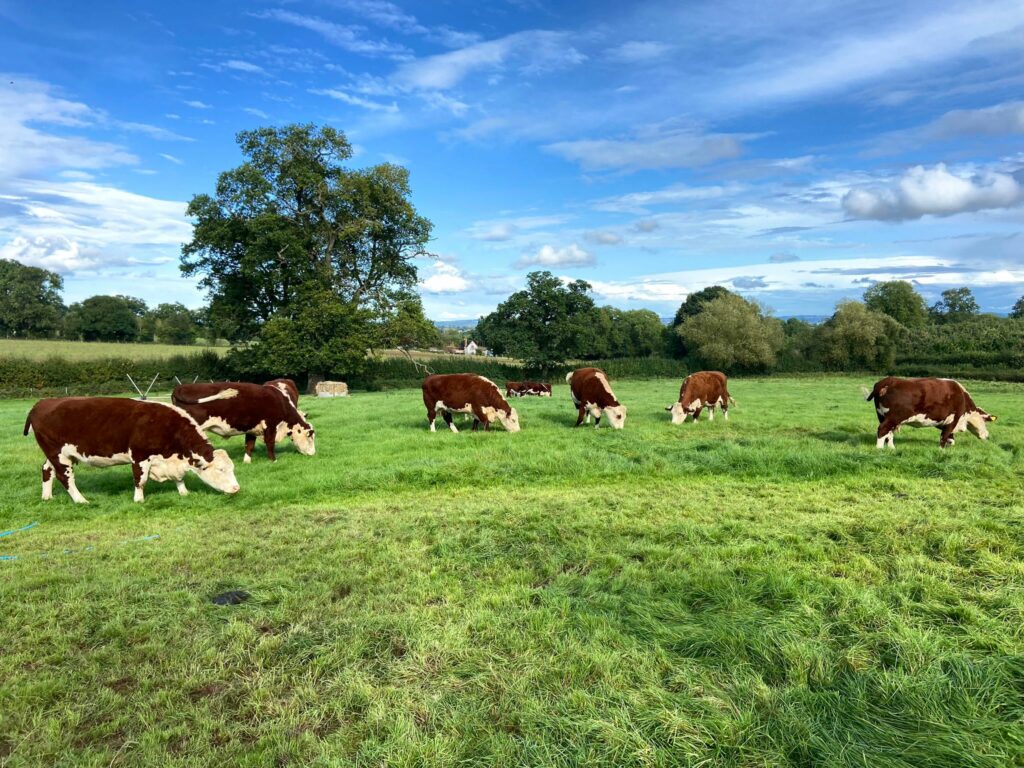
Rotational grazing We did manage to get some winter wheat direct drilled. This went into land that was summer cover cropped in place of spring beans. Conditions were too wet in the spring and time was ticking on so I decided against putting the beans in the ground, a decision I don’t have any regret about given the equally damp conditions at harvest time. The wheat is now sitting pretty amongst a sea of volunteer summer cover crop species, these will be taken out with a cheap herbicide in the spring. Typhoon is the variety of choice for this year. A feed wheat which in theory should be high yielding and have a very good resistance to disease. This will hopefully help us in our ongoing quest to continue cutting pesticide use. If I like what I see I will make sure to get it planted a lot earlier than mid-October next autumn, as it is has been very slow to get going.
The long-term economics of cereal production in this country are a great concern of mine, as I’m sure they will be for every grower currently. Hopefully our low input, dynamic system will stand us in reasonable stead to take on the weather, uninspiring markets and ever-increasing costs. Thankfully livestock production is proving slightly less of a challenge at the moment. Continuing strong markets for beef and lamb are helping confidence levels in the sector.
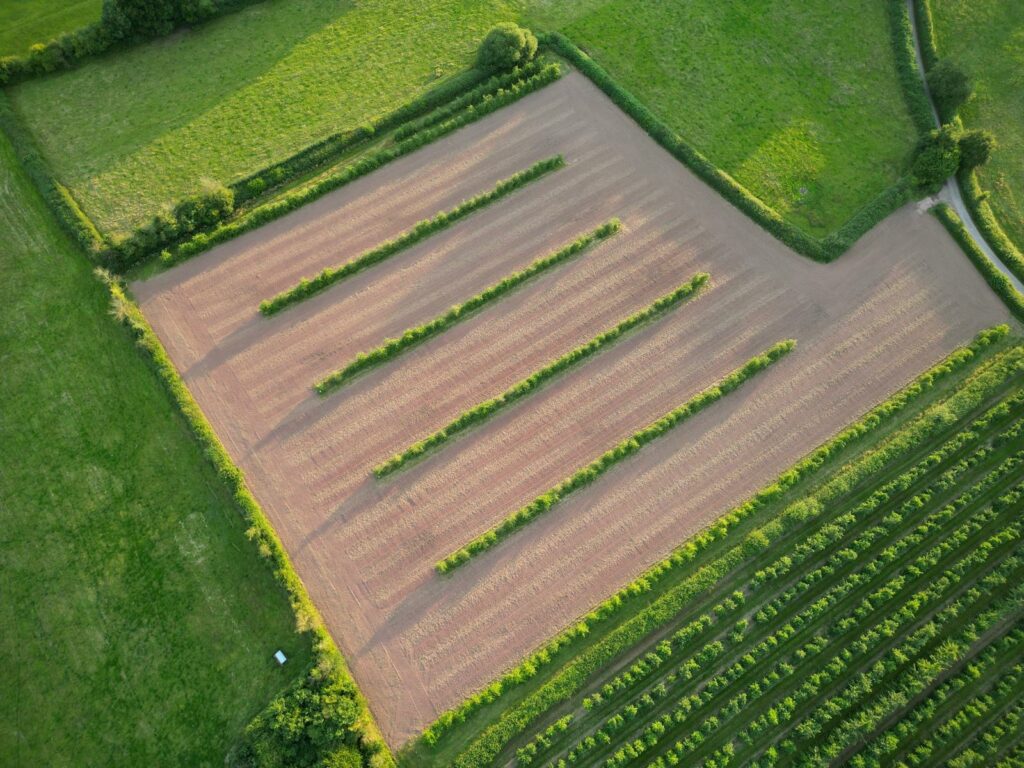
Alley Cropping from above I hate to keep coming back to it but the rain caused issues in the spring. Lambing was seriously hard work and it was only by mid-April we were able to turn all of the cattle out. This is a month later than we would aim for. The sun did eventually come out and the grass grew, and fast. We had a huge amount ahead of our livestock throughout the summer. The fact there was never any period of drought helps. However, the main reason for the very satisfactory growth, I am sure is our management. We’ve really cracked the art of rotational grazing and the benefits for the soil as well as the livestock are so clear to see. I’ve given up moving sheep every day when they’re grazing grass, cover crops though are a different matter. I don’t think they particularly enjoy being constantly on the move and it takes far too much of my time. I’ve found that twice weekly moves is the sweet spot. Cattle I move every 48 hours when possible.
This year we took a commercial cider orchard that we had previously rented out back in hand as the contract for the apples which were grown in it had come to an end. It’s common place in this scenario to pull all of the trees out and revert the field back to arable cropping. Instead of this we opted to leave around a quarter of the trees in place. By leaving every fifth row of trees untouched we’ve ended up with perfectly spaced 24 metre alleys. I was nervous that the sprayer wouldn’t be able to fit down the rows properly, but as it turns out it fits perfectly so we can now use the field as part of our wider rotation of growing cereal crops as well as grazing livestock. I’m looking forward to the day when there’s a group of Hereford cattle contently grazing a diverse herbal ley amongst rows of apple trees. It doesn’t get much more Herefordshire than that!
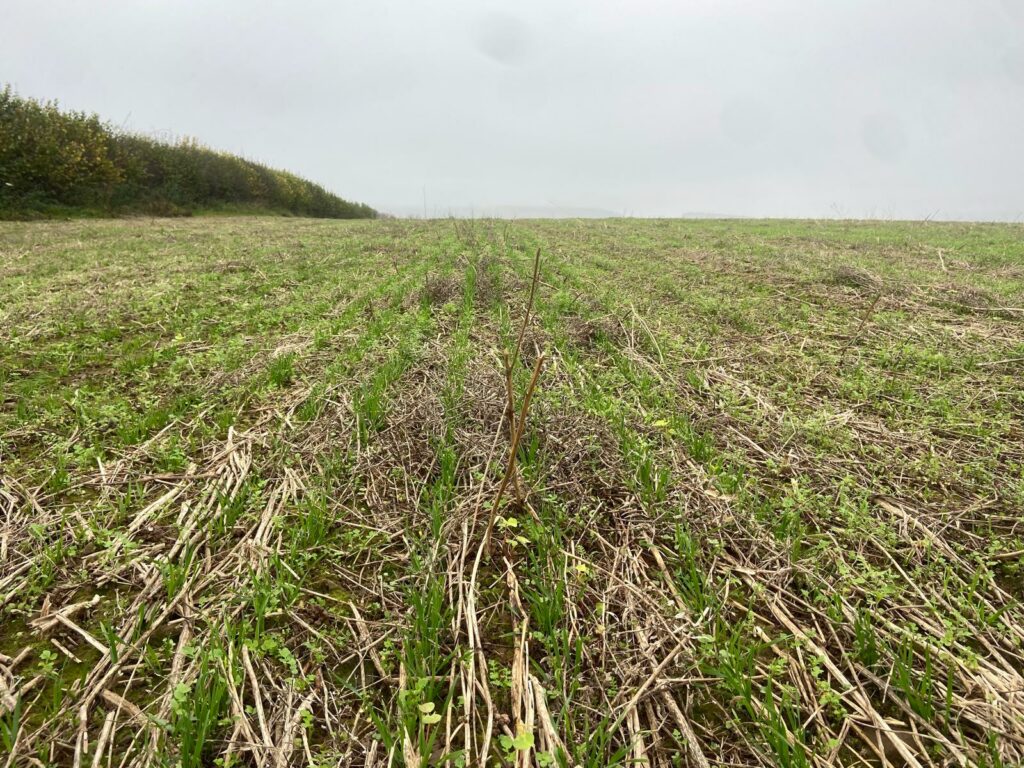
Direct drilled wheat 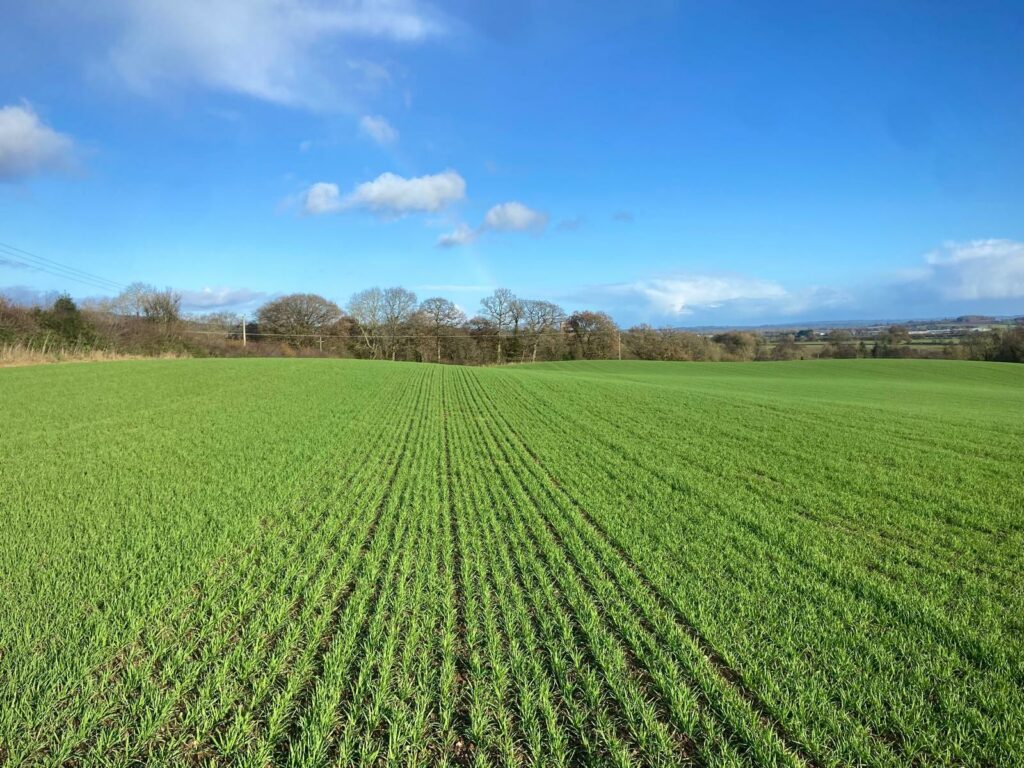
Oats Farm Bio – Billy Lewis farms 140ha in North Herefordshire in partnership with his parents. They keep Hereford cattle, sheep and grow combinable crops. He also contract farms an additional 110ha.
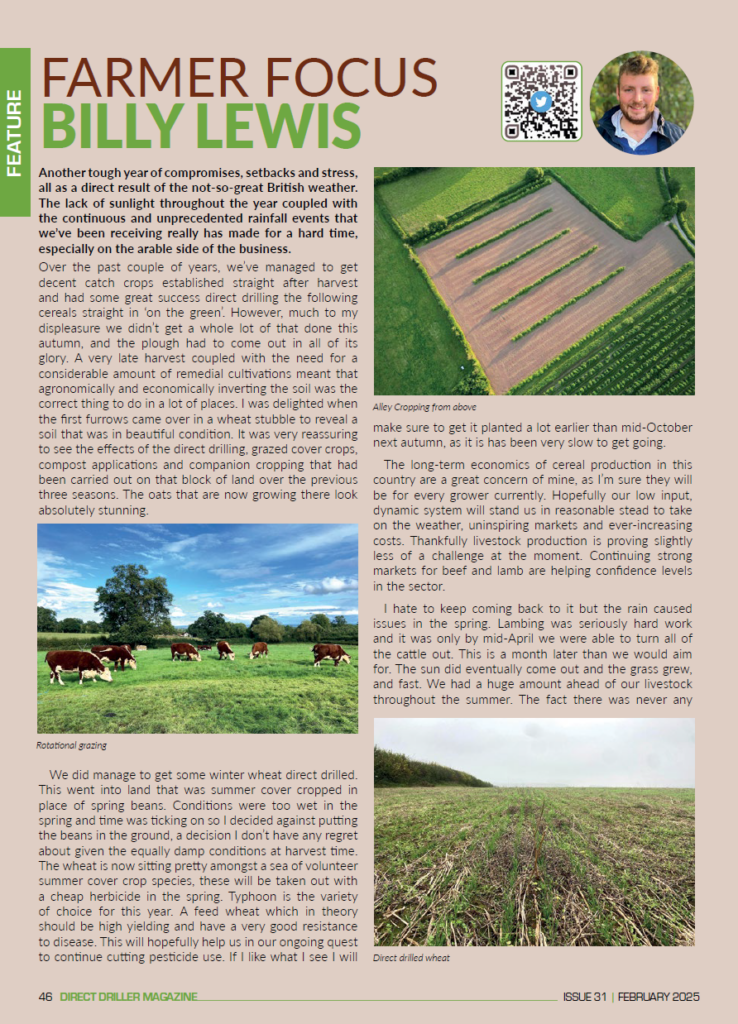
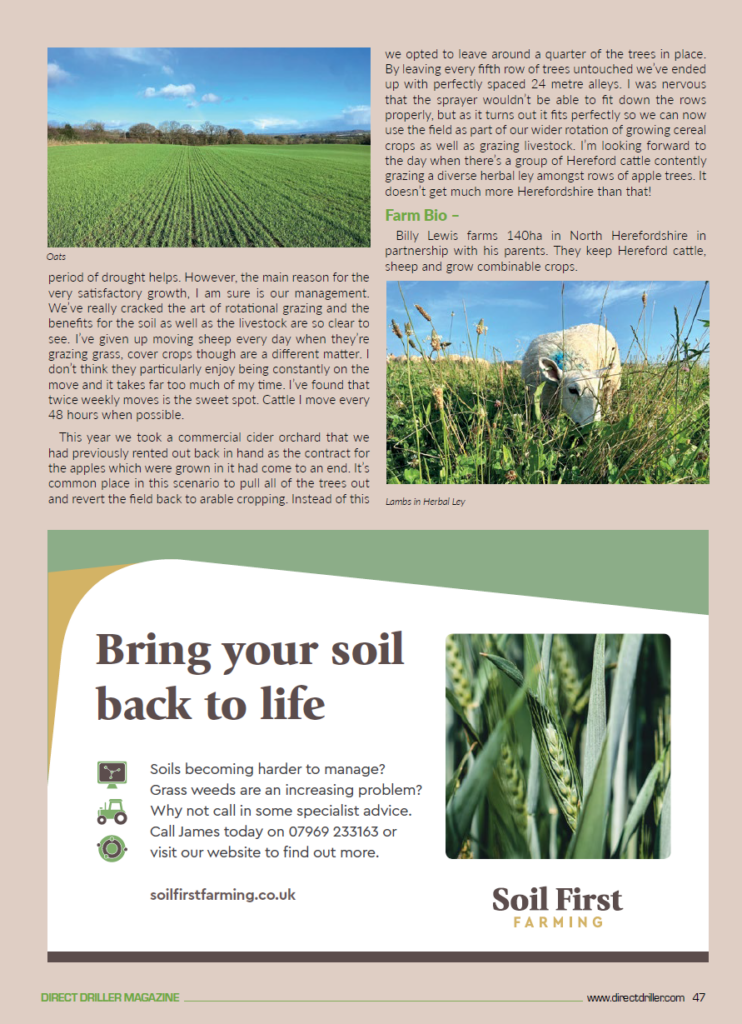
-

Two RAGT wheats gain full UK approval on AHDB’s 2025/26 Recommended List
Breadmaking wheat RGT Goldfinch and soft wheat RGT Hexton made the list after a very strong performance in trials and on farm.
RGT Goldfinch
RGT Goldfinch, the first high quality breadmaking wheat that is resistant to barley yellow dwarf virus and orange wheat blossom midge, has gained full UK approval on AHDB’s 2025/26 Recommended List.
The Group 2 variety is the latest wheat to emerge from RAGT’s Genserus breeding programme, which provides season-long protection against BYDV.
“Using genetics rather than insecticide to prevent BYDV infection greatly simplifies crop management,” says RAGT’s arable technical manager Andrew Creasy.
“It removes the need to monitor and control aphid vectors for less than the cost of buying and applying a single pyrethroid spray, which is good news economically and environmentally.”
Additional resistance to orange wheat blossom midge means RGT Goldfinch growers can apply with confidence for the £45/ha payment under SFI for growing an arable crop without insecticide.
“The variety has good protein content and an excellent and resilient Hagberg score, which, along with encouraging results in provisional milling and baking tests, underlines its potential as a breadmaking wheat,” says Andrew.
RGT Goldfinch has an outstanding foliar disease-resistance profile, better than any other Group 1 or 2 on the Recommended List. It scores 8 for mildew resistance, 9 for both yellow and brown rust resistance and 7 for Septoria tritici resistance.
It is best suited to well-bodied land and can be sown from early September, ideal for a BYDV-resistant variety, to the end of November. It produced very high yields under BYDV pressure in RAGT trials and in commercial situations last season.
“Overall, RGT Goldfinch is a robust wheat that will withstand disease and pest pressure better than most,” says Andrew. “It can be relied upon to deliver high quality grain.”
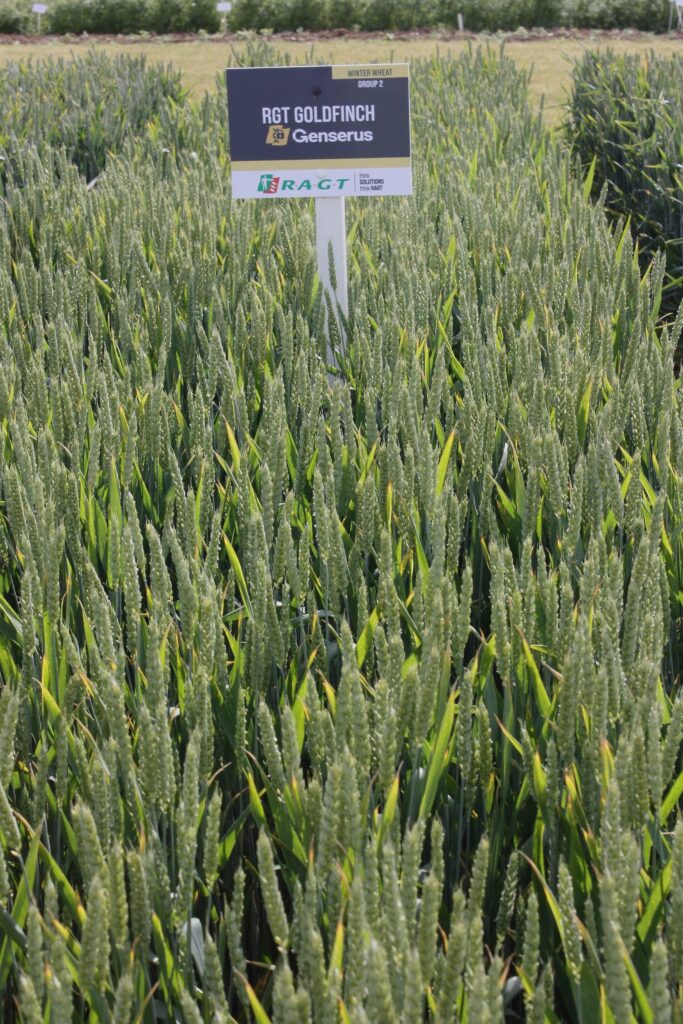
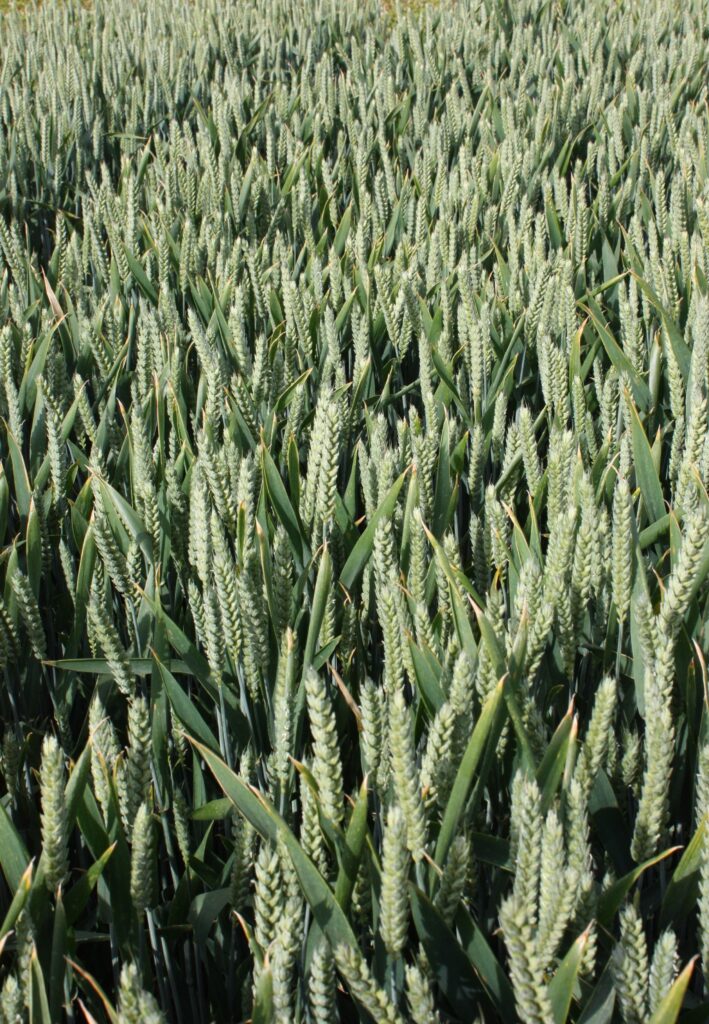
Key Strengths:
- Very strong disease profile
- Clean, consistent, and sustainable
- The UK’s first quality wheat resistant to BYDV and OWBM
RGT Hexton
RGT Hexton is a barn-filling Group 4 soft wheat with a good disease resistance package, making it a strong contender on farm next autumn as growers look to replace older varieties coming under increasing pressure.
This newly recommended variety is the highest yielding Group 4 soft approved for distilling, with a UK yield of 105 and an exceptional 111 in the north.
“RGT Hexton’s output has been consistent wherever it is grown,” says RAGT’s arable technical manager Andrew Creasy. “It produces the goods as a first or second wheat on light or heavy land and can be sown from the last week of September onwards.
“Growers don’t have to worry about pushing harvest back too much, as it is a medium-maturing type with short stiff straw and a decent specific weight, providing useful insurance if harvest is delayed.”
RGT Hexton has good resistance against Septoria tritici and yellow rust (both scored at 7), with a 6 for mildew and 5 for brown rust.
It is also resistant to orange wheat blossom midge, a prerequisite for the increasing number of growers turning away from insecticides.
“We think RGT Hexton will have widespread appeal across the UK,” says Andrew. “The variety has no Achilles heel, and the combination of an exceptional yield and suitability for distilling make it even more attractive for growers in the north.”
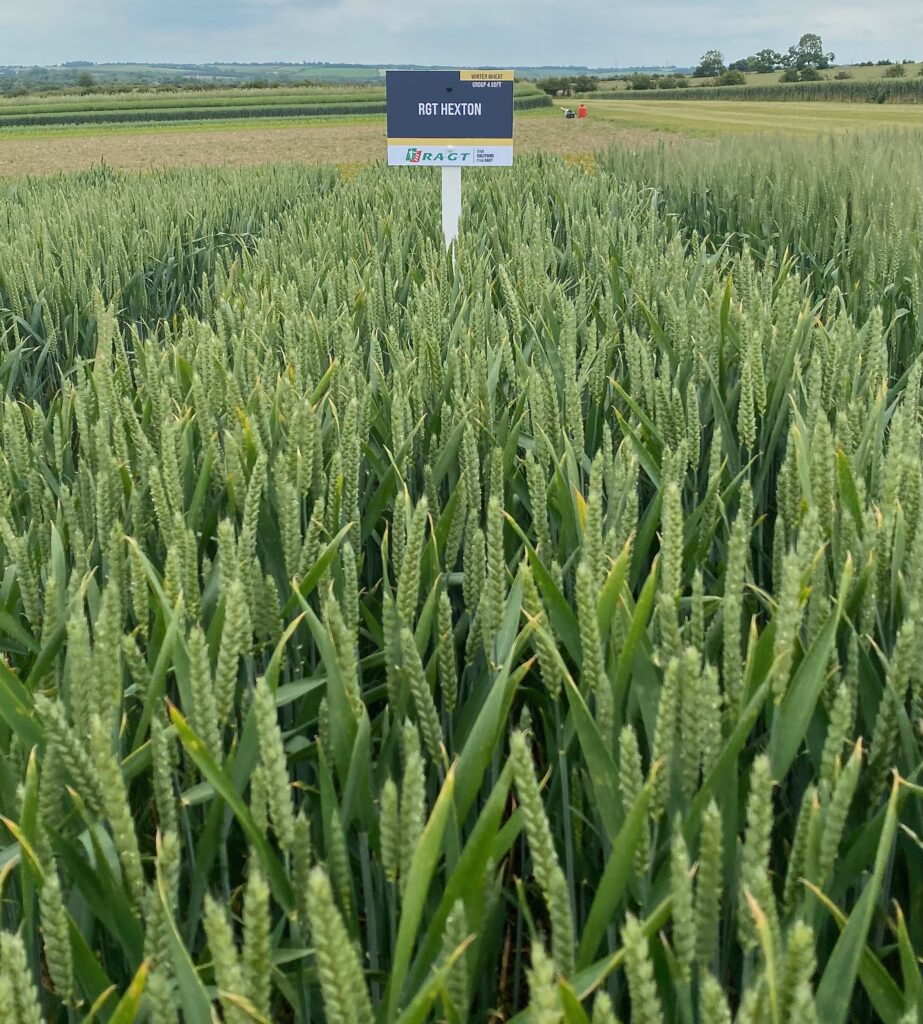
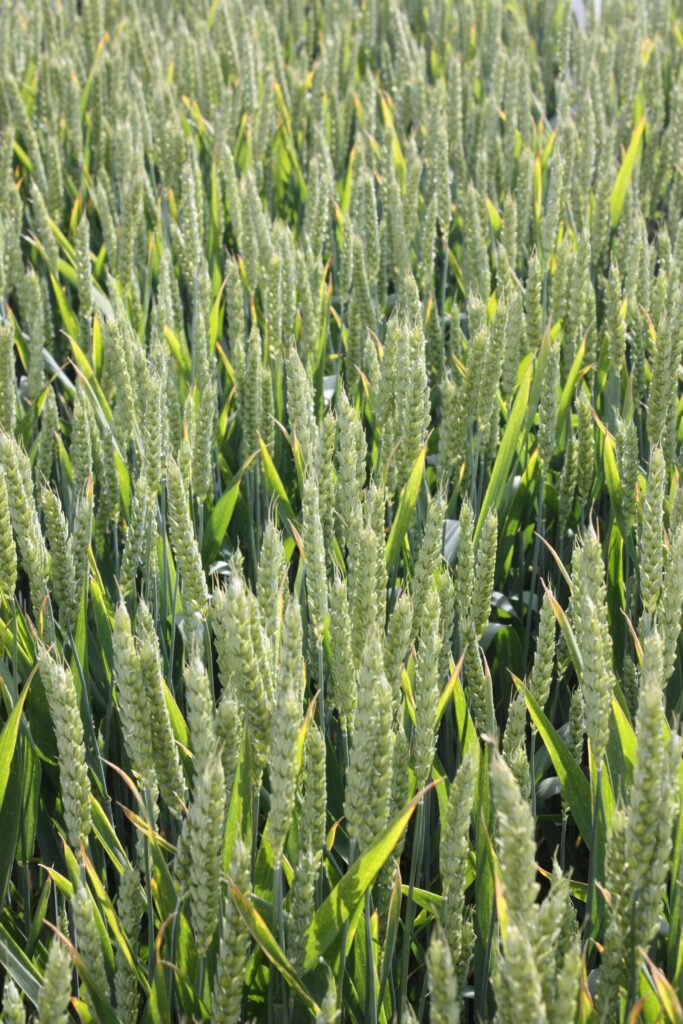
Key strengths
- Consistent across soil types and rotational position
- Very high yields across UK, exceptional in north
- Stiff strawed, good specific weight
- First or second wheat
- Wide sowing window
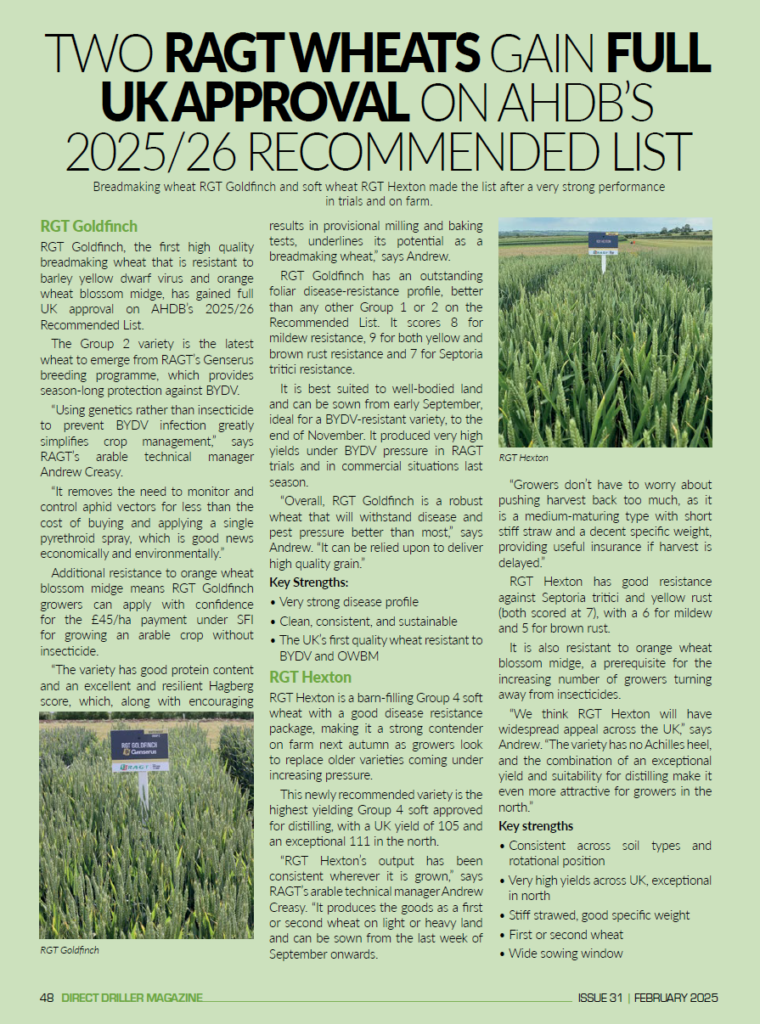

-
Planning for silage success 2025 – using AgTech to fine tune decision making.
Improving quality and producing the right quantity for the animal numbers on farm takes planning and it starts with the soil, test so that you know what you already have on farm in the soil, in the slurry/FYM means than when the conditions are right the correct amount of nutrients can be applied to the grass. Digging a hole to assess compaction coming into Spring and addressing it at the right depth and timing can improve yields by up to 20% and soil health improvements creating resilience through the season, alongside working towards eliminating the causes.
2024 saw low protein levels in grass and silage, low levels of crop nutrition, following extremely high levels of rainfall the season started off with low soil nitrogen, this compounded by the difficulty in applying fertiliser and slurry due to wet ground meant that the season was late starting, although the grass was still growing generally it was poorer quality. To mitigate this having a plan to get some fertiliser and/or slurry out early if it is dry will encourage early growth, fresh grass testing can give a good indication of where the nutrition is alongside walking the fields in February. Having your Nutrient Plan ready to go and deciding on cutting date at this point will mean that you are setting your goals and then when the soil is warm enough to apply nitrogen you can adjust the amount to ensure you are nitrate free by the planned 1st cut date. If using contractors get them booked early as early as possible to take advantage of fast-growing grass in the Spring, getting two cuts in before the end of May will increase the quality of the cuts and whether you are planning 3, 4 or 5 cuts whatever the season brings the energy and protein is banked in the clamp for winter. Multi cut does reap rewards when it comes to increasing quality and quantity of silage and gives more chances to get it right, focussing on ensuring top quality grass silage also has financial benefits. The numbers will be individual to each farm but in every case increasing ME/kg of Dry Matter will improve the bottom line, each mouthful eaten has increased energy density meaning more return on investment from home grown forage, focus on yield of energy per hectare, if the numbers are not where you want them implement change to improve it, whether that’s improving the grass leys to new varieties, preserving the energy in the clamp using a quality silage additive, or changing the maize variety to early harvest early with higher starch.

Using technology to help with decision making at each step of the process backs up application of fertiliser, for example Cordulus weather stations have soil temperature readings so knowing if the timing is right for the first application of Nitrogen and ensuring that the forecast is accurate to your geography is not only better for the crop but also for environmental considerations and reducing waste of valuable resources. The use of accurate data enables decision making on a daily basis to get the most of on-off grazing on the shoulders of the season, maximising every opportunity to graze grass is another way to reduce costs and optimise the resources already available on farm, if the winter is mild and the grass is continuing to grow there is a risk of too much cover in the fields which will reduce quality, on-off grazing will help avoid poaching fields improving the longevity of the sward. With grazed grass still the most cost-effective way to feed animals every quality graze is beneficial to the bottom line, AHDB research says that for a 100 cow suckler herd an extra day at grass is worth an extra day at grass is worth £125 per day, for dairy cows that return goes straight in the tank at reduced cost. Knowing what is in the field can be made easier by using Omega Crop grass prediction tool, this not only gives DM cover per acre but predicts 7 days in advance using grass growth modelling combined with weather so its accurate for your fields daily.
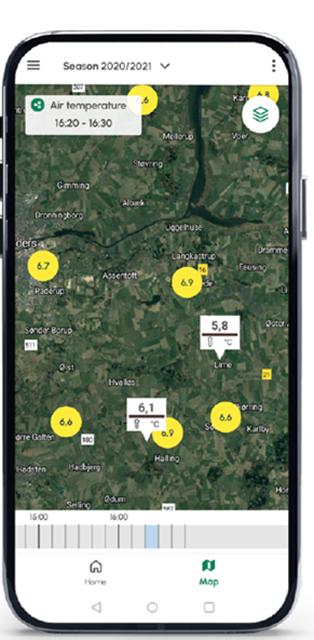
Using data to help decision making on farm gives incremental gains, matching forage quality to nutritional requirements working with and alongside the nutrition team to optimize home grown forage will see improved bottom line, animal health and sustainable crop production, monitor and measure your results after each cut to make any adjustments necessary to ensure results stay on track. With ongoing data collection this will help with reviewing the season and noting what works well on farm and the areas for improvement.
Farmer’s View

Adam and Georgina Roberts of Trye Farm, near Penzance Cornwall supply to Arla and have been using data from both Cordulus weather station and Omega Crop for the last two years, Georgina says ‘it’s just easier to make decisions and its one less thing to think about’ with a grazing based system of 200 cross-bred Holsteins, Norwegian Reds and Jerseys, they aim to graze 11 months of the year and aim for over 60% milk from forage. With a tight autumn block calving system over 222 Hectares it is essential that everything in the system is working optimally and combining the data from accurate weather forecasts which has always been a challenge for their farm previously together with the grazing data its much simpler to make the right decisions quickly. We can move onto the next task and be cow focused knowing they are making the best of resources.
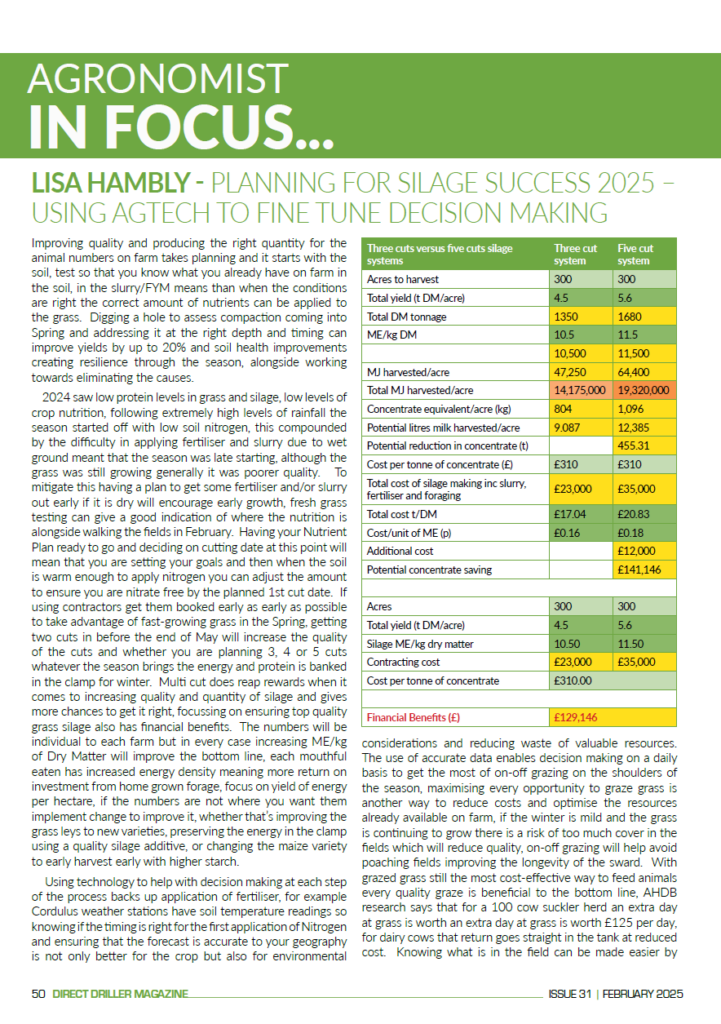
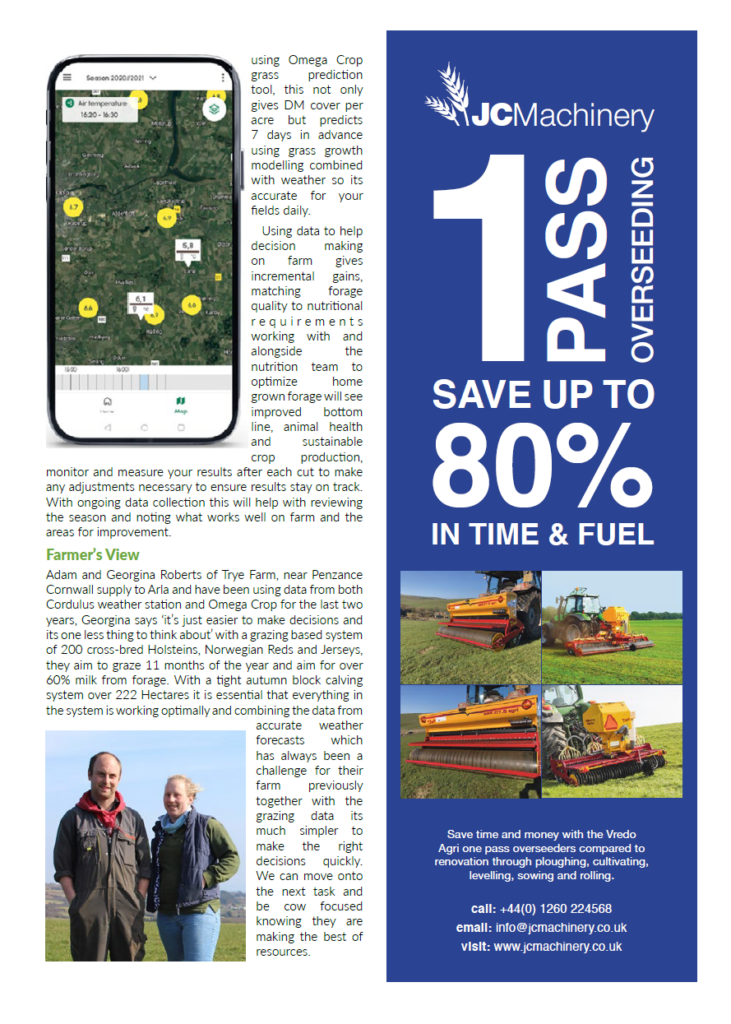
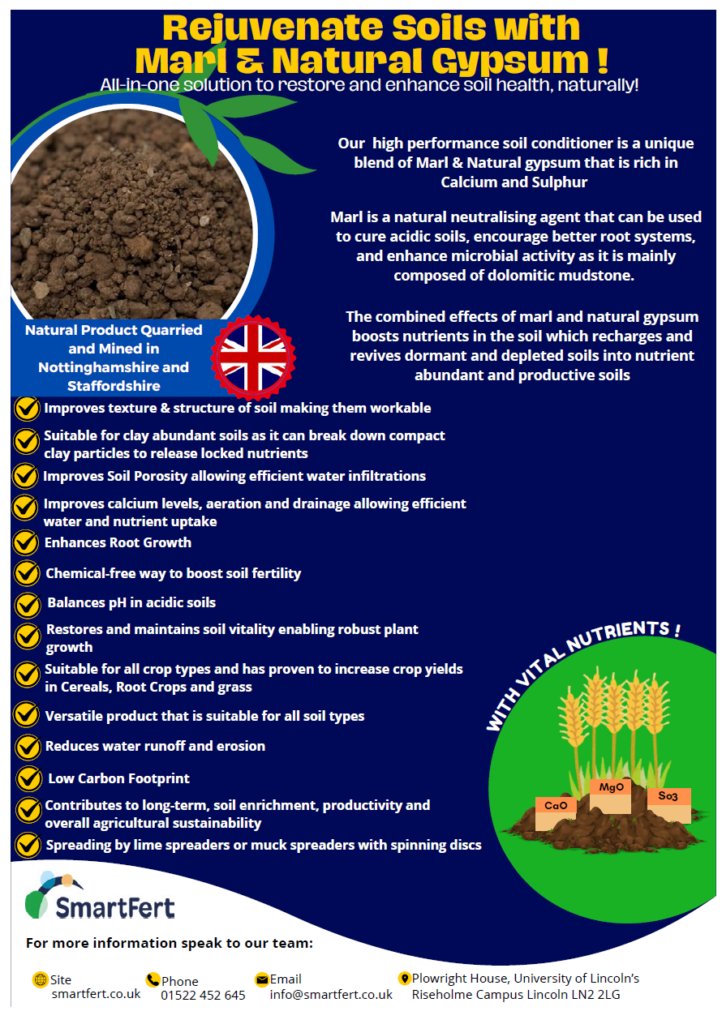
-
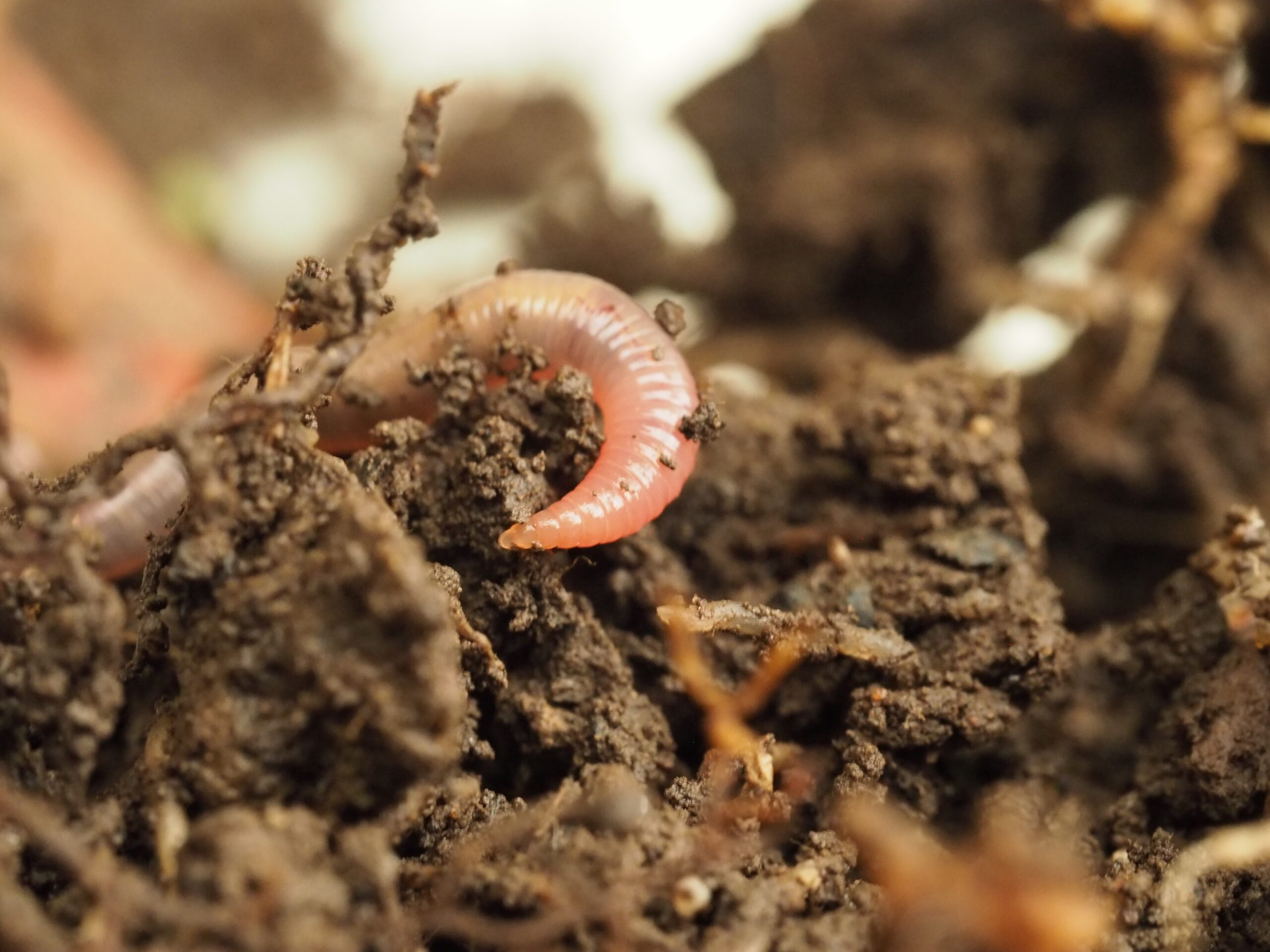
Ecoacoustics – a new underground horizon for soil health
Following on from a farm trial undertaken by Andy Cato’s Wildfarmed farms, (as mentioned in our Farmer Profile issue Nov’ 24) we’re drilling down (pardon the pun) into the technology behind a new technique for measuring soil health – ecoacoustics.
Ecoacoustics is an emerging science which investigates natural and anthropogenic sounds and their relationship with the environment. Ecoacoustics has been used as an ecology tool for decades in the marine environment and now more recently for recording bats and birds and other above-ground wildlife. As the technology has developed and become cheaper, Baker Consultants, along with a small group of like-minded researchers and soundscape artists around the world, saw the potential to apply this method to the soil.
Winning a DEFRA Farm Improvement programme grant in 2022 with University of Warwick Crop Centre, Baker Consultants embarked on a research project to determine whether this technology could be used commercially to assess earthworm populations, instead of just using more traditional methods, such as digging worm pits. The study has discovered that the diversity of soil invertebrates can be measured using ecoacoustics, and is also usefully paired with existing methodologies for assessing above-ground biodiversity using soundscape recordings.
The premise being ‘A healthy soil is a noisy soil’ was born, and large-scale farm trials were undertaken to gather data from the full range of geologies and soil types, on arable, pastural farms, vineyards and agro-forestry, as well as those under regenerative management practices.
As well as a sample of Wildfarmed farms, organisations including Rothemsted, The National Trust, Yeo Valley & Ruinart Vineyards have been part of the trial and have contributed to amassing a large database of thousands of soil-sound files. This has been used to develop a brand-new Soil Acoustic Quality Index (SAQI) score system, against which each new recording can be compared. This score will be able to show farmers how the acoustic diversity of your soils compares to the rest of the UK and allow you to target the areas most in need of help, or track changes in the soil, following different interventions. The soil database & acoustic analysis is AI-driven and the service will be supported by automated reporting, with each sample generating a dedicated SAQI scorecard.
This month, in time for World Soil Day, a hand-held device has been launched for farmers and agronomists to start recording their own soils and creating baseline scores for their fields. Regenerative farmers are often the first to adopt new technologies and the importance of baseline data is recognised as a key step to changing farming practices effectively. Knowing the effect of certain inputs and being able to take recordings before and after treatments will cut down the ‘guesswork’ element.
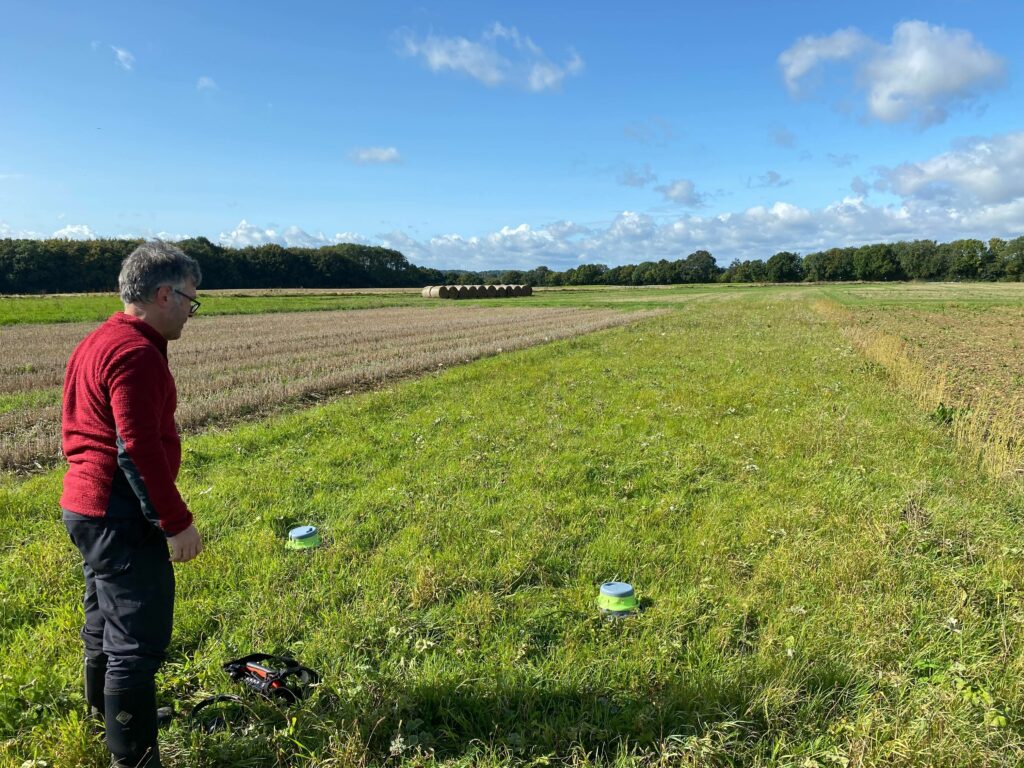
Rob Bray, People & Sustainability at Wildfarmed, said “At Wildfarmed we see the difference when farmers transition to regenerative farming, with more birds, bugs and bees in their fields through the introduction of pollinating flowers amongst our arable crops. Wildfarmed grows food in a nature-friendly way that’s better for you and the planet. We can’t know what ‘nature friendly’ means unless we can measure it. It’s been fascinating to work with Baker Consultants to understand better what is happening below ground and start to quantify the benefits of our approach.
The SAQI reporting will be run through a subscription service and the Soil Acoustic Meter scorecard system has been designed to align with the same approach taken in the current AHDB Soil Health Scorecard system. Collaborations with other standard data collection portals are also in the pipeline, so that this data can be viewed alongside other soil metrics, such as organic carbon. The new Sustainable Farm Incentive also includes a soil management plan payment, and it is hoped that soil acoustics will soon be able to support the monitoring methods that can be used for demonstrating compliance with this SFI scheme.
Soil Acoustics Ltd has launched a Kickstarter campaign this month (which is a type of crowdfunding) to fund the production of this new hardware and enable it to get it to market in Summer 2025. To sign up as an early-adopter and get unlimited data uploads for the first 12-months, go to their Kickstarter link here: https://www.kickstarter.com/projects/soilacoustics/sam-the-ecoacoustic-device-for-listening-to-your-soil
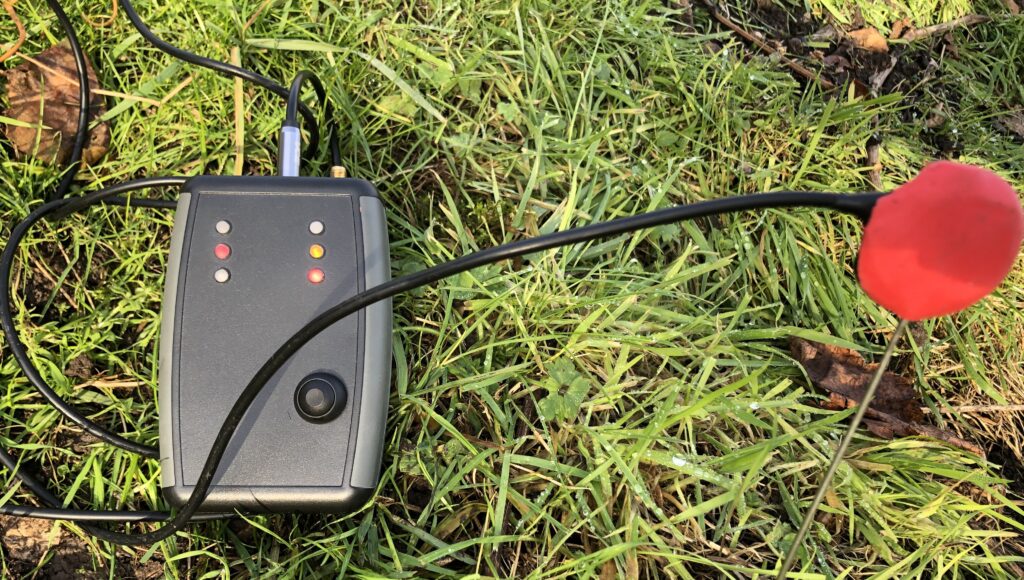
A multi-buy deal is also available for agronomists and farm advisers with multiple sites to manage.
Gavin Ward, Director at Soil Acoustics Ltd says “We are excited to see this technology enable land managers to track how their topsoil invertebrates respond to both environmental events and their own farming interventions. By monitoring how these communities respond, these rapid and cost-effective insights will hopefully help famers to optimise the timing of their activities, so that the resilience, productivity and overall health of their soil is improved.”
For more information on soil acoustics email ecoacoustics@bakerconsultants.co.uk or visit: www.soilacoustics.com
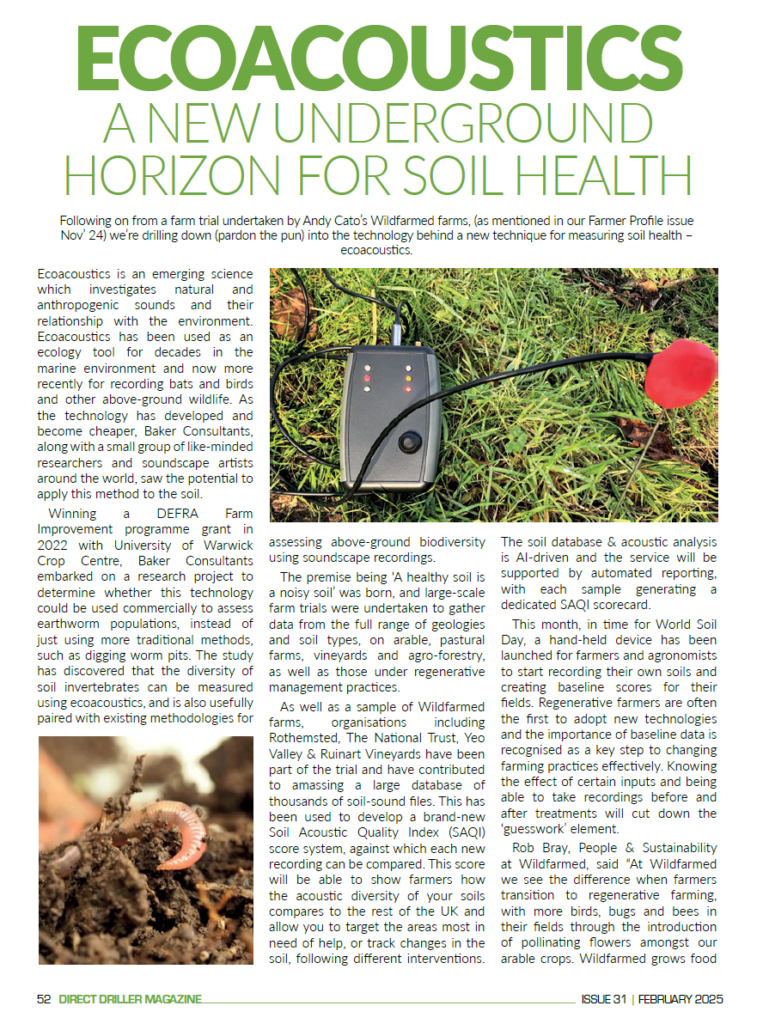
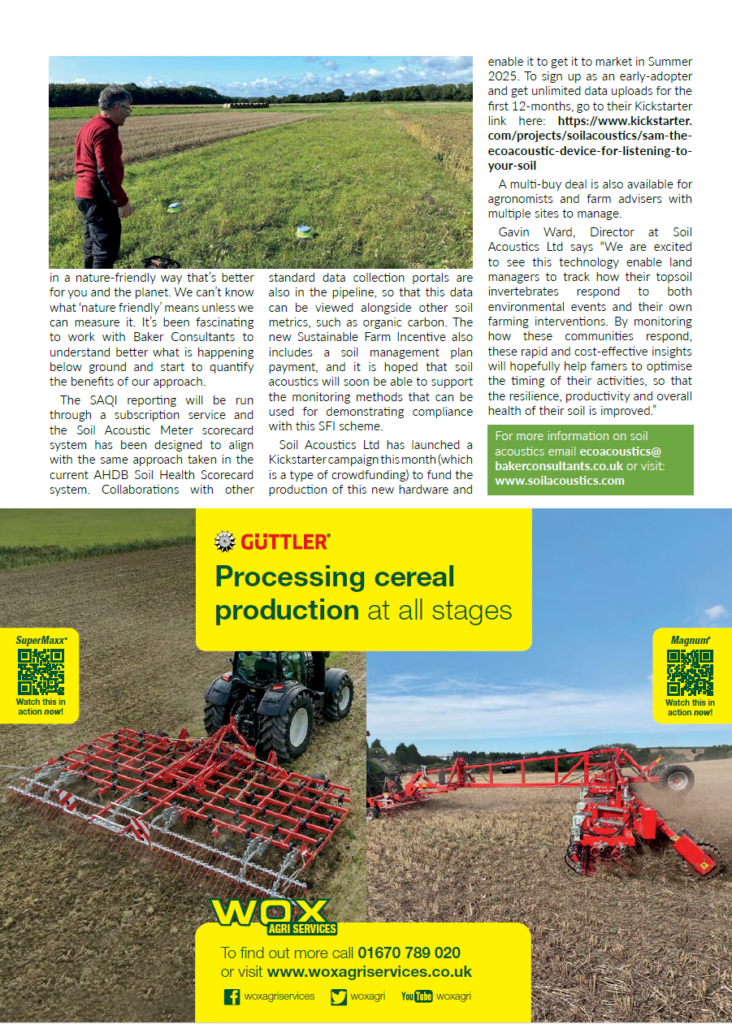
-
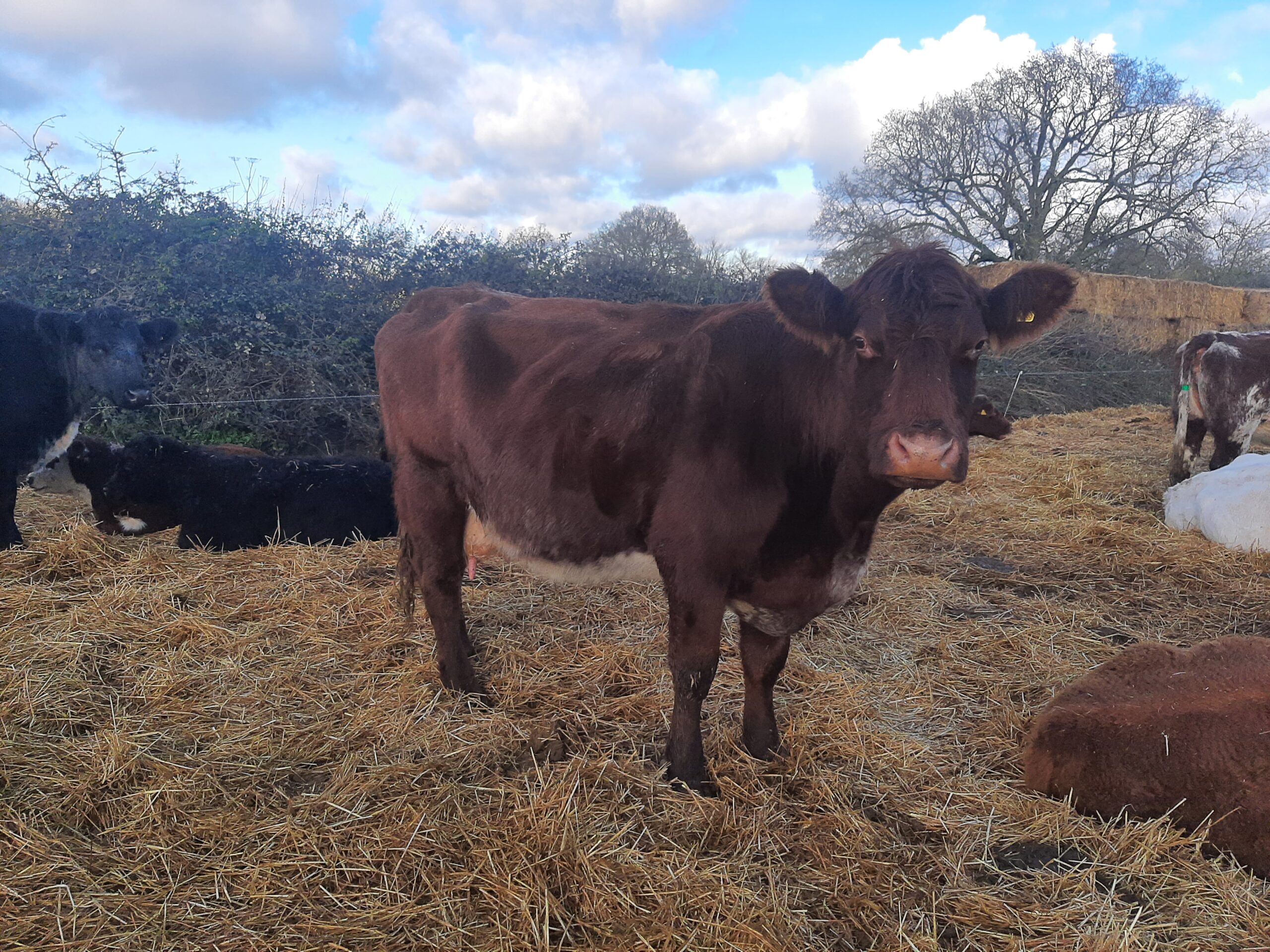
Farmer Focus – John Cherry
Well, 2024 was a bit rubbish on the farm. We didn’t get all our planned cash crops planted, either autumn 2023 or spring 2024 and some of our summer cover crops (grown instead of profitless break crops) were disappointing, to say the least. The spring linseed was a bit patchy too, but the weather ensured that we’d never get round to harvesting it…eventually, come a relatively dry spell in November, we just cut some wheat into the standing linseed. I thought the seed in the pods was going mouldy and won’t be worth the hassle of cutting and cleaning. As it turned out, quite a bit has germinated but most has fed the big flocks of finches etc that are cleaning the place up. I’m also pleased, though it may sound surprising, to see large flocks of pigeons grazing away on the linseed cotyledons. Having given up trying to grow oilseed rape, I’ve become much calmer about seeing pigeons. They are doing a great job pruning back the small-leaved clover that is meant to be an understory for some of our Wildfarmed wheat. We got the cattle to graze it down hard before we drilled the wheat with the Weaving GD (we tried the Horsch CO but it dragged too much of the living mulch up), but the clover came back fast with the mild autumn. The wheat has all emerged nicely and is much happier now the clover is getting the pigeon haircut.
It might be that I’m getting old, but I found that trying to manage 1000 hectares regeneratively was getting too much. Getting old also means getting serious about succession planning, so Paul and I are attempting to split the farm in half so our children can do their own things on their own patch without having to consult cousins. It turns out that it’s not that straightforward of course and the budget has stirred things up further so I can see that the professional fees column in the accounts is going to be bulging.
I know that there are several people on here who can manage far more acres successfully and all that I can say is that they are cleverer than me. We are going ahead and farming our own halves anyway and it will help us ascertain what works best on our land. Paul stirred things up for the neighbours by parking a plough in his yard. He had a couple of fields that he reckoned needed a reset so the plough went in. I must say, after 14 years of no-till, it turned over lovely and the wheat went in beautifully and is zooming away with all that mineralised N.
We got all our drilling done on our half (no-till), despite it being slightly later than intended and everything has come up nicely. The ground is in good nick on the whole, despite a wet year with not enough cover. I’m confident that we’ve learnt valuable lessons about getting on with increasingly unpredictable weather. Herbal leys are a joy, especially now there’s government money in them and the beef price climbs skyward, I’m tempted to increase cattle numbers and plant more.
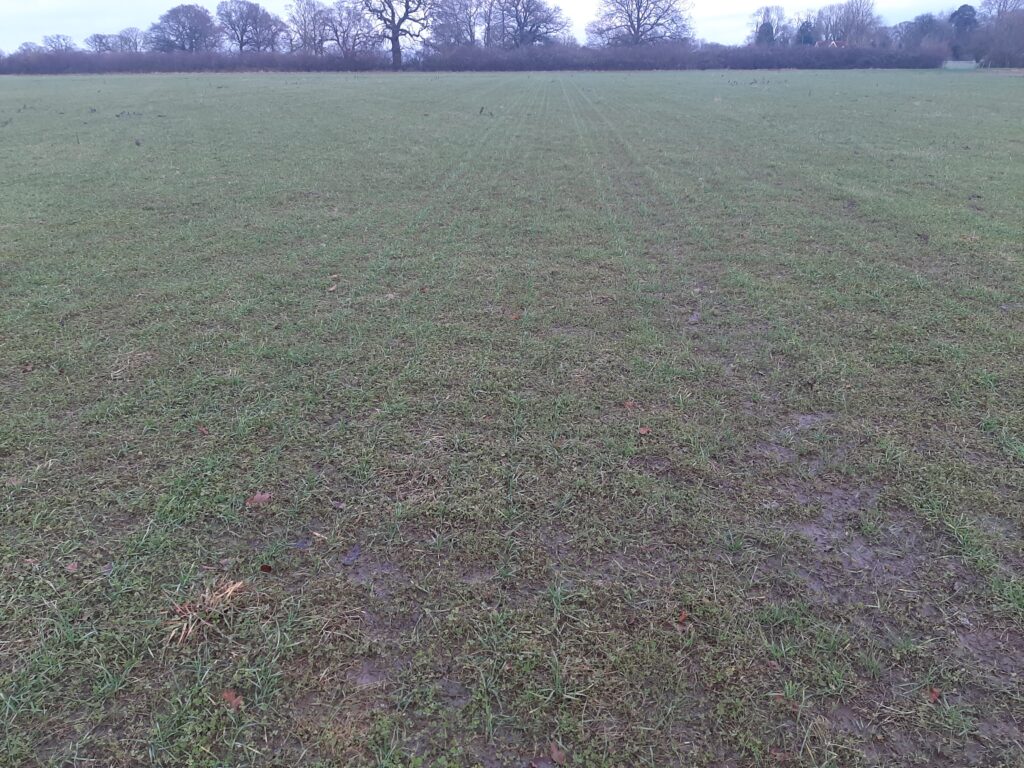
We’ve just pregnancy tested the cows and, it turns out, next year won’t be a number boosting year. I thought I’d tighten up the calving by taking the bulls out a couple of weeks early (I know this is Direct Driller magazine so I shouldn’t be talking about animals, but seriously, it isn’t that hard to run some cattle and it makes life much more interesting). As a result we will lose a few more cows than I planned and half the new heifers we added didn’t take, so the herd will stay much the same size.
There are some real old friends amongst the culls, our oldest cow at 15 has thrown in the towel. We’ve had 13 calves off her and now she’s off to cow heaven, with 7 others, 12, 13 and 14 year olds and a couple of younger ones. The pastures are still quite soggy, so we’ve brought them onto the outdoor corral where they’ll now stay until it dries up a bit. The culls are going in the morning, so I went out and had a quiet word with them to thank them for their hard work. They took the news kindly but I still feel dreadful!
Joanna has been on a Listening to the Land course and is backing me up on this business of talking to the animals. Although apparently I should go further and talk to the fields and find out what they are thinking. This makes perfect sense to me, but I think I need a bit of practice. Anyway, we’re planning a one day course on 1st July, just before Groundswell in case any of you out there wants to tune into the subtle energies dancing under your feet.
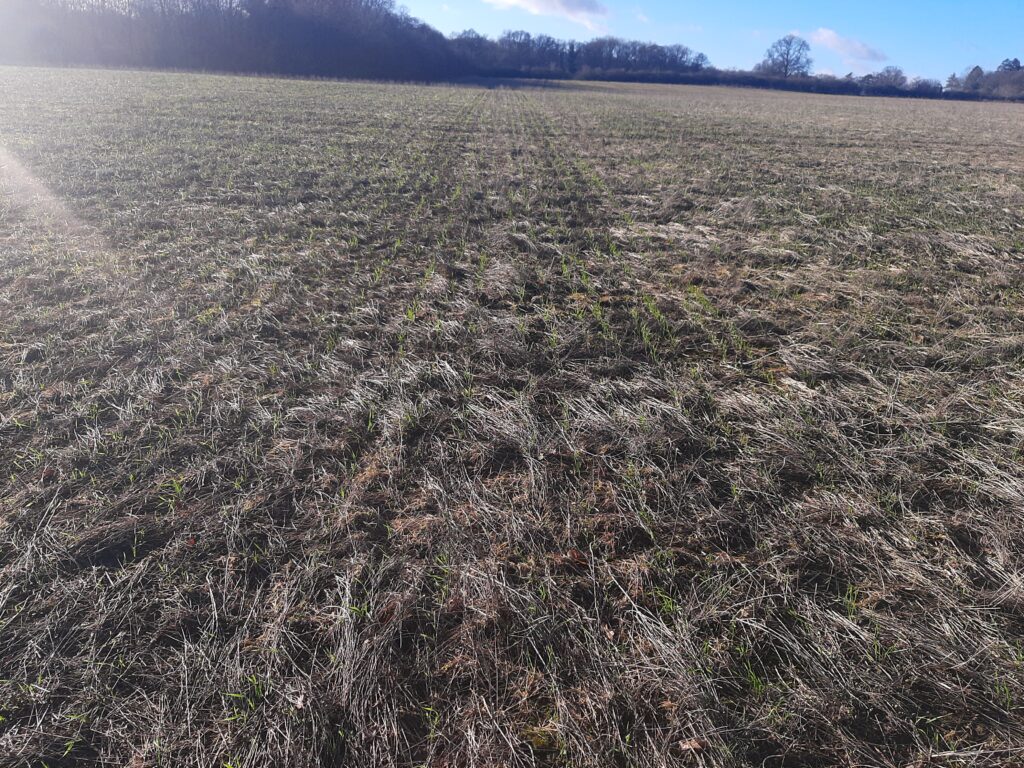
It should set you up for the best Groundswell yet (get it in your diaries: 2nd/3rd July 2025), which we’re working on inbetween all this farming and other stuff.
Applications to run a session are pouring in (there’s a form on the Groundswell website if you want to apply) and they are nearly all brilliant so choosing which to put on is again going to be very tricky. We are also working out how Groundschool (the new educational wing of the broader Groundswell project) is going to happen, we are about to apply for planning permission for phase one with classrooms and teaching kitchens etc. Never a dull moment…

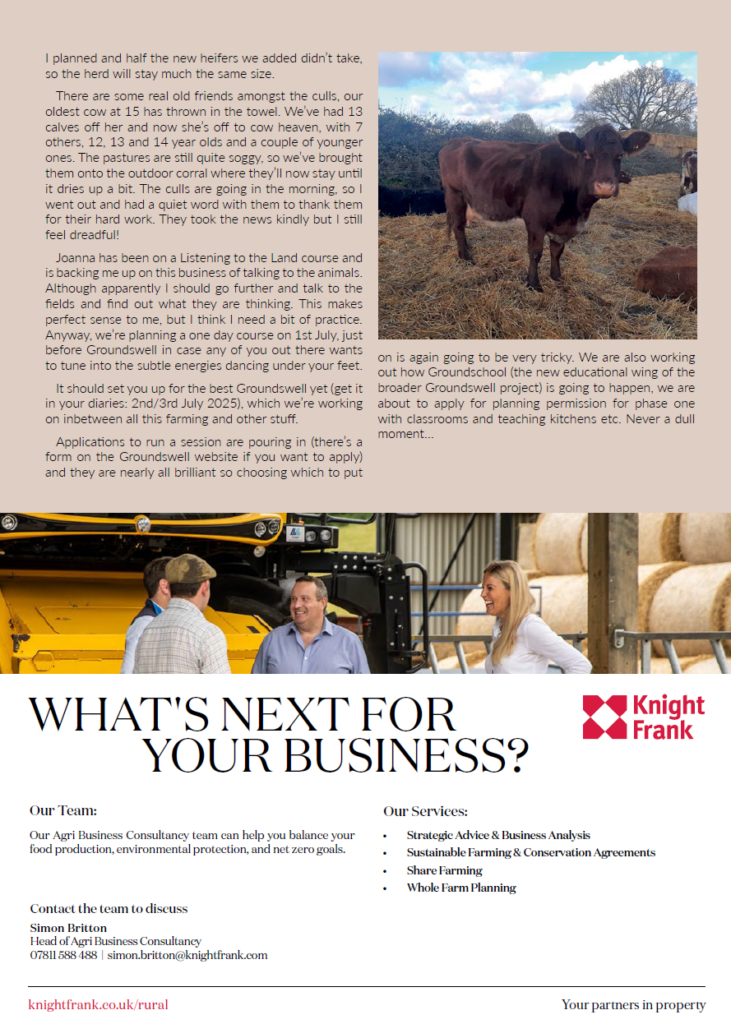
-
Potato cyst nematodes (PCN): The hidden enemy of potato crops
PCN damage to potatoes
Potato cyst nematodes (PCN) are a major threat to the UK potato industry, often invisible and hidden away from plain view. These microscopic pests live in the soil and attack potato plants, leading to lower crop yields and reduced tuber quality. The danger of PCN lies in their ability to remain in the soil for eight years or more as cysts—dead females containing eggs (Fig 1a), making infestations difficult to detect and eradicate. The main period of plant damage is caused when second stage juvenile (J2) nematodes (Fig 1b) emerge from cysts and infest plant roots. In England and Wales, approximately 65% of the land used for growing ware potatoes is infested with PCN.

Figure 1: a) Potato cyst nematodes typically found in the soil and contains hundreds of eggs. b) Potato cyst nematode juvenile that infect potato roots and initiates damage
PCN belongto the Globodera genus. There are two PCN species, white PCN (Globodera pallida) and yellow PCN (G. rostochiensis), with the former being the most common. They begin their life cycle as eggs in the cysts (Fig 2), hatching into juvenile nematodes when the conditions are right—usually when potato plants are growing nearby. These juveniles invade the plant’s roots and feed on them, disrupting the plant’s ability to absorb water and nutrients. This weakens the plant, resulting in stunted growth, wilting, and yellowing leaves, which can easily be mistaken for other issues such as nutrient deficiencies or diseases. The juveniles feed, develop into adults and mate. The adult females turn into cysts that can hold hundreds of eggs. These cysts allow the nematodes to survive for years in the soil, waiting for the next potato crop.

Figure 2: Life cycle of PCN in relation to its potato host.
The economic impact of PCN
The presence of PCN in a field can have disastrous consequences. Yield losses can reach up to 80% in heavily infested areas, causing up to £31M in damage annually. Farmers not only face reduced harvests but also suffer financially from the lower quality of the potatoes that survive. Potatoes from infested fields are often smaller, deformed, or blemished, making them less appealing to buyers and lowering their market value. Additionally, nematode feeding can create entry points for soil pathogens, further compromising tuber quality. Managing PCN infestations is expensive, requiring costly measures like crop rotation—planting non-host crops such as cereals—and the use of nematicides and soil fumigation, which adds to the financial burden.
The spread of PCN is facilitated by their ability to transfer easily between fields. Infested soil can be moved via farming equipment, machinery, and even boots. Seed potatoes are another common source of PCN spread, introducing the pest to new fields if infected. This makes strict phytosanitary measures essential. Farmers are encouraged to regularly test their fields for PCN and adopt strict hygiene protocols, including thoroughly cleaning machinery and equipment and using certified seed potatoes free of PCN. With quality land becoming scarce, proactive management is crucial to protect the remaining PCN-free fields.
PCN management options
With only one granular nematicide (fosthiazate) remaining approved for use, potato growers face a critical juncture in sustainable PCN management. Responsible nematicide use is important. This means adherence to best practices and safety protocols and calibration of application machinery.
Controlling volunteer (groundkeeper) potatoes is essential for managing PCN. Volunteer potatoes left in fields can harbour PCN and allow the pest to persist across growing seasons. Effective control involves removing all tubers post-harvest, monitoring fields regularly, and eliminating any regrowth through manual removal or herbicide application. This reduces the risk of PCN buildup and spread.
Using certified seed potatoes produced on PCN-free land is another critical practice. Certified seeds are rigorously inspected to ensure they are PCN-free, minimising the risk of introducing nematodes into uninfested fields. Growers should source seed from reputable suppliers, verify soil testing documentation, and comply with certification standards to protect their crops and sustain yields.
Planting resistant or tolerant potato varieties is another key strategy for managing PCN populations. Varieties like Buster, Lanorma, and Cinderella have demonstrated better performance under PCN pressure, providing acceptable yields even in infected fields. Trials conducted by The Potato Partnership have identified varieties like Lady Luce and Bruar, exhibiting dual resistance to PCN, as potential long-term solutions.
Biofumigation and trap cropping methods are gaining traction in PCN management. Biofumigant brassicas, such as Indian mustard, can significantly reduce PCN populations through the production of volatile isothiocyanates. Trap crops like prickly nightshade (Solanum sisymbriifolium) can stimulate PCN hatch without allowing them to complete their lifecycle, potentially reducing populations by up to 85%.
By combining these methods into an integrated pest management (IPM) strategy, growers can take a multifaceted approach to sustainably manage PCN and stay ahead of infestations.
PCN soil testing as the first defence
Effective management of PCN begins with accurate soil sampling to assess infestation levels. PCN testing also helps assess the effectiveness of management measures employed, ensuring strategies are working as intended and guiding adjustments for better management. Proper sampling techniques are crucial for reliable detection and quantification of PCN populations.
Soil sampling guidelines:
- Timing: Take soil samples between September and March, before planting, to determine PCN risk and inform management decisions.
- Sampling pattern: Use a systematic approach, such as a ‘W’ or grid pattern, to collect samples across the entire field. This ensures that the samples represent the field’s variability.
- Sample depth: Collect soil from the top 20 cm, as this is where PCN are most likely to be found.
- Sample size: Combine a minimum of 50 cores to form a composite sample of at least 1 kg. This increases the likelihood of detecting PCN if present.
- Equipment hygiene: Clean sampling tools between fields to prevent cross-contamination.
Following these guidelines enhances the accuracy of PCN detection, enabling more effective management strategies. For detailed instructions, refer to the PCN Sampling and Laboratory Guide.
ADAS offers comprehensive Pest Evaluation Services to assist potato growers in managing PCN effectively. Our services include soil examination for PCN, determining the number of PCN cysts per soil sample, counting eggs per gram of soil, viability testing using staining techniques, and identifying the proportion of different PCN species present. For more detailed information and PCN advice, growers can email pes@adas.co.uk or call 01944 738646 to submit their enquires and they can visit PCN testing services to order sampling kits for £29 + VAT per sample.
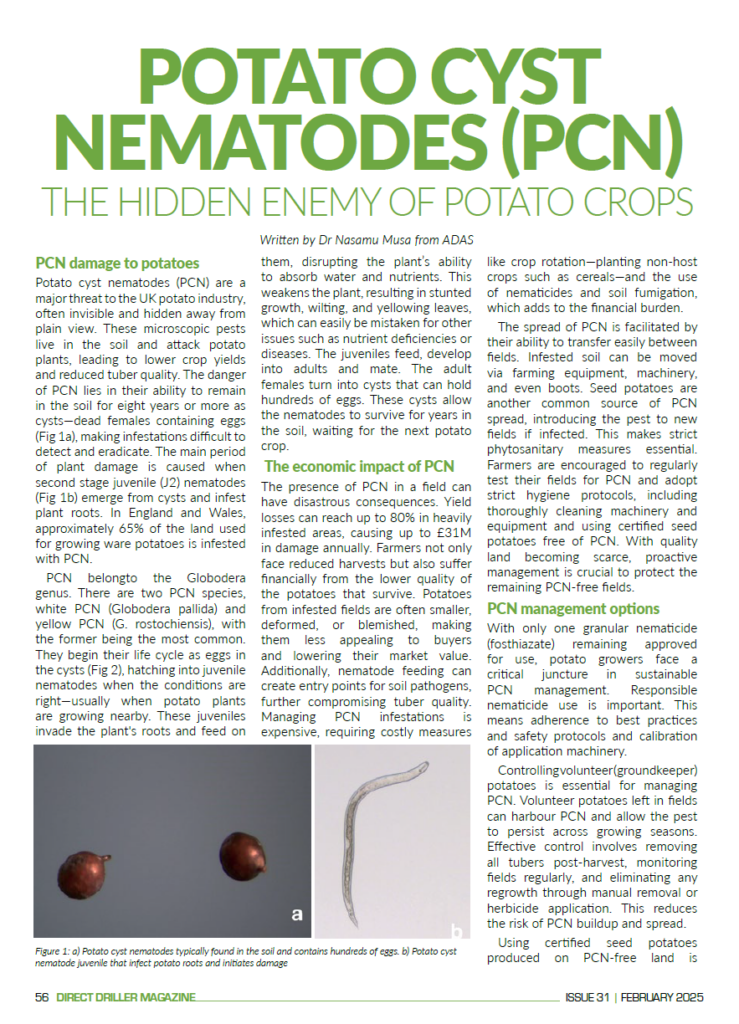
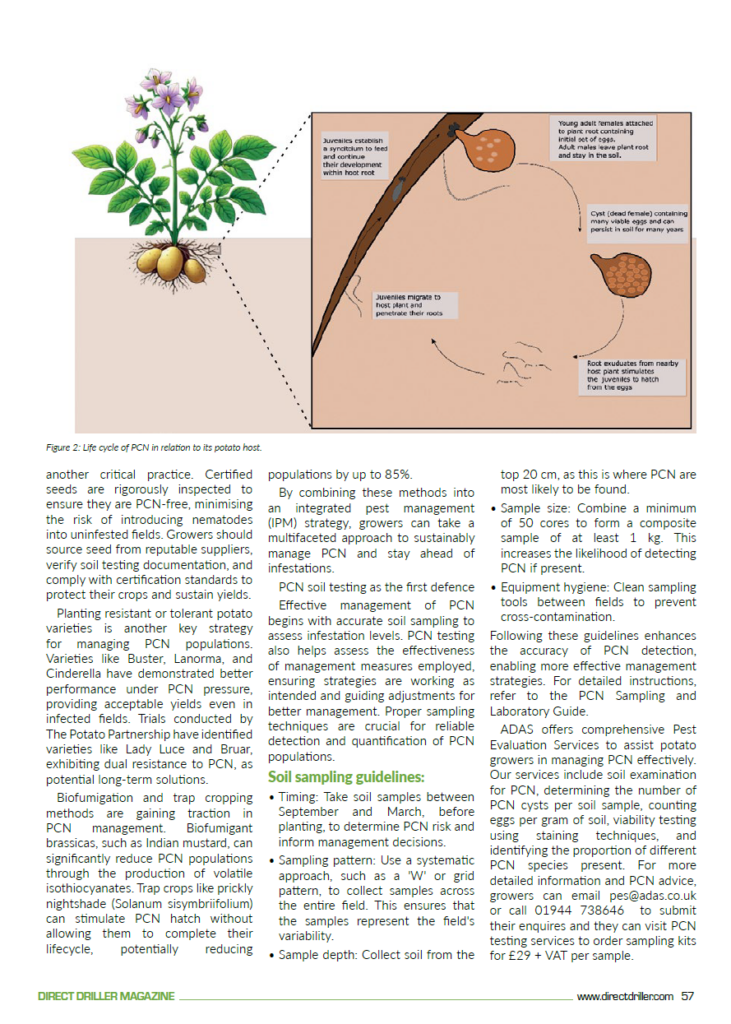
-

Long-term fall in phosphate use raises concerns
The development of soil-release agents and protected forms of phosphate means growers can meet crop needs without having to apply large quantities of TSP, SSP or rock phosphate.
Disincentivised by higher prices for phosphate (P) fertiliser Britain’s growers have gradually reduced application rates to the extent that many soils now contain worryingly low levels of this essential macronutrient.
Data from the British Survey of Fertiliser Practice (BSFP) revels how, at the national level, phosphate use has fallen by 68% since 1983 and by 62% for potash (K) (see figure).

Overall application rates (kg/ha) for phosphate and potash on crops and grassland in Great Britain between 1984 and 2023.
Source: BSFP; July 2024.This data supports a wide variation in soil analysis. Of the roughly 30,000 samples collected nationally by Agrii and RHIZA in 2022, more than a fifth (21%) fell below index 2 for phosphate while more than a quarter (26%) were below index 2 for potassium. Crops grown on these soils would require large applications of both nutrients.
Conversely, 16.1% of phosphate samples analysed were an index 4 or higher while 24% of potassium samples were at index 3 or higher. In both cases, growers could continue to take save on the seasonal application, a so-called ‘P & K holiday’.
Avoid the ‘hunger gap’
For Ben Wainwright, Agrii fertiliser product manager, the downward trend in phosphate use is concerning. Growers are only likely to see a visible deficiency if it is severe. There may be a shortfall, only seen in harvested yield, which goes unaddressed.
“For it to be visibly apparent, such as in the form of purple stems or leaves, the deficiency has to be severe,” Mr Wainwright says.
“In these situations, an application high in P2O5 such as Triple Super Phosphate is the best course of action, although it is best applied preventatively, rather than as a cure. The optimal approach would be to apply a product with a protective coating such as Agrii Protected Phosphate (APP). This is a coating on TSP or DAP granules that reduces lock-up in the soil by calcium (Ca), aluminium (Al), iron (Fe) and magnesium (Mg) and increases the quantity of phosphate that is biologically available to the crop. Trials indicate that application rates can be cut by up to 20% depending on the soil index,” he adds.

Ben Wainwright Release P reserves
For those growers with good soil reserves, typically Index 2 or better, an application of Agrii-Start Release as a spray to the soil surface at either the pre- or post-emergence timing up to growth stage 30, will increase the quantity of soil available phosphate 60-days after application.
“Agrii-Start Release is a unique soil phosphorous activator for all soils with less than 30% organic matter. It can be used on high or low pH soils, and it also increases the availability of other nutrients including zinc, manganese, boron and copper.”
Widely trialled across most crops and soil types, Agrii-Start Release has consistently given a positive response (see table 1).
“The yield gains in winter wheat and spring barley have been impressive. Across a range of soil indices, its application has consistently delivered a positive return on investment,” Mr Wainwright says.
Table 1: Yield response from a single application of Agrii-Start Release
Crop Soil pH Soil P index Yield response (t/ha) Margin over input cost (£/ha) WW 6.9 4.1 +0.7 +102 WW 7.9 1.1 +0.6 +84 WW 7.8 2 +0.5 +63 Spr. Bly 6.1 5.8 +0.45 +40 Reference: Agrii. Assumes winter wheat at £180/t and spring barley at £150/t.
To make efficient use of all sources of crop nutrition first requires an understanding of what is already available in the soil if unnecessary applications are to be avoided. The introduction of the CSAM1 nutrient management action as part of the Sustainable Farming Incentive (SFI) has helped to increase the area of soils analysed annually.
“TheCSAM1 action offers a payment of £6/ha to encourage growers to test soils. This is roughly equivalent to a broad-spectrum soil test so can cover the expense while delivering the benefit of a wider analysis beyond the requirements of CASM1,” Mr Wainwright says.
“Good data is the basis of an informed decision. Knowing your exact growing conditions aids your ability to tailor applications and optimise production,” he adds.
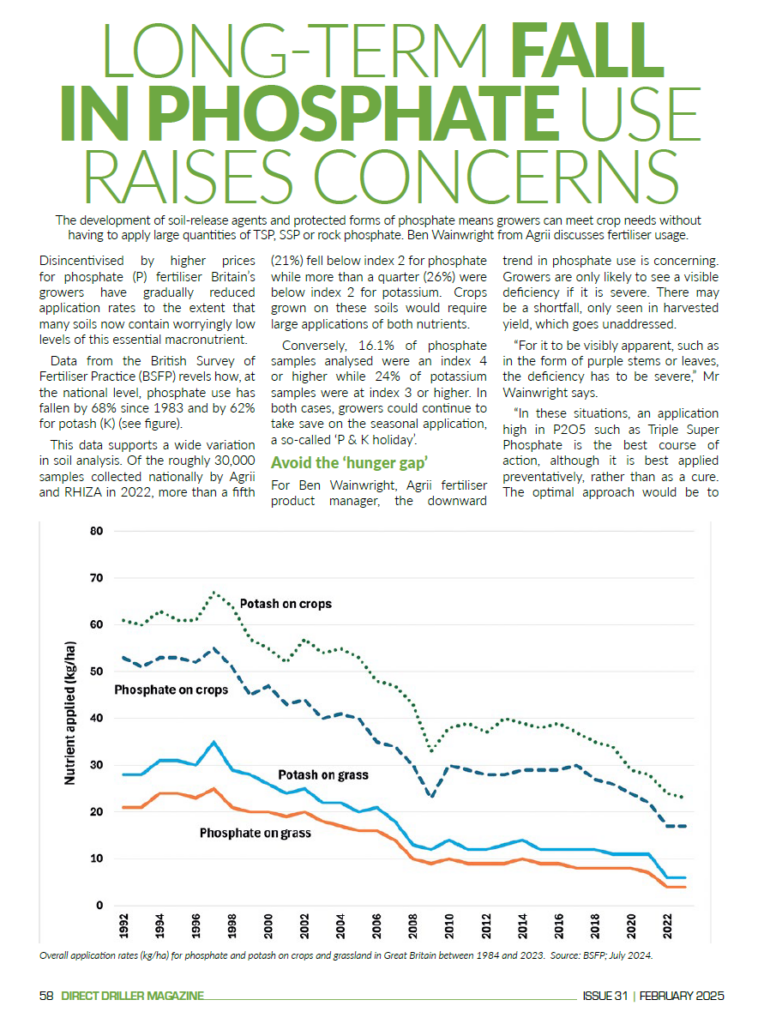
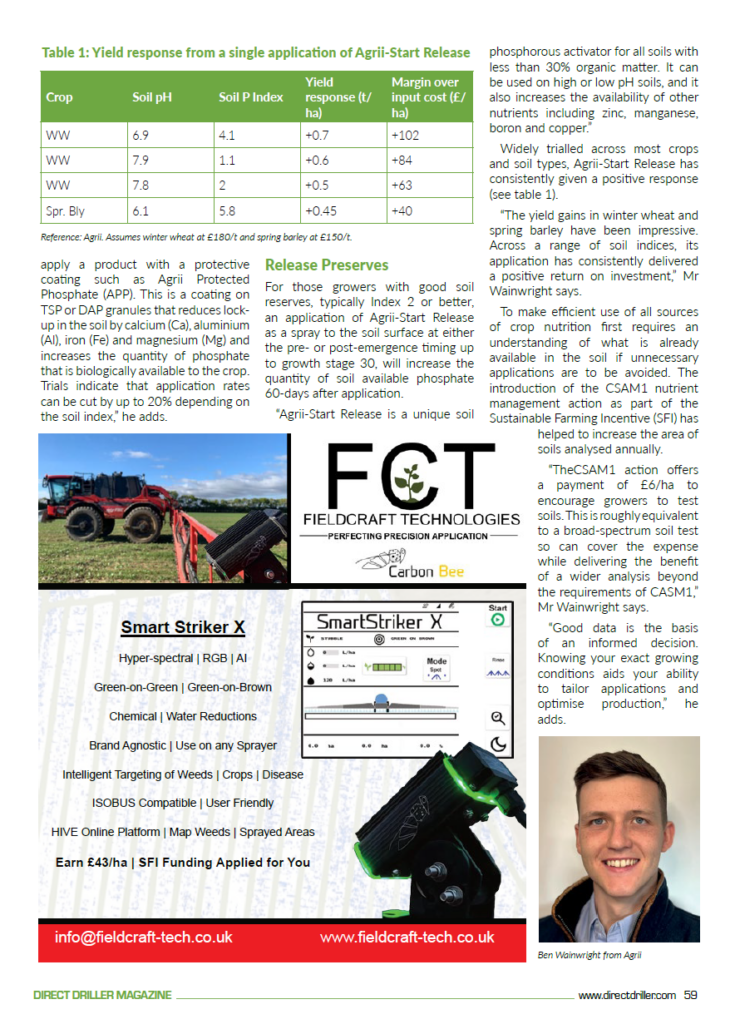
-
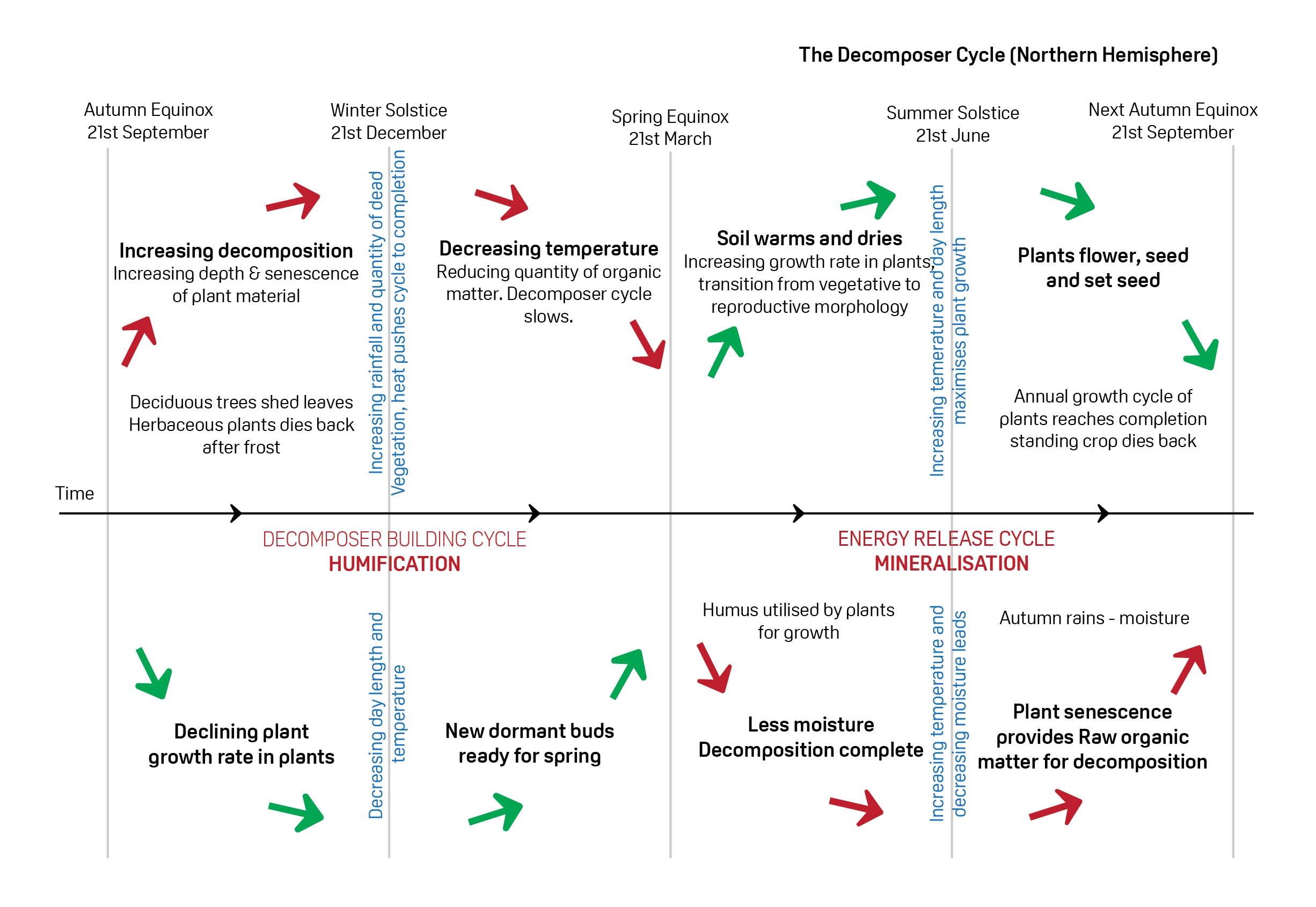
The importance of the winter decomposer cycle
Written by Mike Harrington, Managing Director of AIVA Fertiliser
Following on from the beginning of November, and it is reassuring to see that nature’s autumn cycle is beginning. The time where digestion, recycling and humification occurs in active soil systems. We do not require an expensive test to see this. Our eyes tell us that this is an important time of the year with the arrival of the spider’s webs (fantastic predators) worms become active as the organic food source increases and plant growth reduces. 25 earthworms per cube foot is 1 million worms or 30 tonnes earth casts/acre/year and the best castings I have measured to date over an eight-week autumn period is 41 tonnes per hectare. Earthworms create a reduction in bulk density of soil, they increase in cation exchange, increase in structural stability, and increase nutrient availability (can be as high as 5 times more nitrogen, 7 times more phosphorous, 11 times more potassium, 2 times more magnesium). Recently, scientific studies show earthworms can reduce Fusarium protein by 98.8% in five weeks, while DON content was reduced by 99.7% All in all, where could we achieve anything like this with an applied product?
Charles Darwin, naturalist, geologist, and biologist, and Ehrenfried Pfeiffer, a soil scientist and leading advocate of biodynamic agriculture in the early to mid 1900’s, both talk of worms as humus builders and I believe they must be right because all studies show substantial increases in CEC (increased soil holding power). So, whatever nutrients are cycled can be held within the soil until required and because growth is slowing down, lignum and organic matter from the previous season dropped as debris or roots increases. It is the fungal period for digestion without the masses from the biological city interfering, the food source is all theirs. All in all, it is in balance to the spring’s mineralization period (release and utilization). The pictures show nature taking its place in the food web doing what has been done for millennia and without human interference. For those within the ‘regenerative’ or ‘organic’ paradigm this is easily seen because organic matter building becomes the main driver not nitrogen and is a hugely important time in the year for the soil system to function to best effect. Within the more intensive system this must be funded and so if you are on land with depleted organic matter, having crops grown with the increased application of nitrogen and the management of disease with fungicides (chemicals toxic to all fungi) we develop a system wholly reliant on products. The pictures portray very nicely what nature can do, the manure image, for example, depicts a fungal infection. Autumn conditions are currently perfect for this process of digestion and cycling.



Given the opportunity nature will always move into a food source, here we have spiders beginning to colonise a muck heap looking to capture prey. The soil is no different, Merlin Sheldrake, a current biologist and mycologist, talks of over half a billion tonnes of fungal spores being released into the atmosphere on an annual basis. Each breath we take could have 1-10 fungal spores so the potential for fungi to recolonize according to the correct environment is incredibly strong. The issue is our intensive farming systems cause soil environments that are not conducive for colonization and that leads to compromised and unstable systems reliant on inputs. The decomposer slide below is from a Biodynamic calendar charting the year and its biological cycles. We can see clearly the balance between winter being the decomposer building cycle (Humification) and the spring/summer energy release cycle (mineralization), they need to be in balance to function correctly. In many farming systems we do not have the winter system at all, there is not enough carbon/lignum or stability to drive this building cycle and therefore the whole soil food web is compromised.
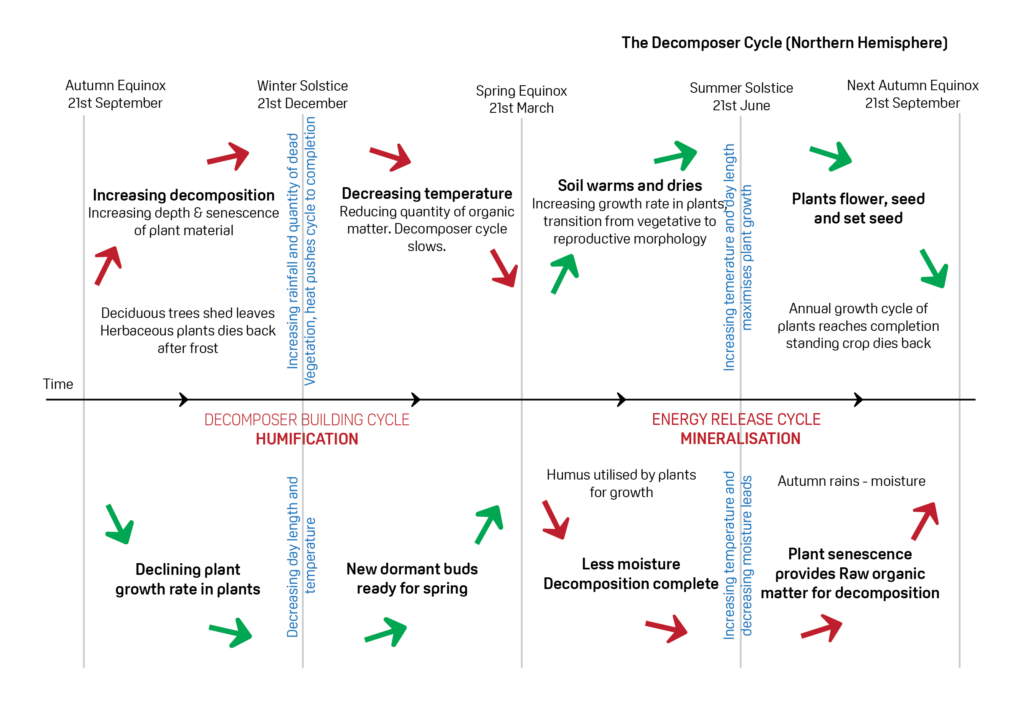
For those moving into a ‘regenerative’ style system it is important to remember that the foundation of the soil is about renewal and preservation. Adequate air and water are important, but it is the consistent carbon food source that is essential. For compromised systems, having a cover building crop once in three to five years is not consistent enough to build that resilience, it is boom and bust for the soil microbial community. Regular carbon capture or applications of carbon is essential to build a system that is stable, resilient and diverse and this takes time and effort.
Methods to increase microbial populations
- Photosynthesis and Root Exudates
- Increasing Plant Diversity –Rotation, Catch Crops & Cover Crops, Companions
- Organic Manures and Composting
- Liquid Carbon Sources
- Minimising Soil Disturbance but AIR is key
- Keeping Soils Covered – Residues AND Plant Growth
- Reducing Pesticide and In-organic Fertiliser Inputs
- Microbial Inoculants
The solution is not one of the above but all over the above until the system and the cycle of natural fertility begin to recover.

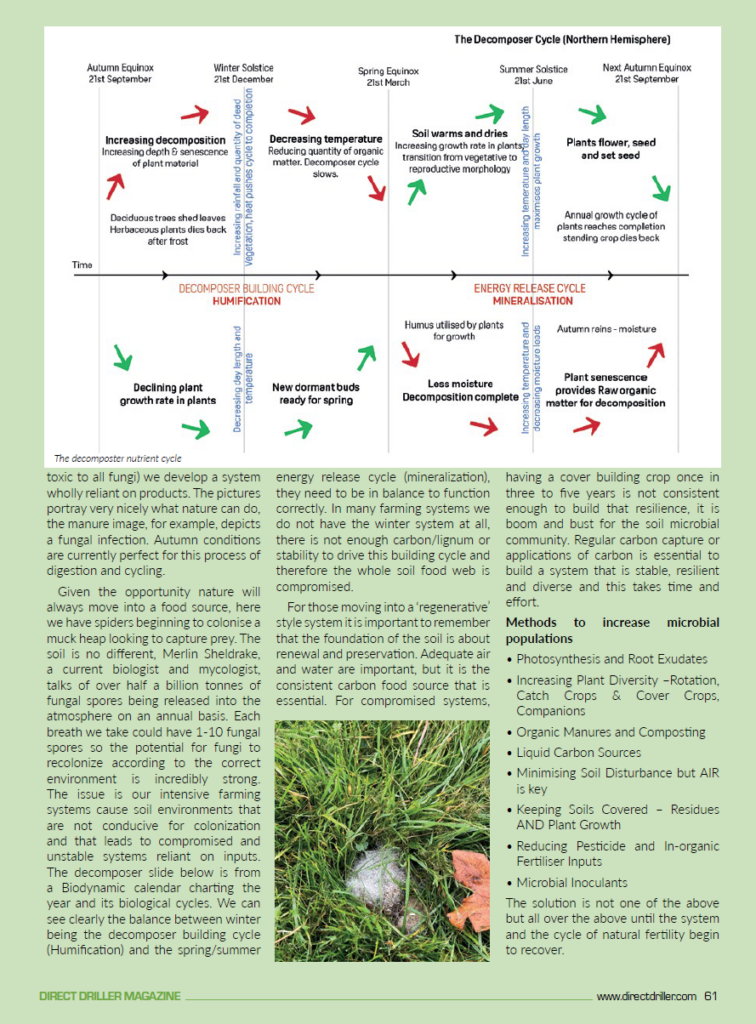
-
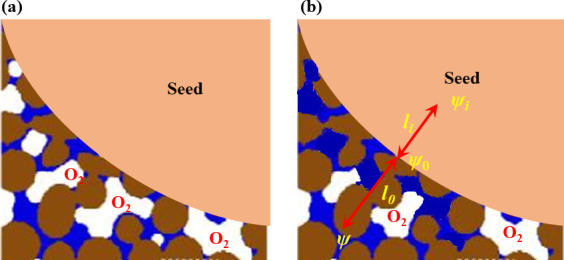
New seed germination model devised
New research from Rothamsted
Novel tool will give breeders more predictive accuracy for seed development and growth.
Scientists at Rothamsted have developed a novel mathematical model for seed germination. The new tool is derived from field data and marks a significant improvement in accuracy over previous models.
Germination models use water and temperature as the main drivers of seed activity. Currently these are based largely on water potential, which is the energy that drives water to move from one system to another. This is challenging to measure accurately in the field. The new model uses water content which is much easier to measure.
These models are essential to the seed industry as it is important to develop lines where each individual seed germinates at roughly the same time and grows uniformly. This is particularly important for crops like carrots or onions where having similar sized plants makes them more profitable.
Seed suppliers must therefore test seed samples to ensure a certain germination rate is met, a process that is difficult and time consuming. So modelling is used to assess each batch based on a given sample.
However, current models do not always accurately reflect field conditions
That is where the new model comes in. Water content is much easier to measure accurately in situ than the drivers of water potential. That makes the new model far more likely to accurately predict germination times in field situations.
“This is the first time a germination model has been able to be developed using field data,” said Dr Xiaoxian Zhang, corresponding author of the new study. “Seed germination is a crucial stage in plant development, intricately regulated by various environmental stimuli. Understanding these interactions is essential for optimizing planting and seedling management but remains challenging due to the trade-off effects of environmental factors on the germinating process.”
The research team created a new model by viewing seed germination as a dynamic process. To validate the model, they conducted field experiments by drilling wheat seeds at different dates to establish a temperature gradient and in different plots to create a soil water content gradient.
Comparisons between the experimental data over a period of seven years and calculated results show that the model accurately reproduces all germination patterns and the subsequent seedling tillering with a 95% fit.
“In germination there a trade-off effect of soil water on bioavailable water and oxygen. Introducing a physiological dimension enables seed germination and the subsequent tillering process to be modelled as a continuous physiological process, providing deeper insight into plant growth dynamics,” said Zhang. “We believe this new approach offers a genuinely new approach to germination modelling and for the first time takes on tiller number. We also hope that it will be more stable than the hydrothermal time models and hence more useful for field application,” he added.
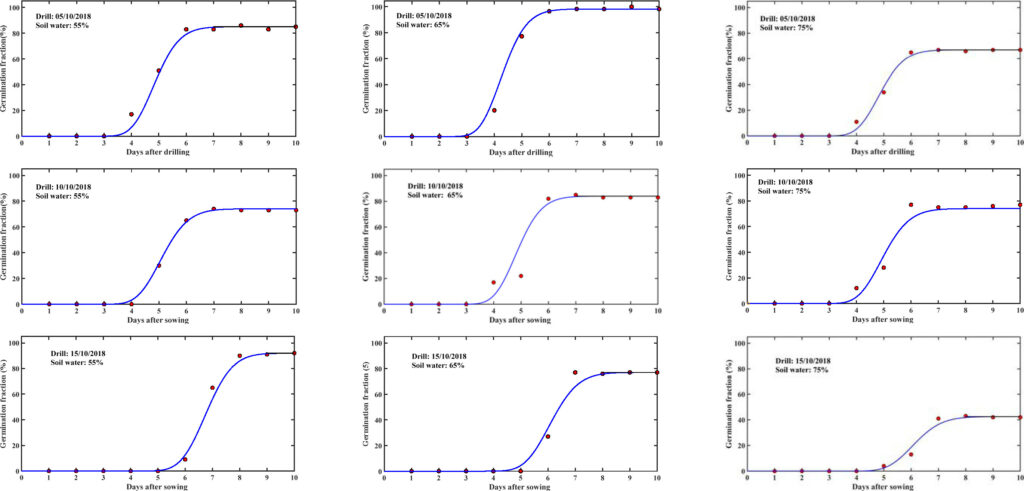
Measured (symbols) and simulated (solid lines) percentage of germinated seeds drilled at different dates in plots under different soil water contents (expressed as % of the field capacity) as shown in the legends. Read the paper: A new conceptual model for seed germination and seedling tillering of winter wheat in the field
Abstract
Seed germination is a crucial stage in plant development, intricately regulated by various environmental stimuli. Understanding these interactions is essential for optimizing planting and seedling management but remains challenging due to the trade-off effects of environmental factors on the germination process. We proposed a new conceptual model by viewing seed germination as a dynamic process in a physiological dimension, with the influence of environmental factors and seed heterogeneity characterized by a germination speed and a dispersion coefficient. To validate the model, we conducted field experiments by drilling wheat seeds at different dates to establish a temperature gradient and in different plots to create a soil water content gradient. Comparisons with our experimental data and literature results show the model accurately reproduces all germination patterns and the subsequent seedling tillering, with R2 > 0.95. Our results reveal that within suboptimal temperature range, the seed germination increases asymptotically with temperature, and that as soil water content increases, the germination speed increases initially before decreasing, illustrating the trade-off effect of soil water on bioavailability of water and oxygen. Introducing a physiological dimension enables seed germination and the subsequent tillering process to be modelled as a continuous physiological process, providing deeper insight into plant growth dynamics.
1. Introduction
Seed germination is critical not only to plant survival but also to post-germination plant development such as fitness, timing of flowering and dynamics of the plant community. Difference between seeds in their response to environmental stimuli is an evolutionary strategy to improve plant survival in natural systems. In managed ecosystems, however, it is desirable for seeds to germinate simultaneously, and germination uniformity is thus a seed quality trait.
Seed germination is a complex physiological process modulated by environmental cues including light, oxygen (O2), temperature and the amount of water available for seeds to imbibe. The onset is water uptake of the quiescent dry seed and the end is the emergence of the embryonic axis out of the seed coat. Several key stages, including solute leakage during imbibition, initiation of metabolic activity for protein synthesis and emergence of the radicles, are distinguishable in germination, many of which can be visualized non-invasively through imaging technologies. Seed germination has received less attention compared to other topics in plant science, but the advances in molecular technologies over the past few decades have substantially improved our understanding of the genes and interlocked hormone networks that regulate seed germination. The response of gene expression to environmental cues in seed germination has been well documented, and network modelling of the transcriptional interactions involved in seed germination has also been constructed to link specific genes and pathways to seed germination and dormancy. Quantitative modelling of seed germination is largely based on the hydrothermal time concept assuming that temperature and water are the main environmental stimuli of seed germination. A key feature of the hydrothermal time models is that when temperature and water potential exceed their respective base values (below which seeds remain metabolically inactive), the seed needs to accumulate a sufficient hydrothermal time for its radicle to break the seed coat. Seed heterogeneity is described by viewing the base temperature and/or water potential as random variables. The hydrothermal time model was initially developed for seed germination between the base and the optimal temperatures, and has since been generalized to cover a wide range of temperatures as experiments revealed that average germination does not increase linearly with temperature after temperature exceeds a threshold. The improved hydrothermal time models include the halo-time model to account for salinity and the oxygen-time model to represent O2 stress.
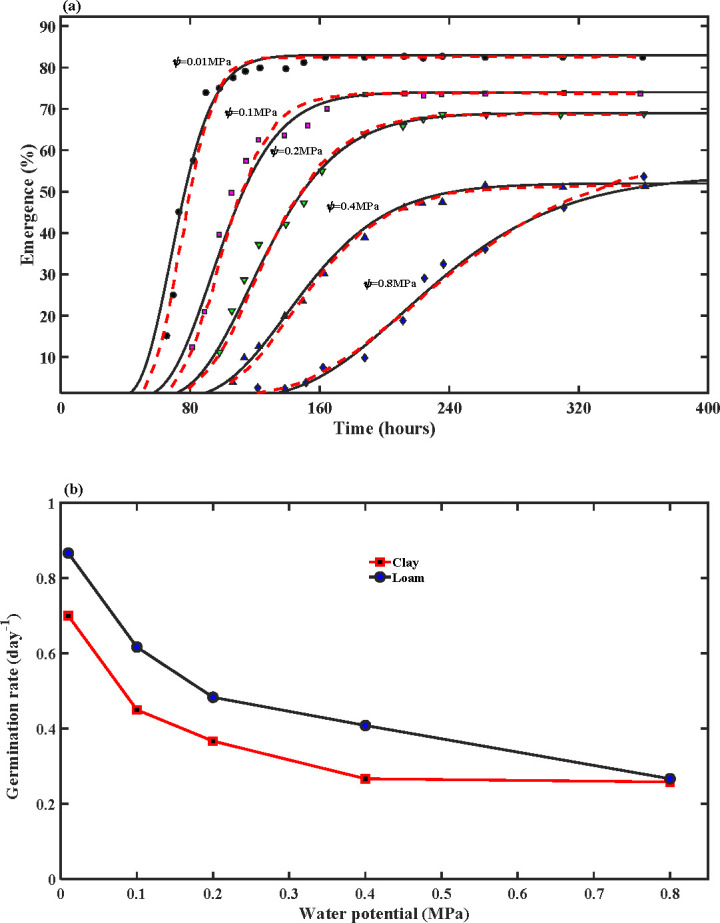
(a) Comparison of the simulated seedling emergence patterns using the proposed model (the solid black lines) and the hydrothermal time model (the red dashed lines) with those measured from the loamy soil under different water potential (the symbols). (b) The average germination speed not only decreases nonlinearly as soil water potential increases but also varies with soil texture. Seeds need to absorb sufficient water and thermal energy to germinate. Physically, the linear dependence of hydrothermal time on temperature and water potential, as assumed in the hydrothermal time models, means that the rates at which water and heat flow from soil into the seed are proportional to a water potential gradient and a temperature gradient respectively. While this is true for seed germination in polyethylene glycol on Petri dishes, where the seed–water contact area is constant and the only resistance to seed imbibition is the ability of seed coat to adsorb water, its application to the field could be problematic. Seed imbibition of water from the soil occurs through the seed–water interface, and the imbibing rate depends not only on water potential difference between seed and the water–seed interface, but also on the ability of soil to transport distant water toward the seed and the water–seed interfacial areas to imbibe water, both varying nonlinearly with water potential. Apart from this, temperature fluctuates in the field and the atmospheric O2 needs to overcome various resistances before becoming bioavailable to seeds. Hydrothermal models use an oxygen time to describe O2 sensitivity, but bioavailable O2 in the field is not an independent environmental cue; it is controlled by soil water and pore-scale soil structure, thereby varying with soil texture and soil water content.
This paper aims to propose a new conceptual model to simulate seed germination in the field. We view the metabolic reactions associated with seed germination as a dynamic process in a physiological dimension. The fluctuations in environmental stimuli and seed heterogeneity result in uncertainties in the metabolic reactions, in that physiological advancement that a seed makes at different times and physiological stages varies. We show that such variations can be modelled by a partial differential equation, with the mean of the variations represented by an average germination speed and the variance by a dispersion coefficient. To test the model, we conducted field experiments to measure the germination and seedling development of winter wheat seeds drilled at different dates (to generate a temperature gradient) in plots with different soil water contents (to generate a soil moisture gradient). The novelty of introducing a physiological dimension is that it allows seed germination and subsequent seedling development to be modelled as a continuous physiological process.
The challenge for hydrothermal time models, which require water potential, is that, due to technological limitations, measuring soil water potential higher than 200 kPa in the field using the best available methods is difficult. This value is much lower than the optimal soil water potential for wheat seeds. Additionally, in situ measurement of dissolved O2 is also challenging. This is why most hydrothermal time models were derived from Petri-dish experiments and have limited applications in the field. This paper aims to bridge this gap.
You can read the full paper here: https://royalsocietypublishing.org/doi/10.1098/rsos.240723
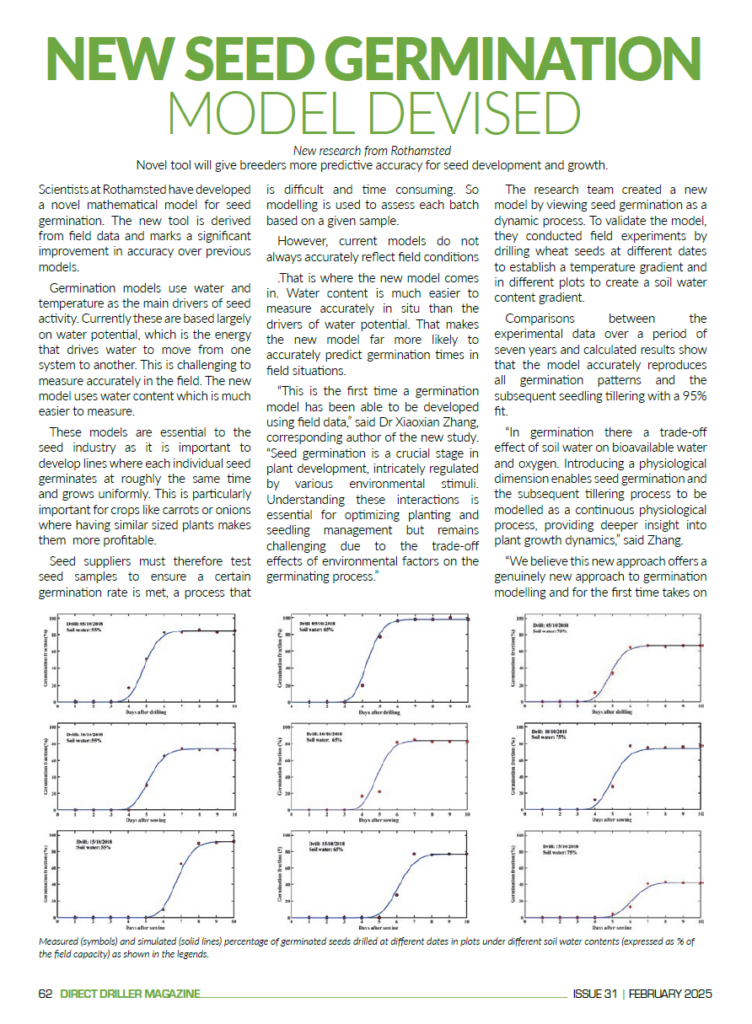
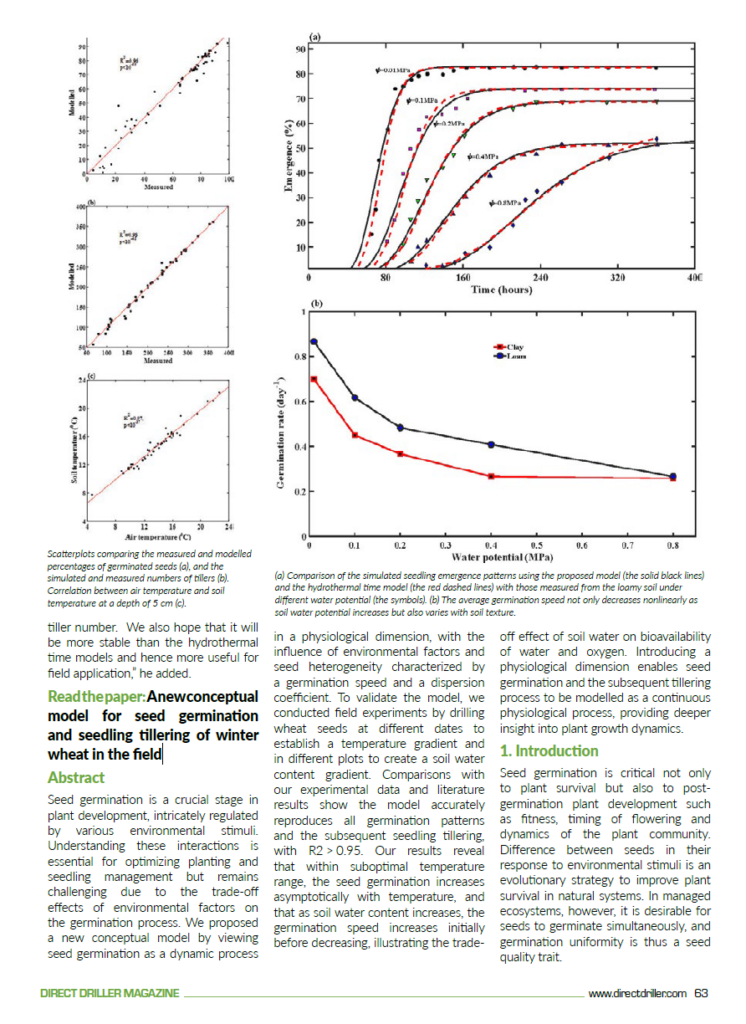
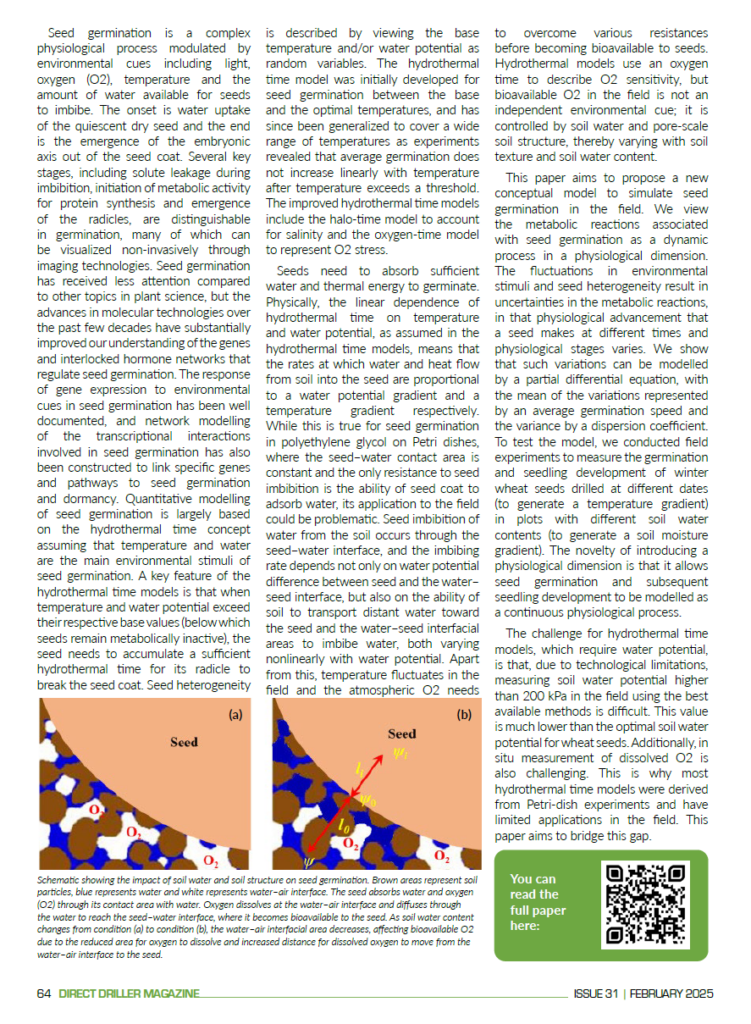
-
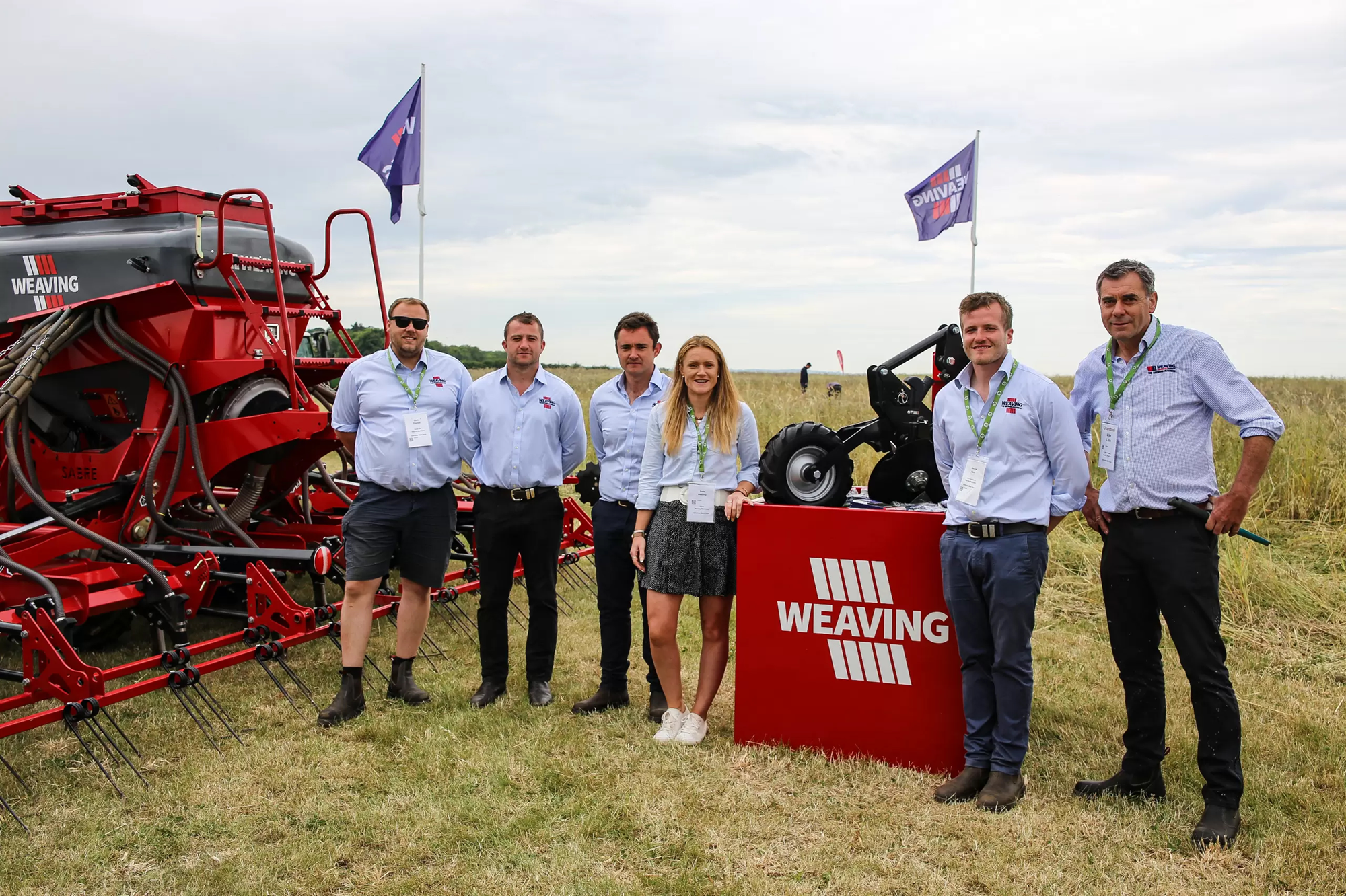
Worcestershire-based family business wins industry award
Chadbury-based agricultural machinery manufacturer, Weaving Machinery, has been awarded Gold in the British and Irish Manufacturer of the Year category in the LAMMA Innovation Awards 2025.
Family business, Weaving Machinery, has launched several new products and innovations over the past five years, with widespread recognition.
The Sabre drill debuted in 2020 and quickly became one of the best-selling drills in the UK being suitable for conventional, minimum tillage and direct drilling systems.
Meanwhile, the mounted GD disc drill has attracted international attention, gaining traction across Europe, particularly in Germany for those running min-til and direct drilling operations.
Adding to their success, the business was also awarded Silver in the Arable Establishment of the Year award category within the same awards with the cast roller used within its Subdisc.
Made up of three pieces the 700mm British cast iron V ring packer roller works to achieve a firm and level seed bed before drilling takes place.
LAMMA Innovation Award judges stated the standard across the board this year was extremely high, and congratulated Weaving for their achievements which will be formally presented at LAMMA with a trophy and certificate.
Simon Weaving, director at Weaving Machinery, said: “We are very grateful for the LAMMA Innovation Awards for recognising the product developments we have achieved at Weaving in recent years.
“We are always looking ways to improve the results our customers can achieve, particularly for those making use of min-til or no-til systems which our products really lend themselves to.”

-

BASE Conference 2025
Written by Chris Fellows
It’s always great to be back at the BASE Conference, where over 100 soil-focused farmers, agronomists, and researchers gathered to discuss the latest advancements in regenerative farming. The event provided an excellent opportunity to hear from leading experts, exchange ideas, and, of course, enjoy the lively conversations in the bar! Below is a summary of the key talks from the two-day event.
Day 1
Living Mulch
Speaker: Frederic Larson – Danish Agronomist with Agroganic and Farmer
Frederic Larson opened the conference with an in-depth look at living mulch systems, specifically using lucerne (alfalfa) to create a sustainable and resilient farming system. His 250-hectare farm in Denmark has been fully no-till for over a decade, starting as an effort to prevent soil erosion but evolving into an integrated system focused on maximizing plant growth and soil health.
He began with the fundamentals of intercropping, emphasizing how plants always compete for resources, but with careful selection of species, farmers can minimize direct competition while increasing overall resource use efficiency. He demonstrated that competition isn’t just about above-ground biomass but extends to root systems, which can have a greater impact when water and nutrients are limited.
The living mulch system allows for a winter cereal-dominated rotation without the need for summer cover crops. The key benefits include deeper nutrient capture, nitrogen fixation, and enhanced photosynthesis from year-round green cover. When managed correctly, lucerne can fix up to 400kg of nitrogen per hectare. However, balancing biomass is critical—too much mulch can lead to yield reductions.
Frederic detailed his four-year rotation strategy, highlighting the importance of mowing after harvest to encourage regrowth. Within two weeks, fields are covered in a dense green mat, quickly shifting from light to dark green. Mowing also contributes to silage production, yielding up to 8T/ha, with an agreement in place with a local dairy farmer to return slurry to the fields in March, effectively recycling nutrients.
He also explored the impact of glyphosate on lucerne, noting that it is relatively tolerant, allowing for low-dose applications to clean up the field after harvest. Additionally, increasing the seed rate of winter wheat by 25% helps counteract the reduced tillering caused by lucerne. Chemical mowing using ALS herbicides can replace mechanical mowing, but careful timing is essential to prevent the living mulch from overtaking the cereal crop.
The financial breakdown showed a significant economic advantage, with nitrogen savings, dairy feed revenue, and reduced cover crop costs outweighing the expenses of mulch establishment, mowing, and seed drilling. However, Frederic cautioned that this system introduces complexity, requiring careful management and adaptation.
Key takeaways:
- Living mulch can generate up to 400kg of nitrogen per hectare.
- Mowing triggers rapid regrowth, enhancing ground cover within weeks.
- The system presents challenges in balancing biomass and yield, requiring careful nitrogen and mowing management.
- Financially, the system resulted in a net gain of 910 euros per hectare through nitrogen savings, dairy feed production, and reduced cover crop costs.
- Long-term implications include weed suppression, improved soil structure, and potential for multiple lucerne cuts annually.
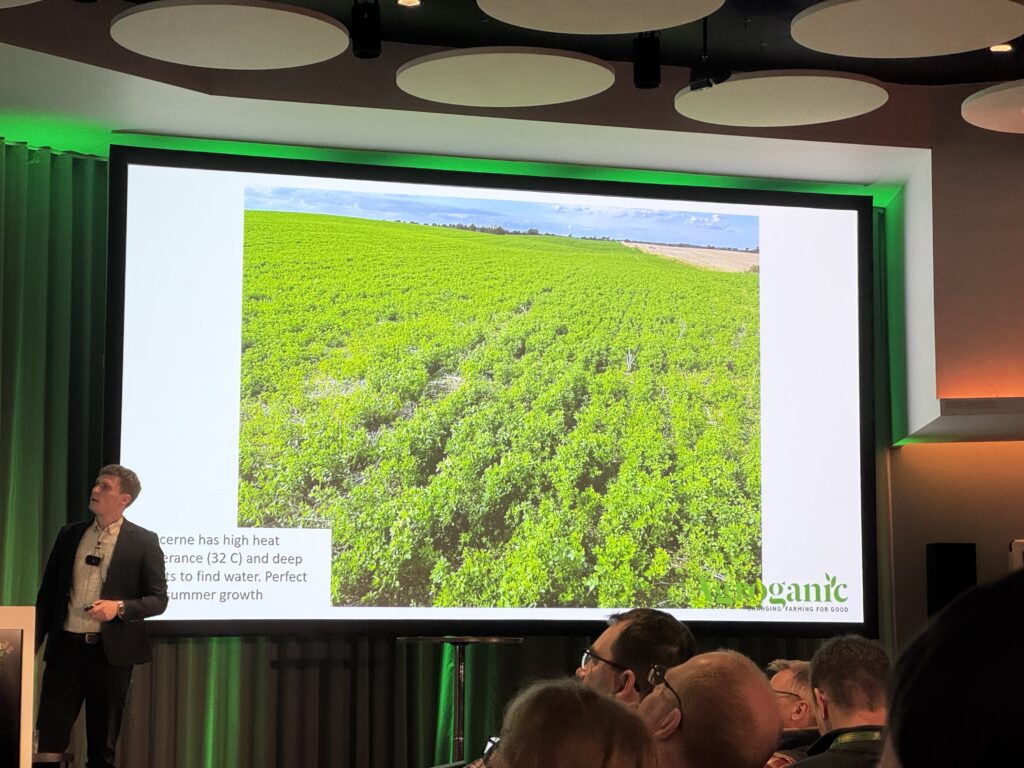
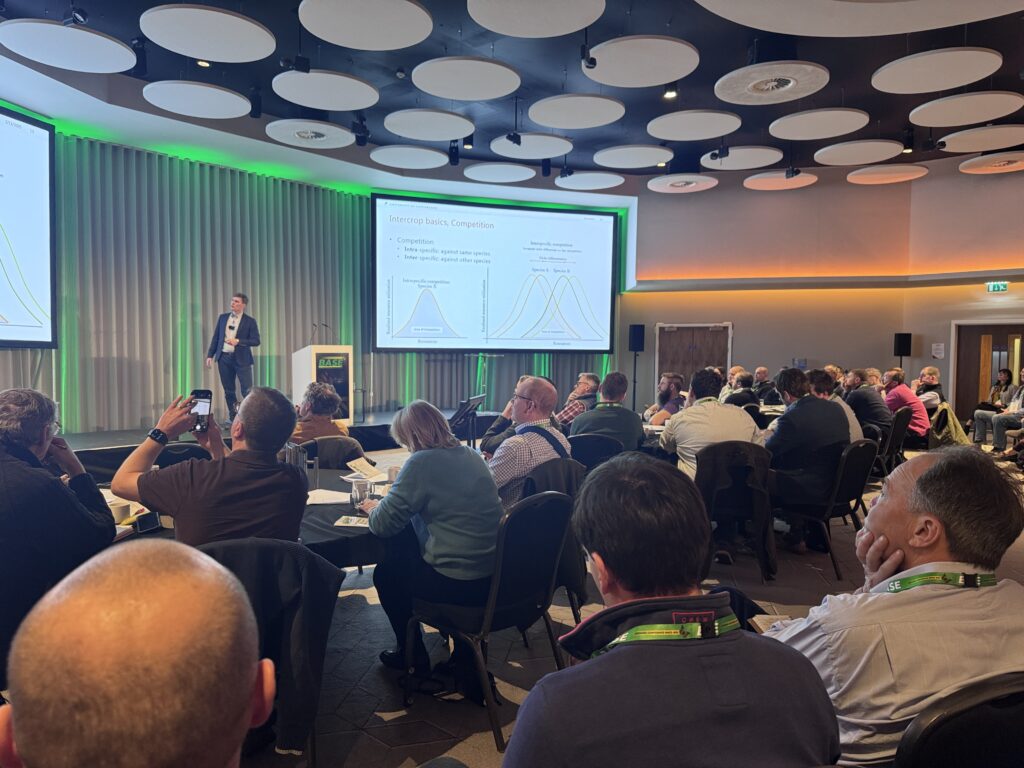
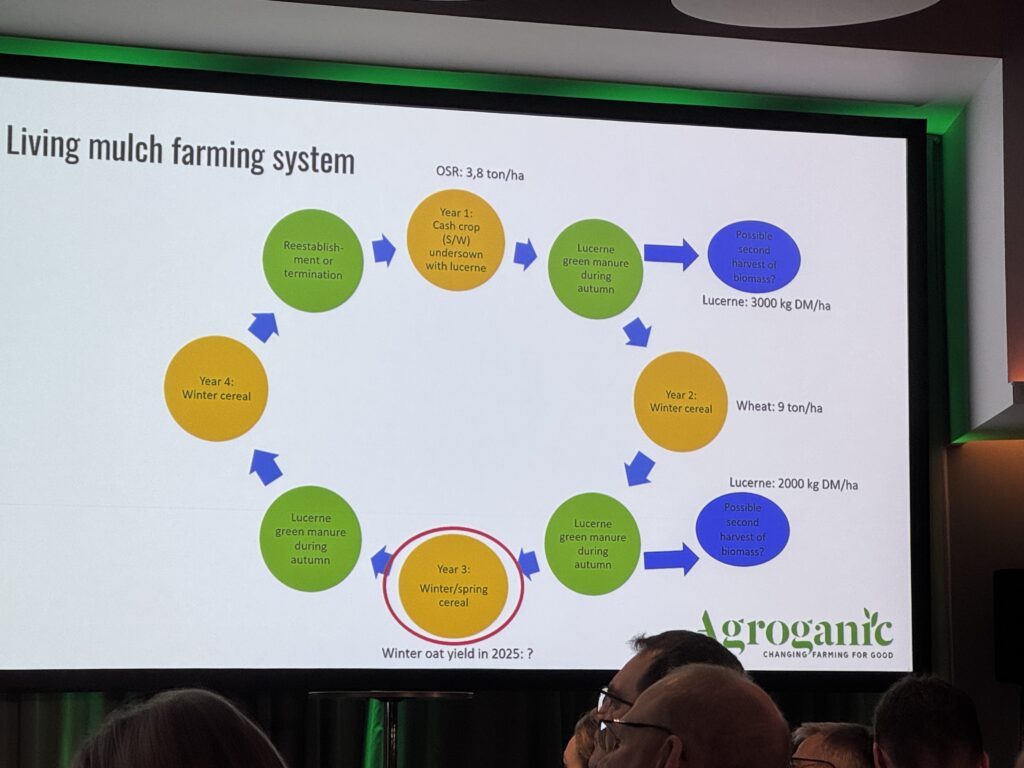
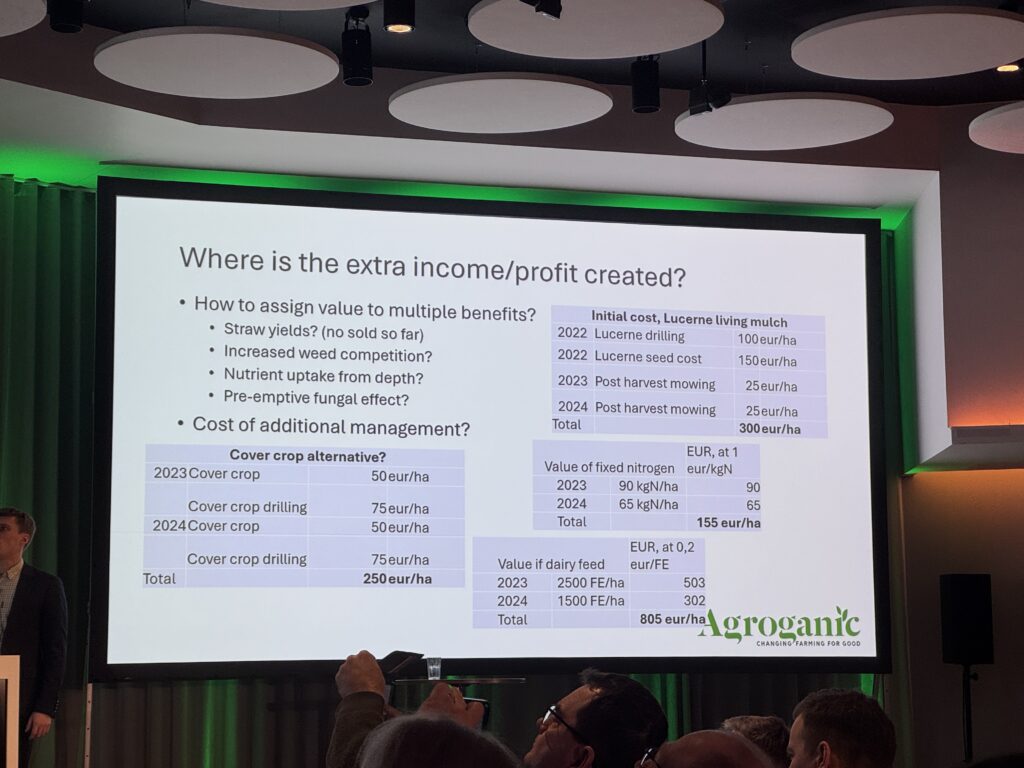
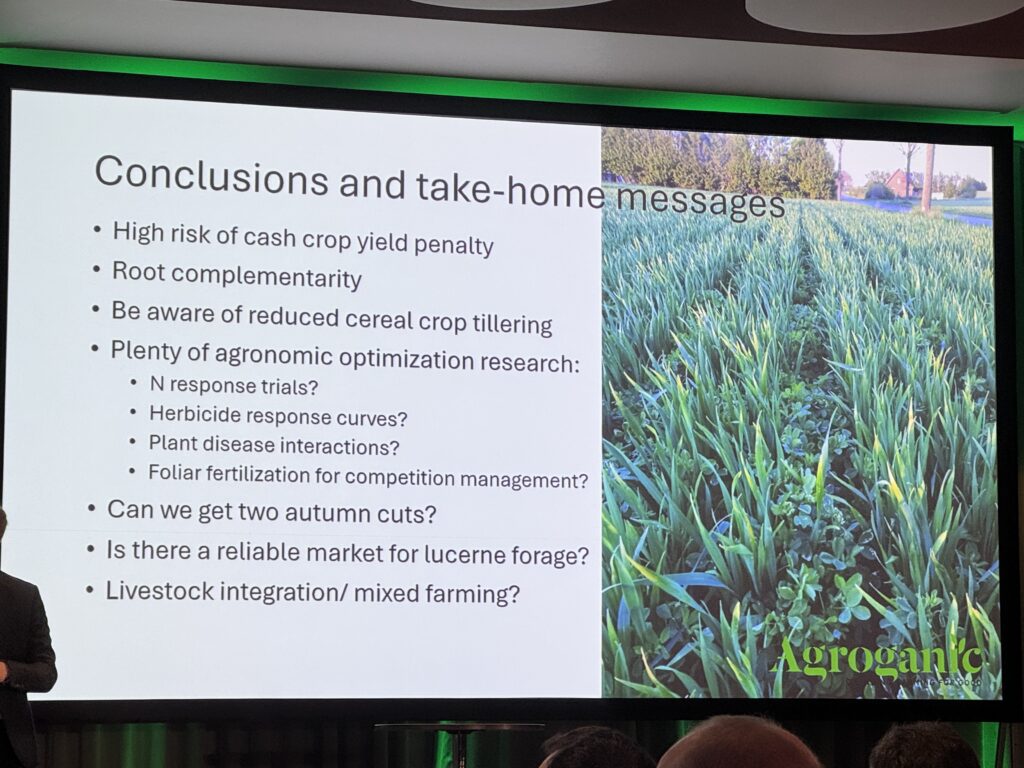
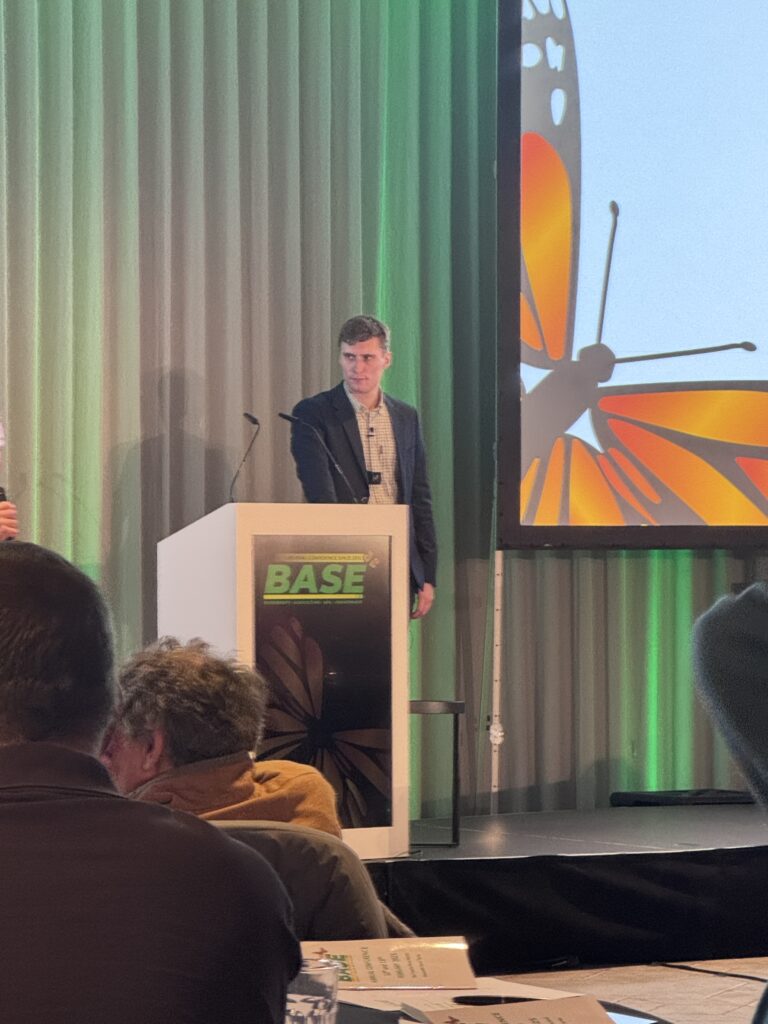
Conservation Agriculture Systems Research Experiment
Speaker: Dr. Joe Collins, Harper Adams University
Dr. Joe Collins presented a long-term research trial comparing conventional and no-till farming systems. Conducted on a 10-hectare site with 24-meter tramlines, the experiment aims to provide real-world economic data for farmers transitioning to no-till. Unlike many small-scale academic studies, this trial uses local contractors and standard farming equipment to reflect commercial realities.
Early findings suggest that while there are already observable differences in soil structure, input use, and crop yields, the most significant divergence is expected after three years. Interestingly, while no-till reduces fertilizer, fuel, and pesticide use, the differences are not as drastic as some proponents claim. The real value of this study lies in tracking the transition process over time, offering practical insights into long-term soil health and economic viability.
Key insights:
- Notable divergence in yields and input reductions emerges after three years.
- Early data shows fuel, fertiliser, and pesticide reductions, though initial yield differences are minor.
- Long-term insights will help farmers make informed transition decisions.
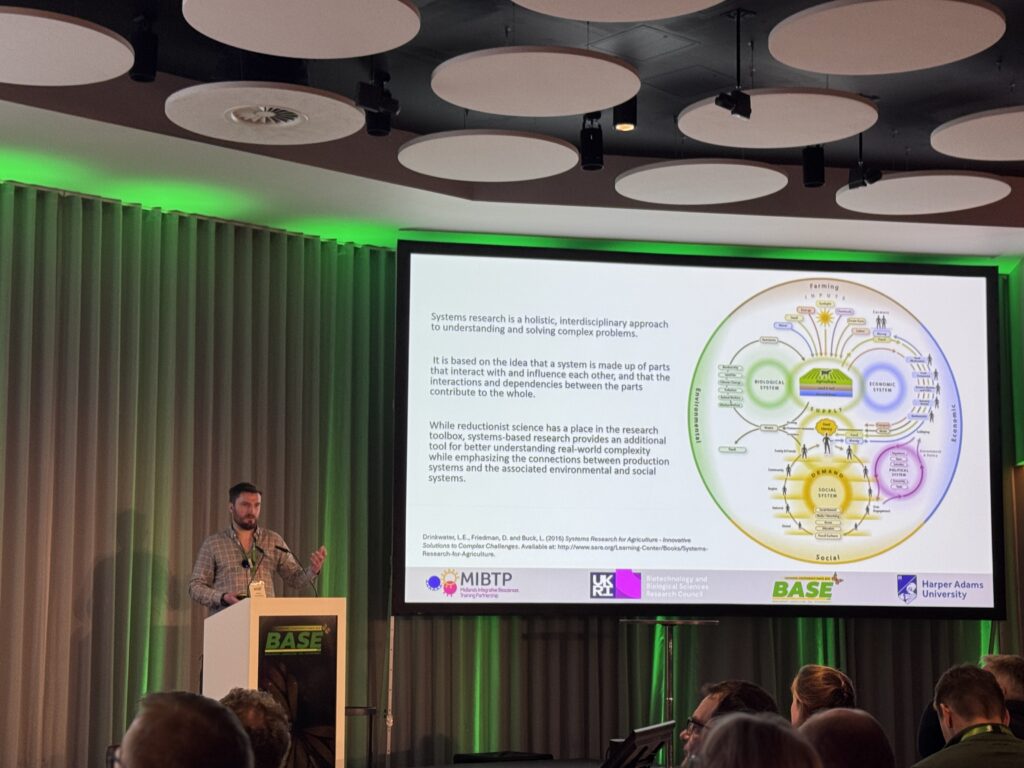
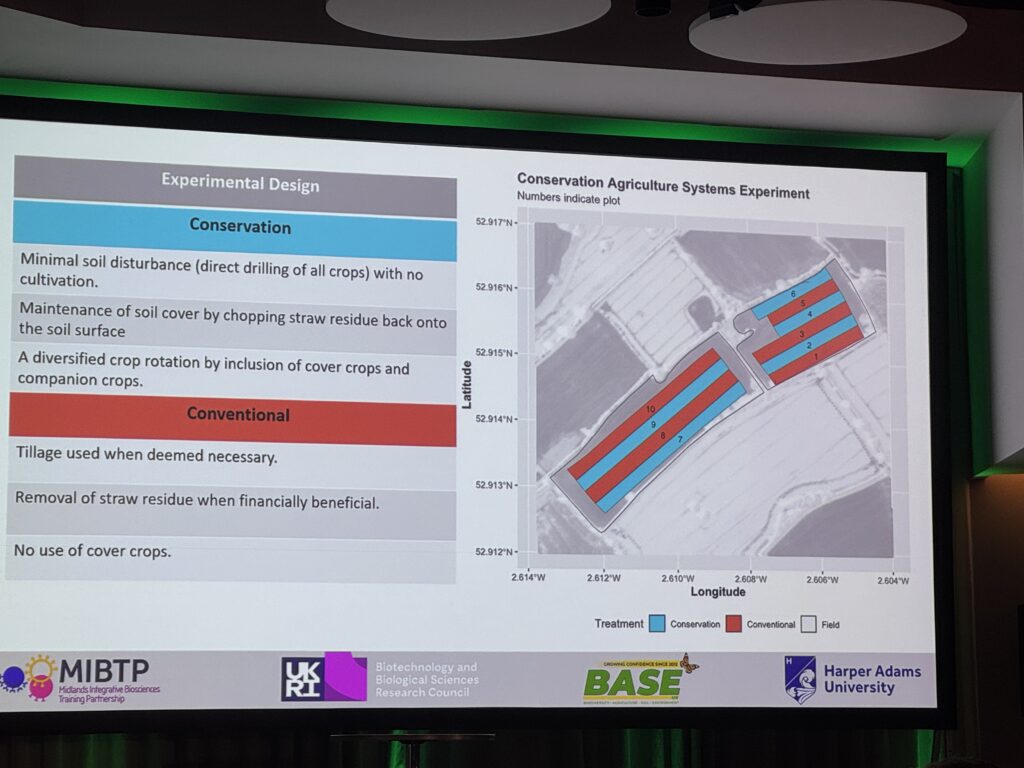
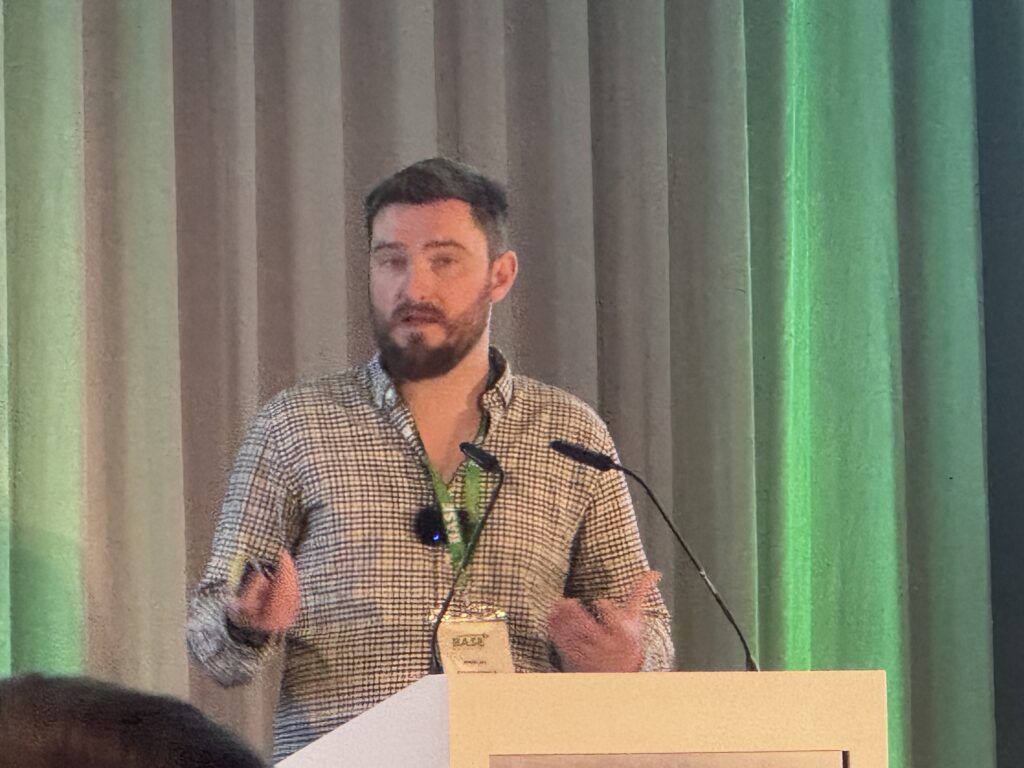
Commercial Regenerative Vegetable Production – Oxymoron or Reality?
Speaker: John Sansome, Farmer from Worcestershire
John Sansome tackled the challenge of applying regenerative principles to vegetable farming. Given the intensive nature of vegetable production, some argue that true regenerative farming is impossible in this sector. However, John demonstrated how integrating diverse crop rotations, cover crops, and livestock can significantly reduce inputs while maintaining profitability.
Through strip tillage, cover cropping, and sheep grazing, John has successfully reduced soil disturbance and improved soil biology. His conclusion? Regenerative vegetable farming is not an oxymoron—it’s a challenging but achievable goal. Success requires adapting principles to specific crops and business conditions rather than following a rigid framework.
Key Points:
- Strip tillage, cover cropping, and sheep integration as key strategies.
- Business-driven decision-making is essential for sustainability.
- While challenges remain, regenerative vegetable production is a viable and evolving reality.
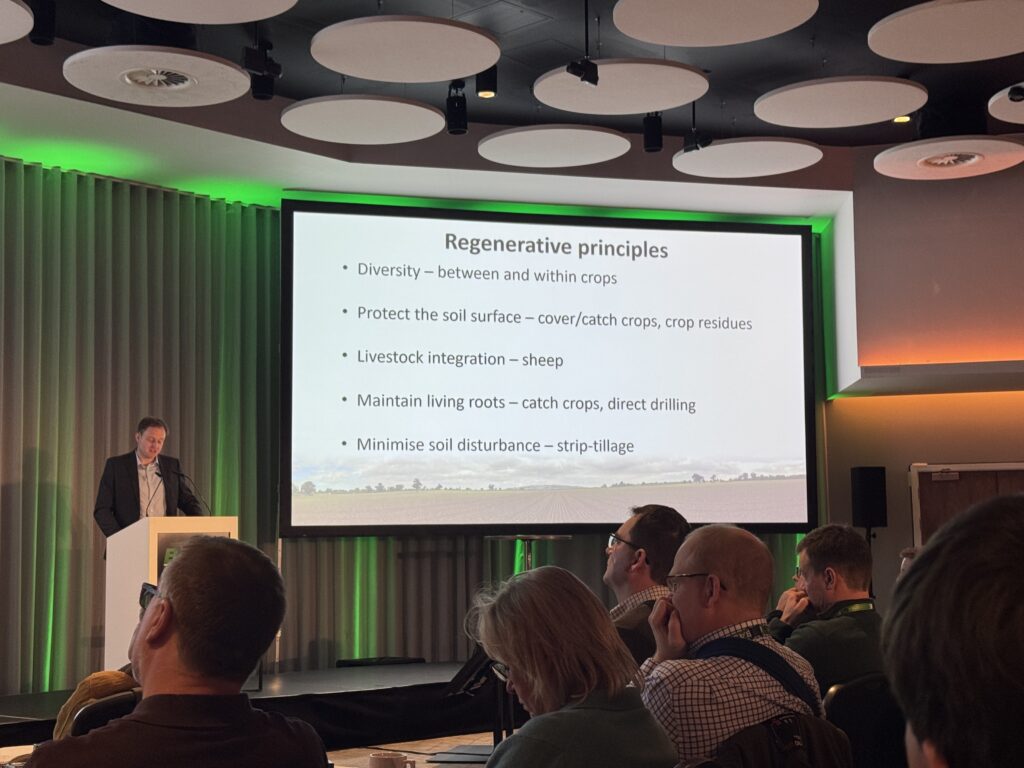
Building Soil Health to Build Farm Resilience
Speaker: Stuart Johnson, Farmer from Northumberland
Stuart Johnson was refreshingly candid about his motivation for adopting regenerative agriculture—it started purely as a financial decision. Over time, however, he has witnessed profound improvements in soil health, resilience, and overall farm profitability.
By integrating agroforestry, diverse livestock species, and compost teas, Stuart has built a more self-sustaining system. He emphasized that while mixed farming allows for more comprehensive regenerative practices, arable farmers can still adopt many principles to improve soil health and profitability.
Key points:
- Mixed farming systems offer greater flexibility in regenerative practices.
- He has integrated agroforestry, compost teas, and diverse livestock.
- Regen practices have built long-term farm resilience.
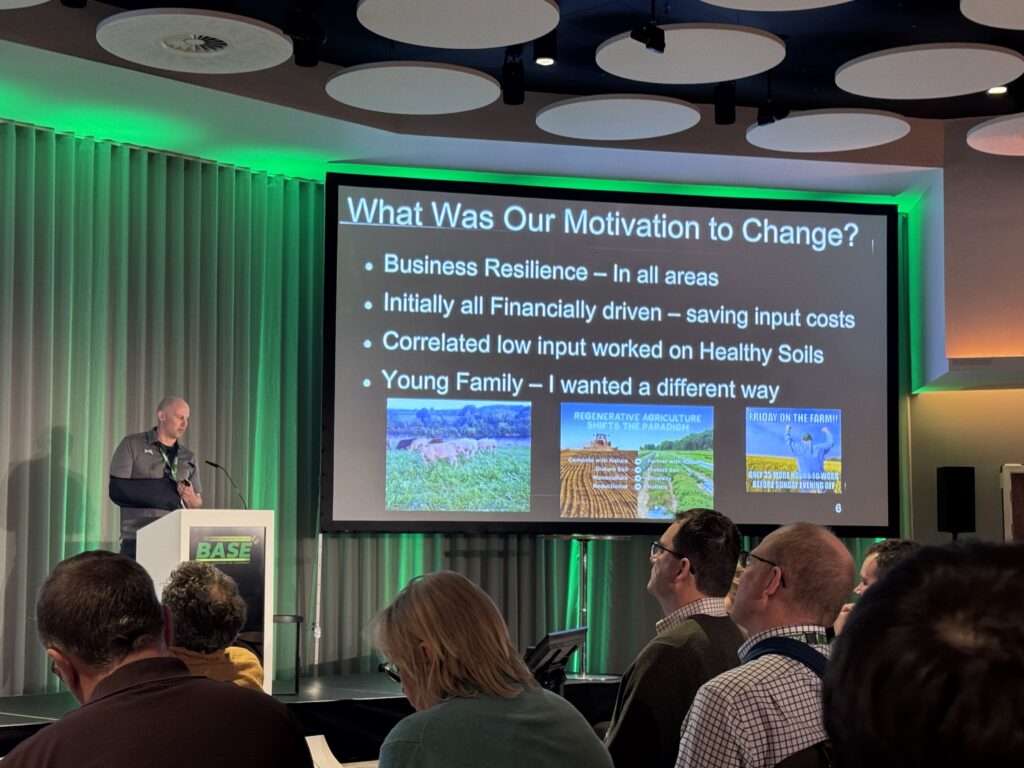
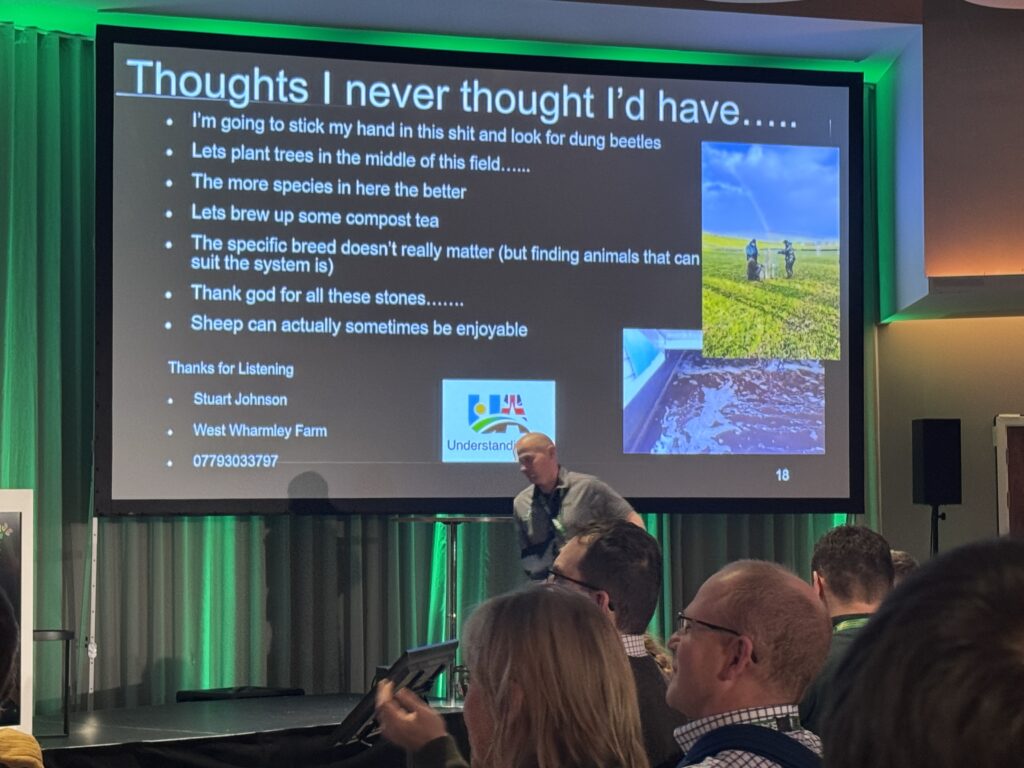
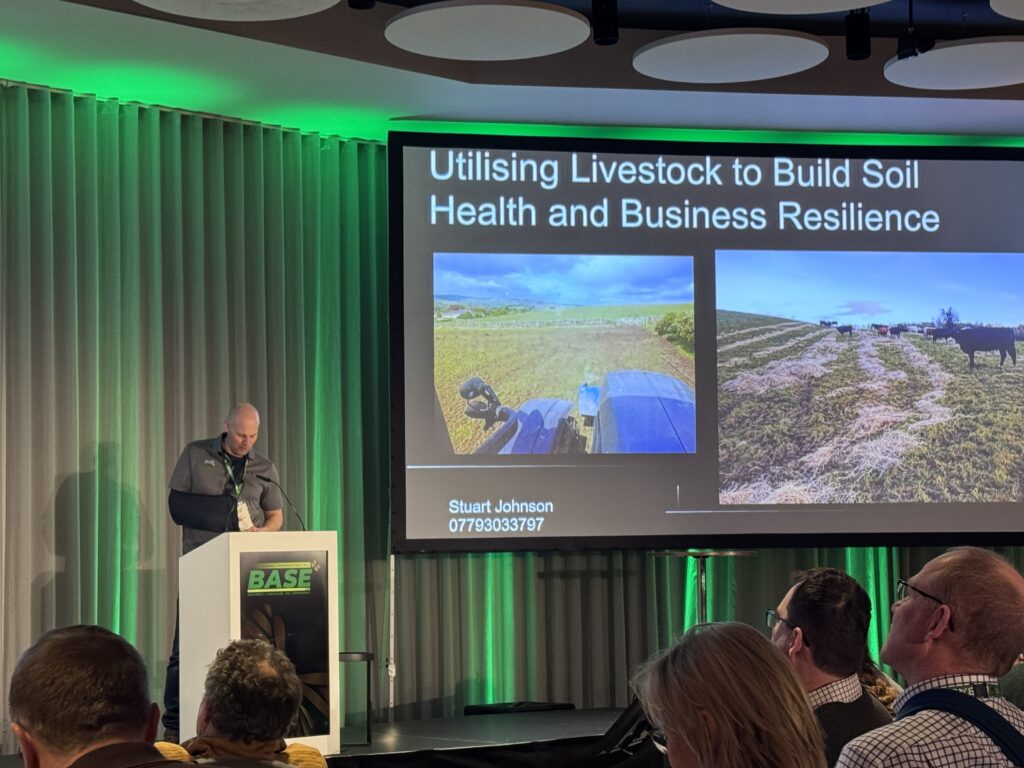
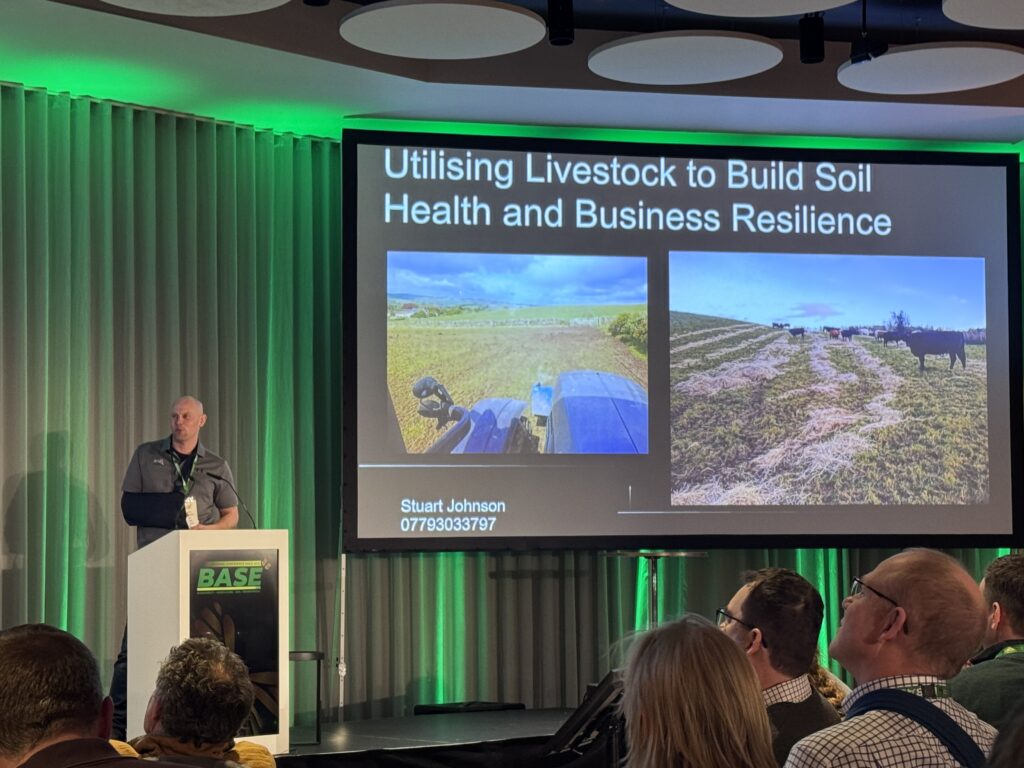
Using SFI to Stay Afloat While Underwater
Speaker: Rob Buckley, Farmer from Yorkshire
Rob Buckley shared his journey from aerospace engineering back to his family farm during COVID-19. His talk focused on the challenges and opportunities within the Sustainable Farming Incentive (SFI) scheme.
His farm has suffered from severe flooding, but he highlighted how SFI measures such as overwinter bird seed mixes have unexpectedly helped control ryegrass weeds. He cautioned that while SFI payments are helpful, once enrolled, flexibility is limited, making it difficult to pivot when conditions change.
- Highlighted bureaucratic rigidity in SFI schemes.
- Showcased the positive impact of AHL2 bird mixes on ryegrass suppression.
- Used humour to reflect on the adaptation challenges faced by many farmers. Which is a good point – I think you need a good sense of humour to be a regen farmer – as you do have your failures along the way.

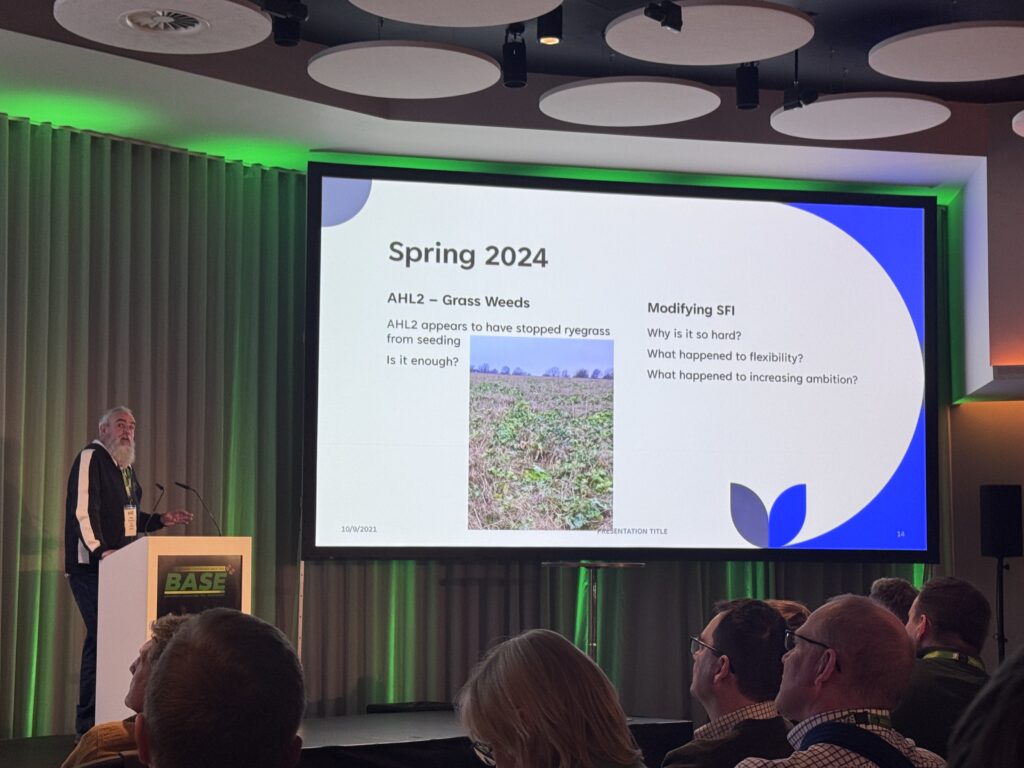
Day 2
Regenerating Soil with Soil Biology – Back to Basics
Speaker: Dr. Kris Nichols, Food Water Wellness Foundation
Dr. Kris Nichols delivered a captivating talk on soil biology, emphasizing the role of mycorrhizal fungi in nutrient cycling and plant health. She challenged misconceptions, including the claim that soil formation takes thousands of years, arguing that with proper management, soil can regenerate much faster.
Takeaways included the importance of maintaining continuous plant cover, promoting carbon sequestration, and fostering beneficial microbial interactions. She stressed that no-till “stops the bleeding,” but true soil regeneration requires active biological management.
Key points included:
- Carbon is the foundation of soil health, and regenerative soils store more carbon.
- No-till prevents further loss but must be combined with biological inputs.
- Farmers should embrace biodiversity to enhance soil function.
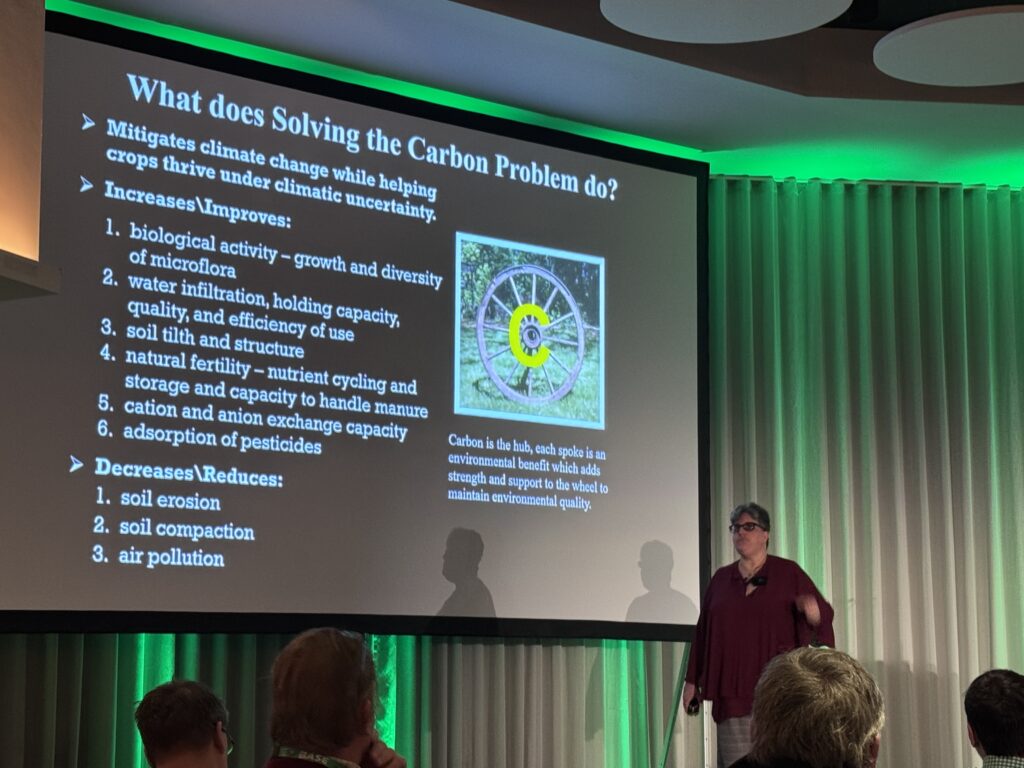
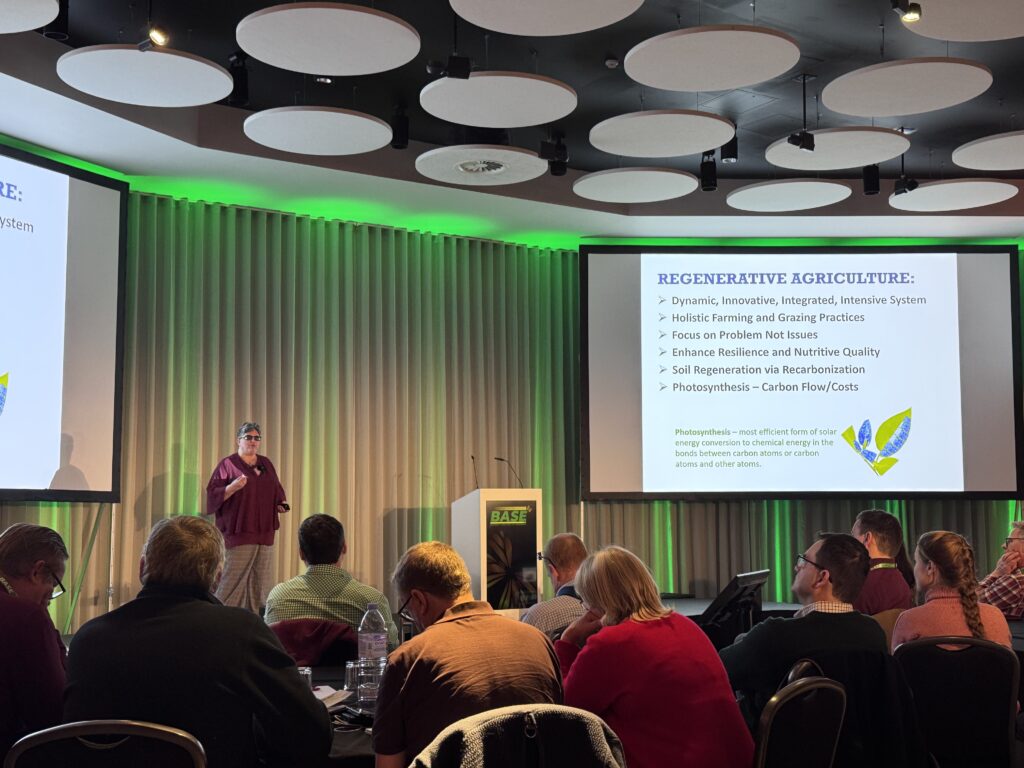
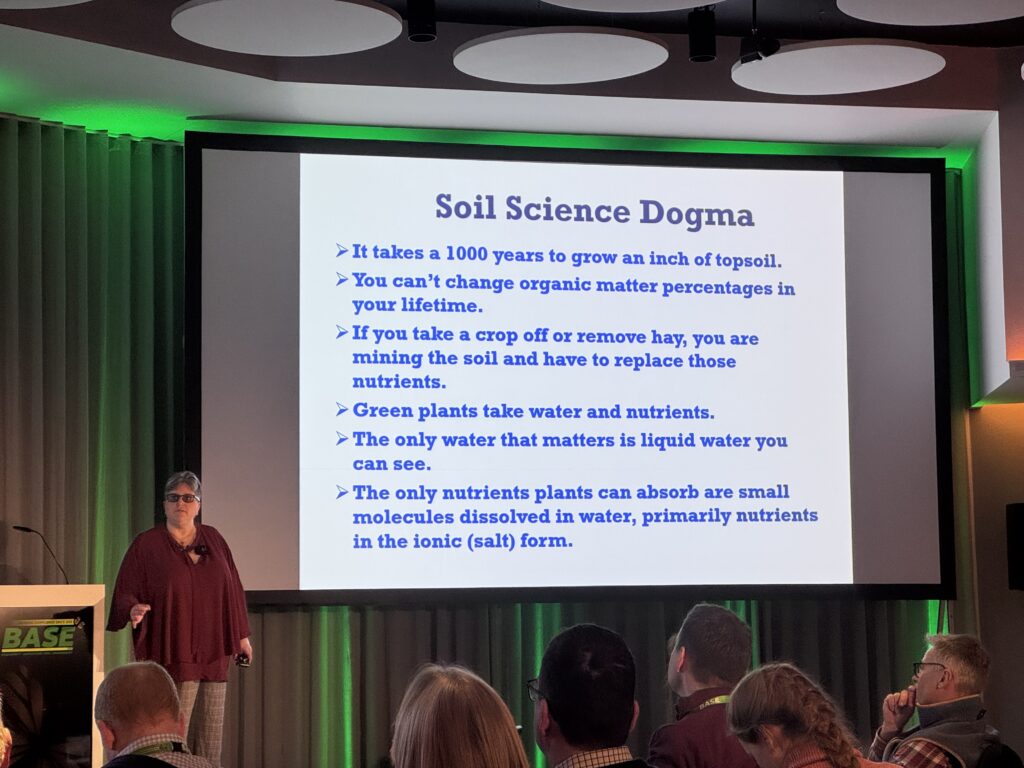

Nature-Based Food Solutions
Speaker: Professor Wendy Russell, University of Aberdeen
Professor Russell explored how crop selection can enhance both human health and agricultural sustainability. She discussed research on barley-based bread, showing its potential health benefits. She also examined alternative protein crops such as fava beans, lupins, buckwheat, and peas.
Hemp emerged as a promising crop, offering a sustainable alternative to imported soy. Trials showed that feeding hemp meal to chickens improved egg nutritional quality, raising vitamin and omega-3 content. Despite these benefits, supply chain inertia remains a barrier to widespread adoption.
Key points:
- Barley bread trials showed potential health benefits.
- Hemp production presents a low-carbon alternative to imported soy.
- Feeding trials on chickens demonstrated significant nutritional improvements in eggs when using hemp-based feed.
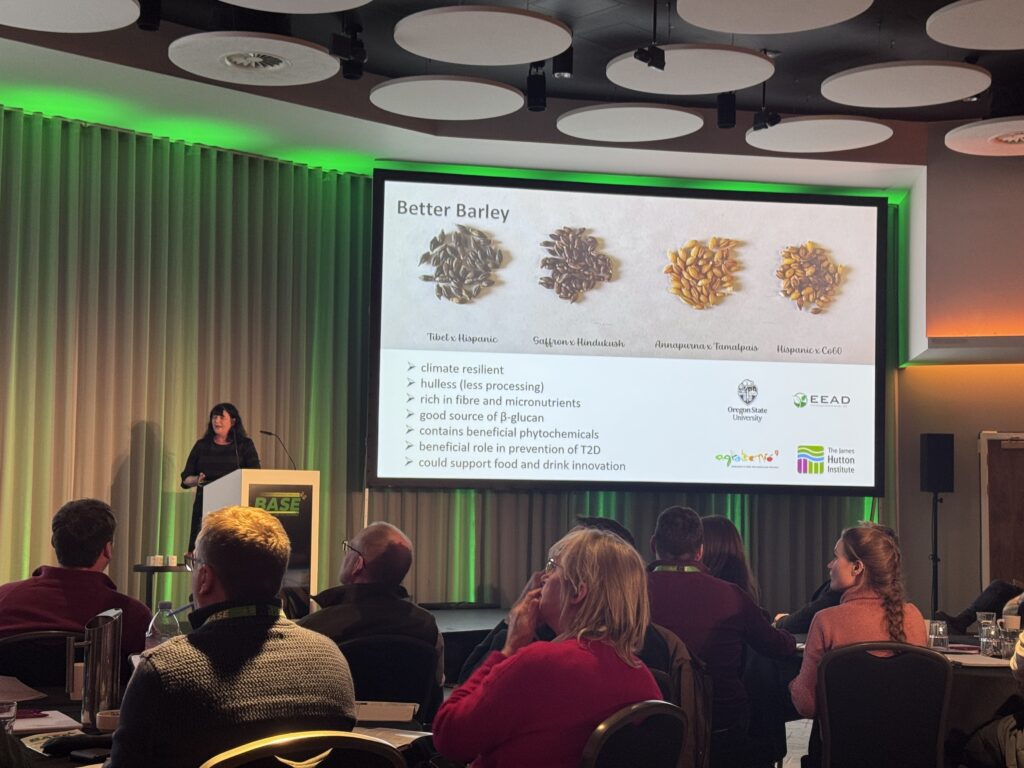
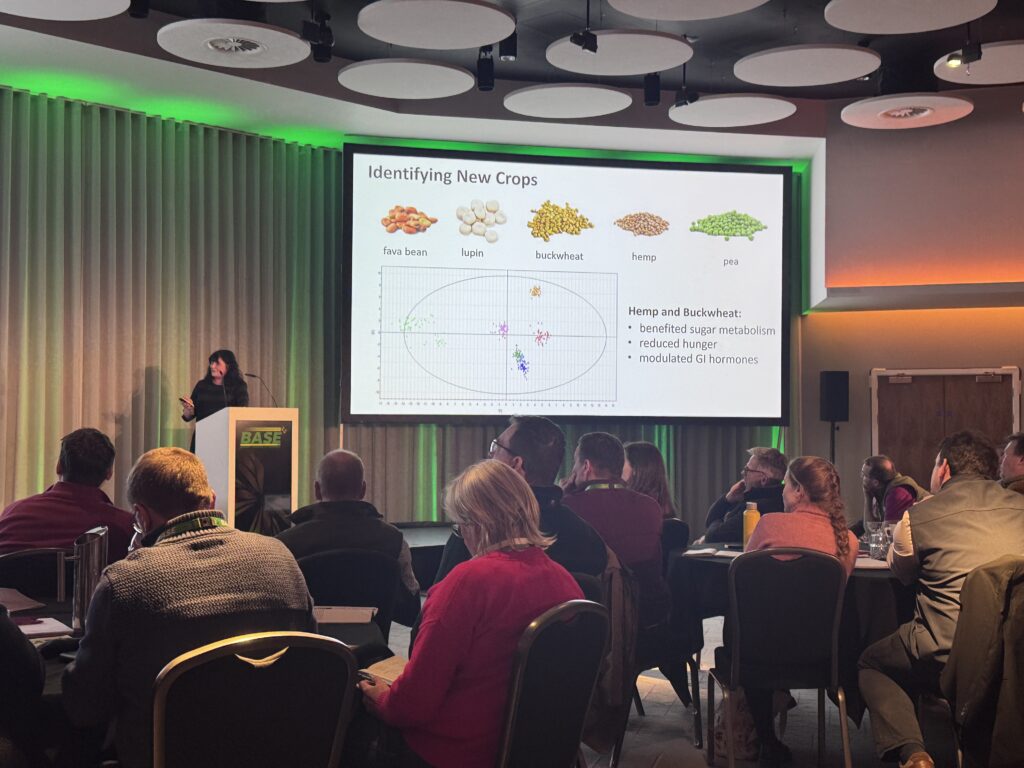
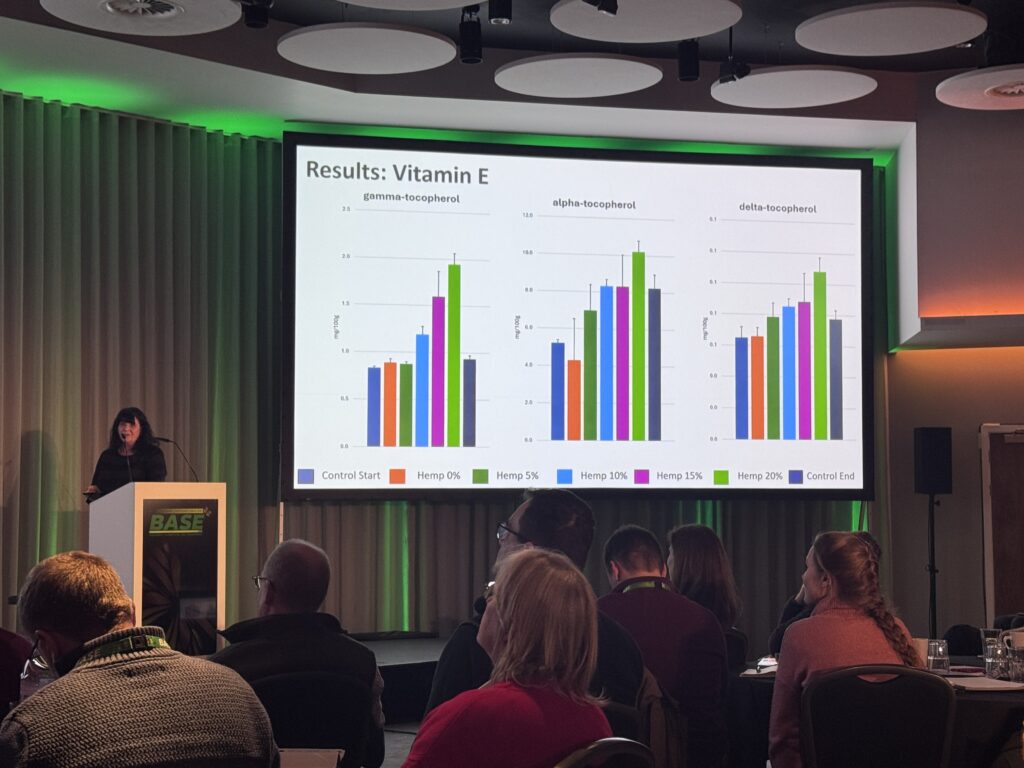
The Impact of Regenerative Farming on Soil Organic Carbon
Speaker: Charlotte Cook, Indigro Agronomist
Charlotte Cook presented compelling data from Indigro’s farm network, demonstrating that regenerative systems can maintain high yields while reducing inputs. She highlighted how strategic use of SFI schemes can improve break crop margins. Her message was clear: regenerative agriculture isn’t just about sustainability—it’s also good business.
Charlotte presented survey data from Indigro farmers showing that regen farms can maintain high yields while reducing inputs.
- Farms with over six years of regenerative practices showed improved resilience.
- Leveraging SFI schemes can enhance financial returns.
- Regen agronomy is economically viable when applied strategically.
Some great results on the sequestration of regen farms and their ability to still hit high yields. This data allows Indigro to show their customers that you can move to a regen system on the basis of its economics. “It’s just good farming”. But it was noted that these regen farms are doing a lot of regen activities and have been doing it for over 6 years. So have already built in resilience to their soils.
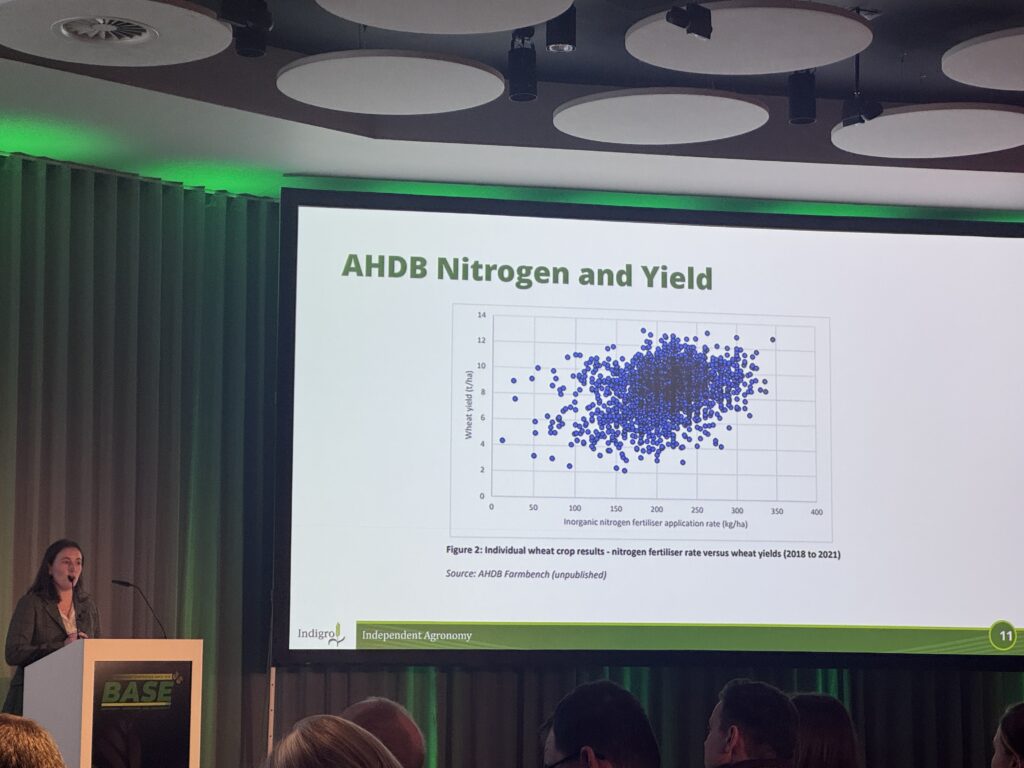
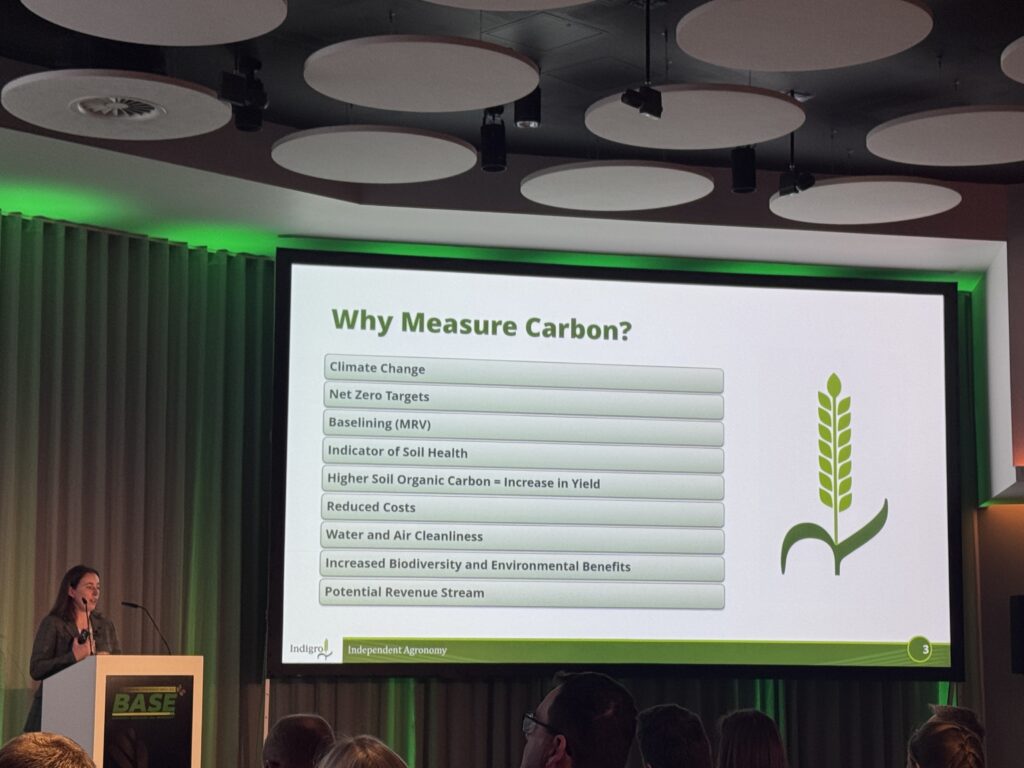
Reaching Across the Aisle
Speaker: Tom Martin, Farmer and Storyteller
Tom Martin gave an engaging talk on farmer communication. He emphasized that farmers are among the most credible sources of information about food production. By sharing their stories, they can build consumer trust and demand for regenerative products.
Tom emphasized the importance of farmer-led communication in educating consumers.
- Farmers are among the most trusted sources of agricultural information.
- Encouraged farmers to share their regen journey with the public.
- Demonstrated how storytelling enhances consumer engagement.
- You are a credible voice and that you should get involved in sharing your voice to your consumers.
This talk also showed that practice makes perfect. Tom was easily the best speaker over the two days. He natural and compelling way of speaking was clearly from the amount of it he has done before and probably a natural talent to begin with. But I know from my own experience the more you do, the better you get.
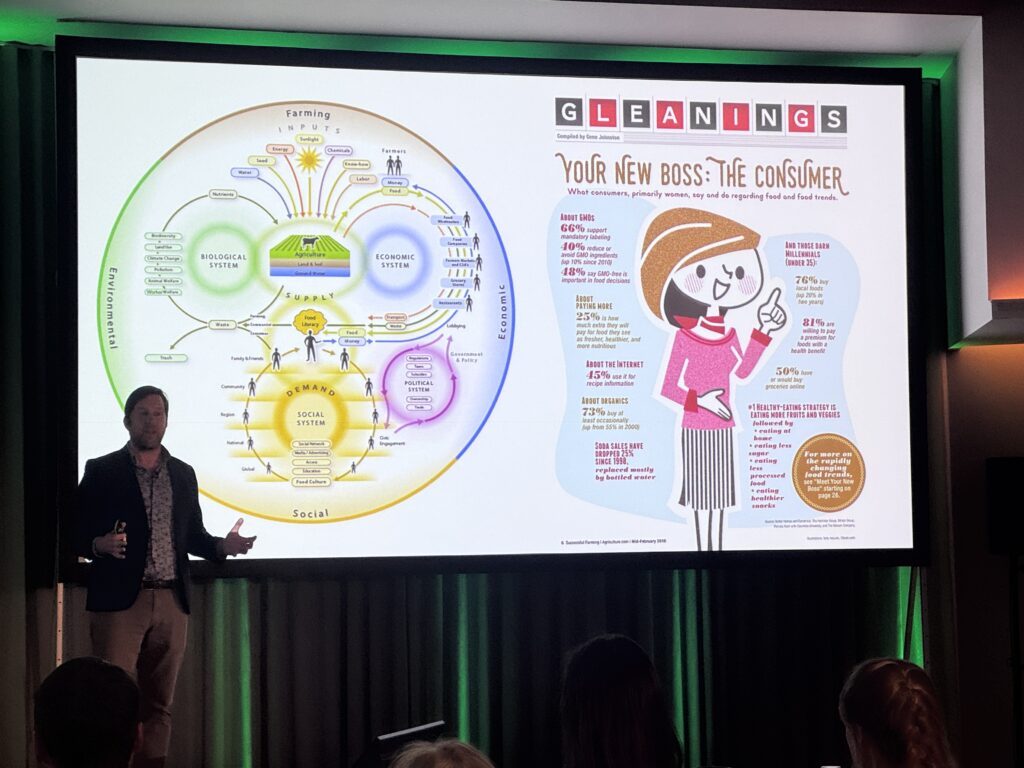
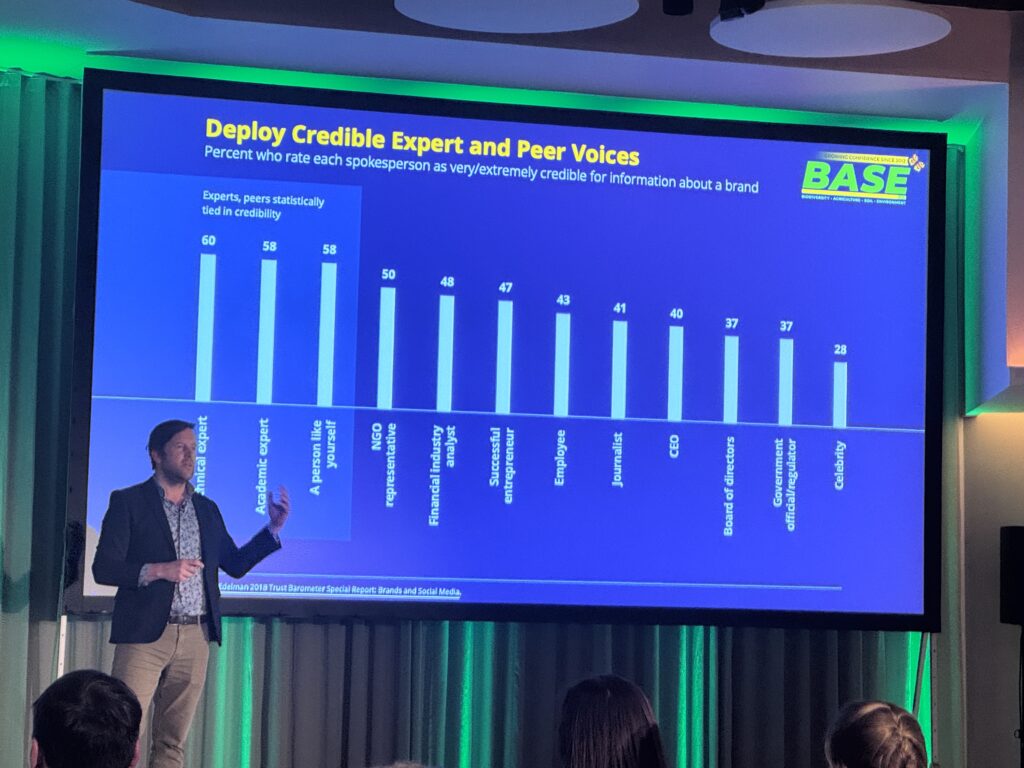
Report from Sustainable Food Conference
Speakers: Ana Reynolds & Seb Richardson
Ana and Seb summarized key takeaways from Sustainable Food 2025:- Retailers struggle with Scope 3 emissions and regenerative transition goals.
- Supermarkets lack clear strategies and await government mandates.
- Farmers’ groups like BASE UK could play a role in shaping UK policy.
It seems that the processors and supermarkets are waiting for the government to push changes to them. They can reformulate if they want to, but only seem to change when they have to. Again they could change labelling if they wanted to. The big questions is where is the money for systems change going to come from? Retailers don’t want it to come from them.
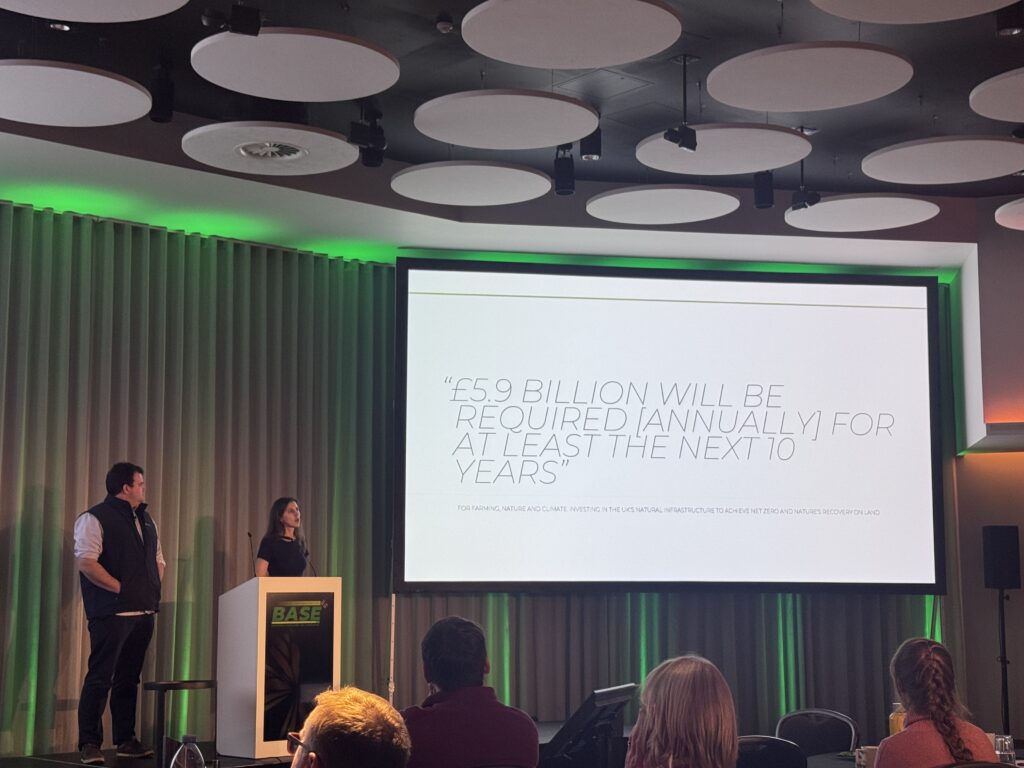
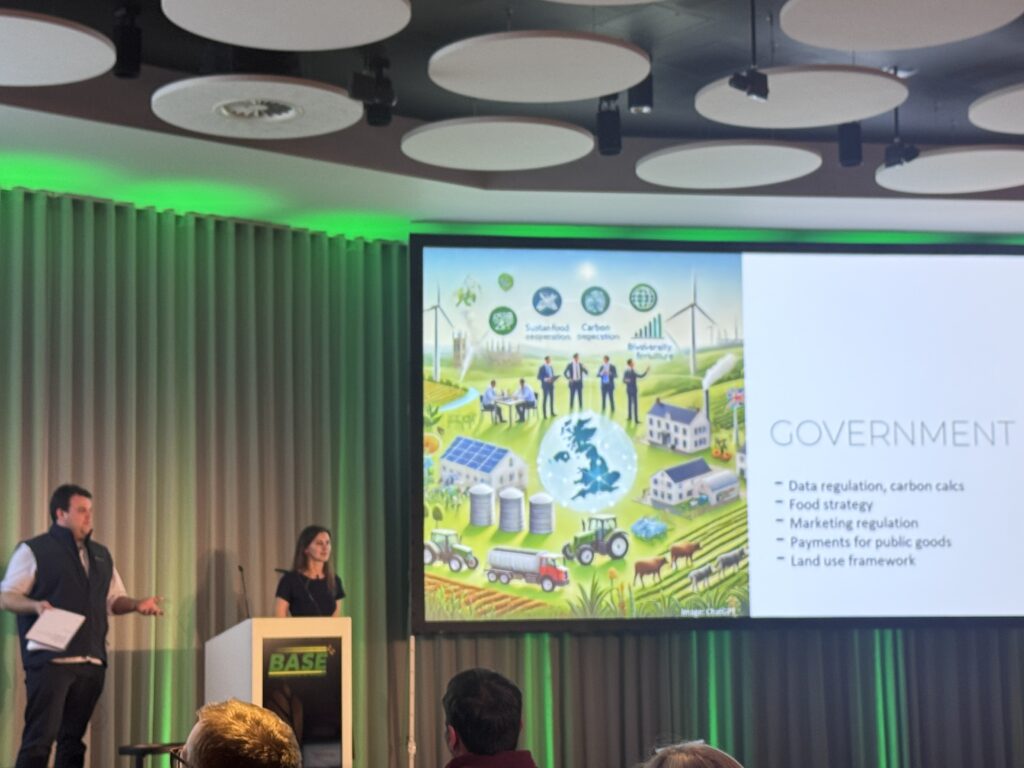
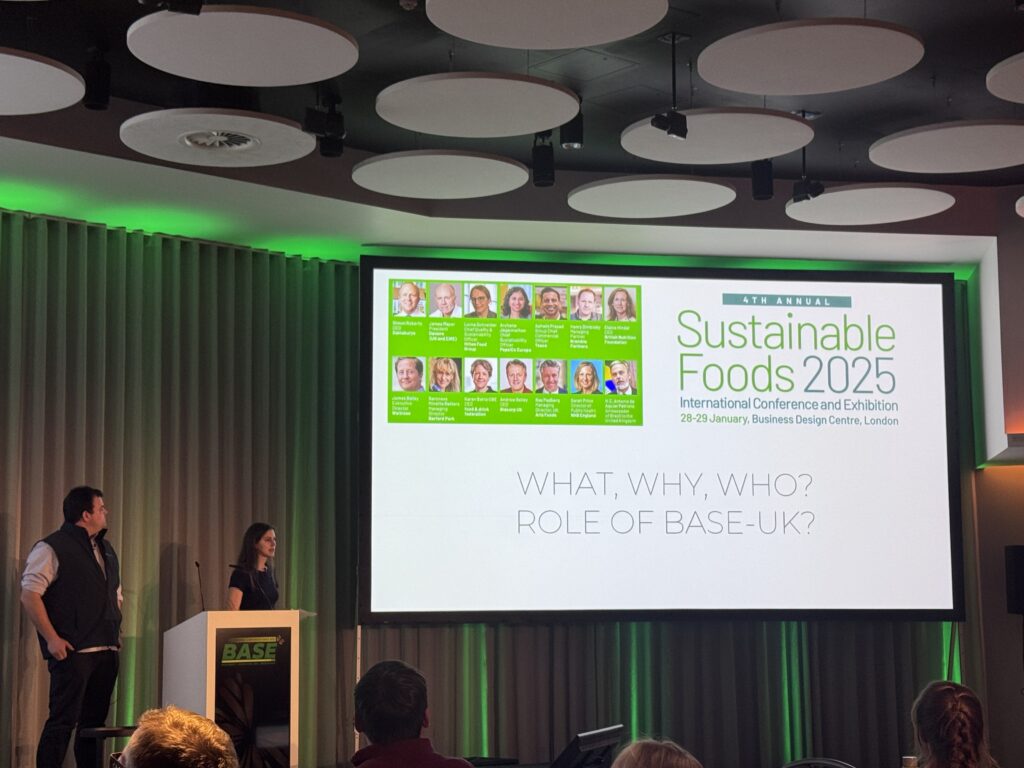
Wrap-Up
Speaker: Edwin Taylor, Chairman, BASE UK
Edwin closed the conference with a simple yet powerful message:“It’s all about better farming.”
Not just from a profit basis, but also for future generations to inherit the farm in a better condition as well as producing better food for the public as well.
Regenerative agriculture is about profitability, sustainability, and improving farms for future generations. The conference reinforced that success in regen farming comes from continuous learning, adaptation, and farmer-to-farmer collaboration.
Final Thoughts
The BASE UK Conference 2025 provided insightful discussions on soil health, regenerative practices, and policy challenges. Each speaker brought unique perspectives, reinforcing that regen farming is an evolving journey rather than a fixed destination.
As always, it wasn’t just the talks that made the event—it was the conversations, connections, and, of course, did I mention the time spent in the bar!
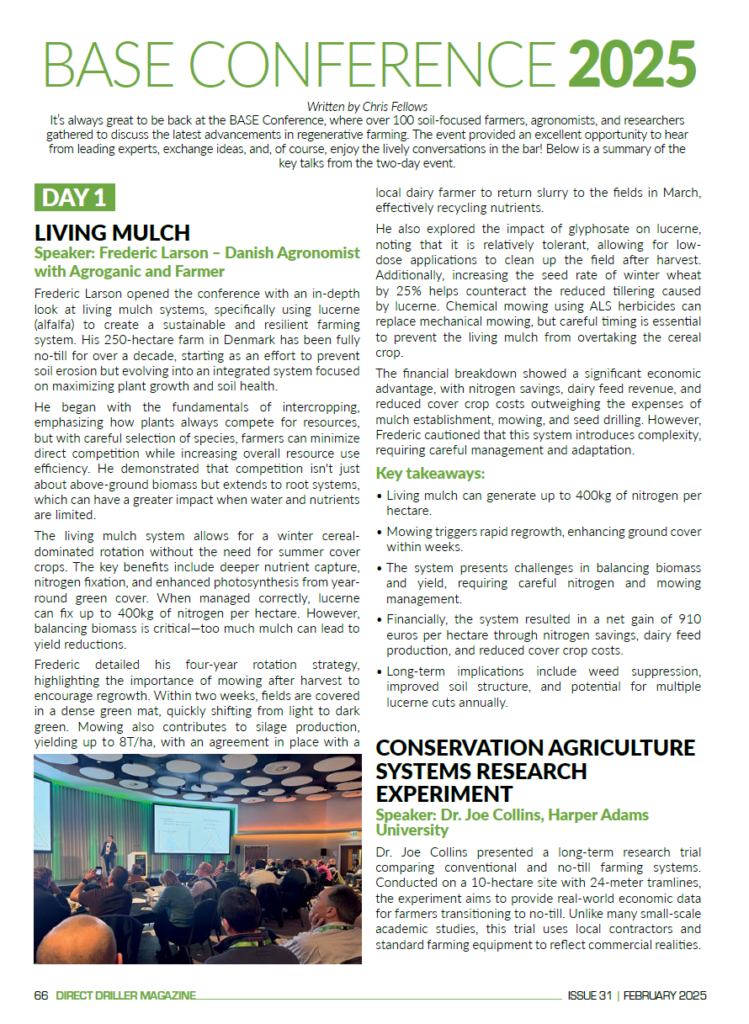
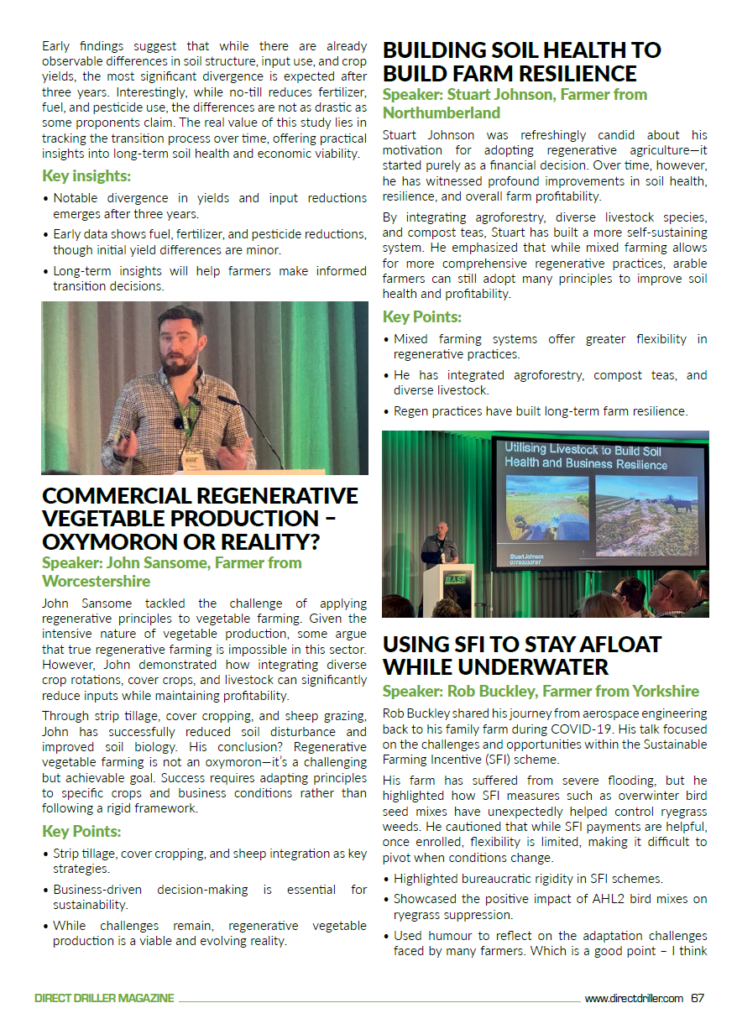
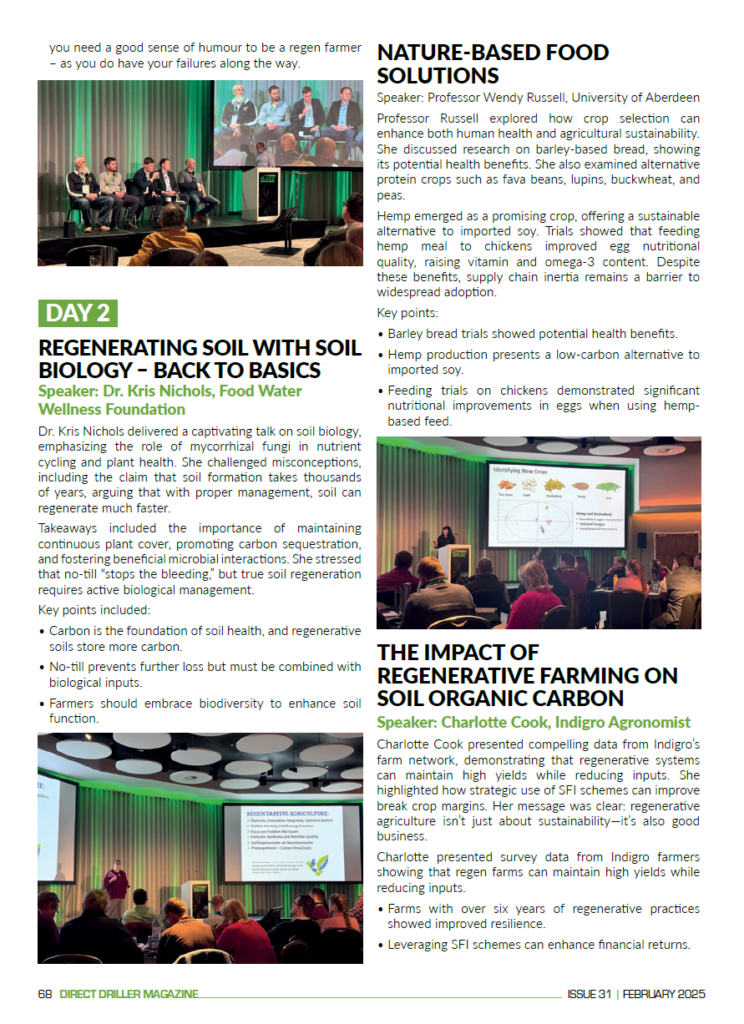
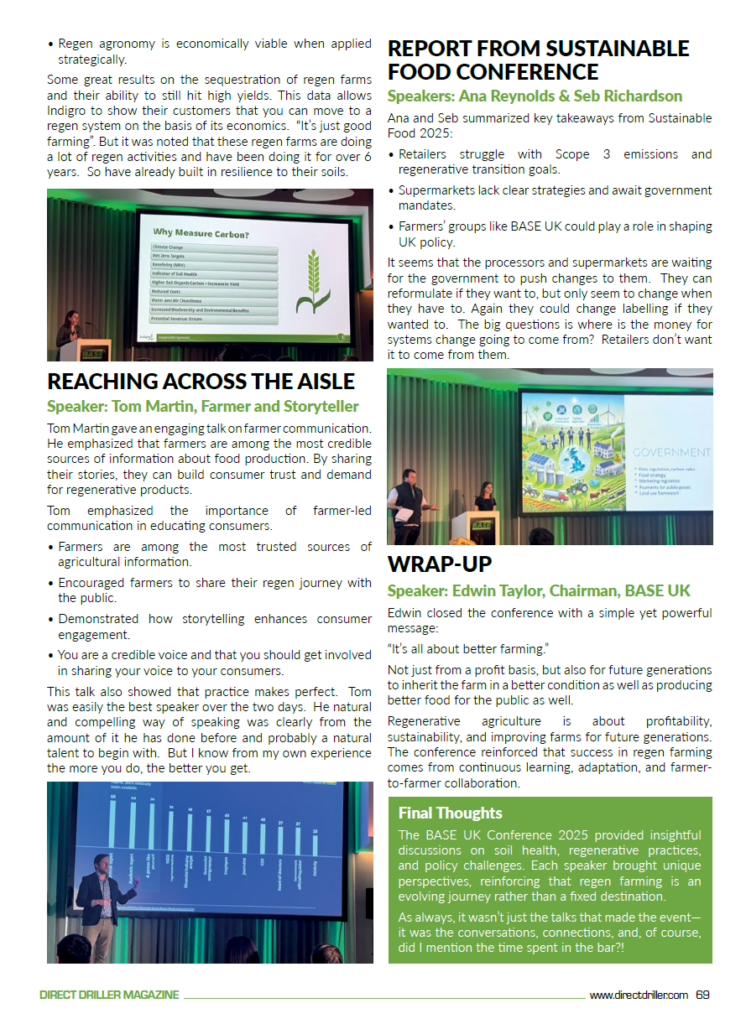
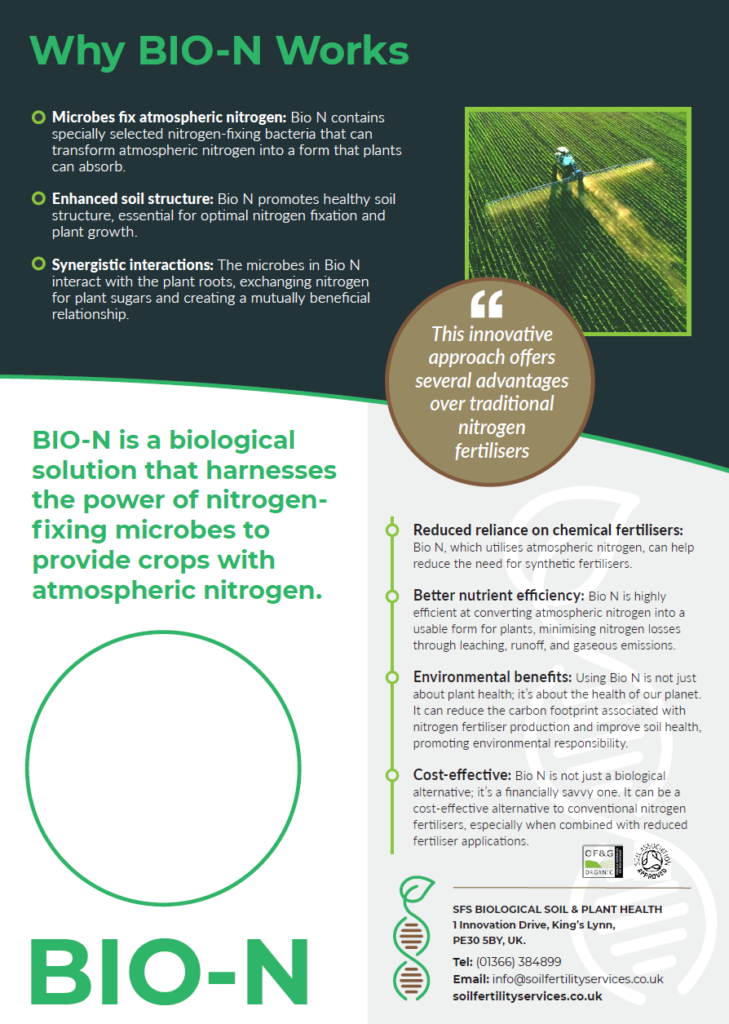
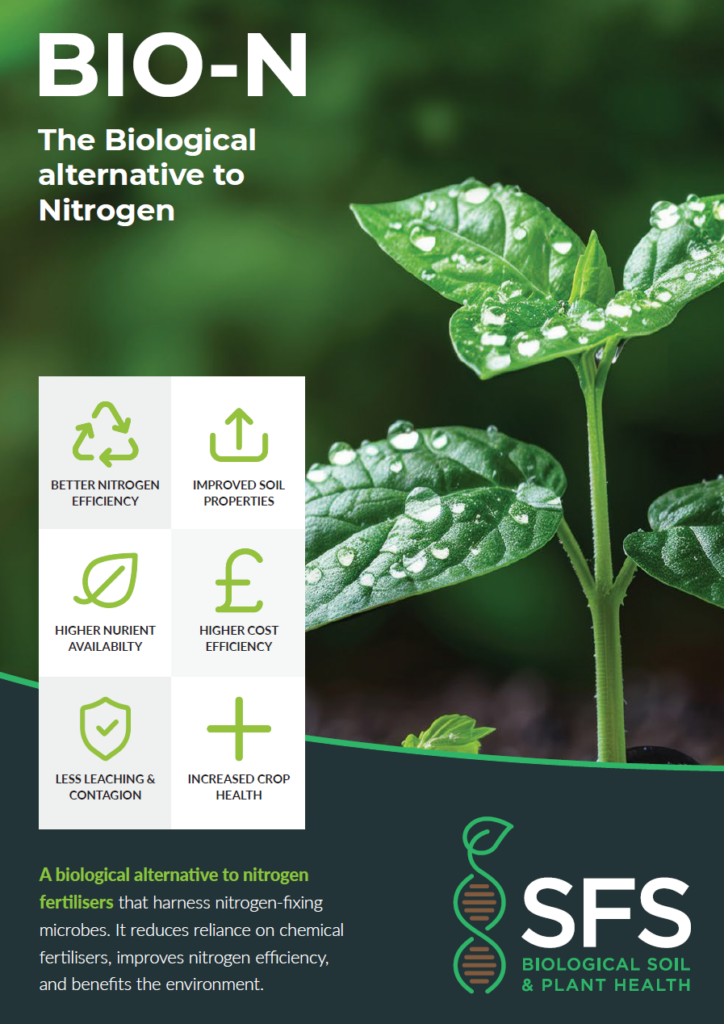
-

How an arable farming system in Kent is balancing nature and financial viability
Written by Nature Friendly Farming Network

Under the stewardship of award-winning farmers James and Emma Loder-Symonds, Nonington Farms exemplifies how farming can embrace nature-friendly practices while maintaining profitability and producing high-quality crops. Their multi-generational farm serves as a vibrant showcase, welcoming everyone from school groups to farm clusters.
In 2013, James and Emma Loder-Symonds made the decision to transition their conventional, multi-generational family farm in Kent to a fully nature-friendly operation. While the farm had traditionally focused on maximising food production to navigate the challenges of volatile global markets, James and Emma were determined to pursue a more sustainable path. Their vision prioritised nature, enhanced the environment, and strengthened the local economy.
The result was Nonington Farms, nestled in the rural countryside between Canterbury and Dover. Initially spanning 160 hectares, James and Emma expanded their operation by establishing a contract farming business, adding an additional 1,000 hectares. This predominantly arable enterprise involved working on a diverse range of soils, from brick-earth to chalk.
About three years into their journey, James and Emma made the decision to enroll Nonington Farms in the Higher Tier of the Countryside Stewardship (CS) scheme. By around 2017, they began implementing fundamental changes to their farming system. Previously, the business had been driven by the pursuit of high yields, but the significant inputs required often led to sharp fluctuations in costs, exacerbated by volatile market prices.
“When we were fully reliant on high-input farming, we had no guaranteed income and were completely at the mercy of the global market,” James explains. “Some areas of the farm were a constant struggle, requiring significant inputs just to break even.”
The first major change was eliminating artificial phosphorus and potash, which immediately saved around £70 per hectare. Next, the farm’s nitrogen inputs came under scrutiny. At the time, their Group 1 milling wheat received about 300 kilograms of nitrogen per hectare, but with yields plateauing, a detailed analysis of nitrogen use and soil health revealed opportunities for a more precise and efficient approach. By adopting variable rate technology, nitrogen application was reduced from 25-30 kilos per tonne of wheat to a much leaner 14-17 kilos.
This shift not only curbed input costs but also stabilised profitability, as James notes: “With prices fluctuating wildly, this strategy has made our business far more consistent.”
When we were fully reliant on high-input farming, we had no guaranteed income and were completely at the mercy of the global market. Some areas of the farm were a constant struggle, requiring significant inputs just to break even.
James Loder-Symonds
The CS scheme, which provides payments to farmers for implementing a range of nature-friendly practices, has been instrumental in gaining the support of landowners contracting James and Emma to farm their land. According to James, what resonates most with people about the nature-friendly approach is how it enhances the financial resilience of farm businesses. “They were receiving a guaranteed income through the CS scheme for taking relatively unproductive land out of arable rotations,” James explains. “It was a win for them and a win for nature.”
At Nonington Farms, one-fifth of the land is now dedicated to stewardship. This decision was guided by a detailed analysis of yield maps, which highlighted areas where production simply wasn’t justifying the input costs. By removing these less productive sections, the farm has also optimised the use of machinery.
The crop selection at Nonington Farms has also evolved to align with the nature-friendly approach. While wheat remains the primary crop, some varieties with low disease resistance – and thus a higher fungicide requirement – have been removed from the rotation. The farm now cultivates a diverse range of crops, including spring barley, spring oats, oilseed rape, and winter beans, alongside the establishment of herbal leys.
Between 30% and 40% of the grain commands a premium price by being marketed under sustainable schemes. The farm balances contracts with major players like national bakeries and smaller initiatives, such as growing heritage wheat – a venture they hope to expand in the future.

Nonington Farms employs a long crop rotation cycle of six to seven years, interspersed with cover crops between cash crops. Where soil health is poor or fertility needs improvement, James uses annual cover crops or establishes herbal leys to allow the land to rest and regenerate.
Cover cropping at Nonington Farms began with catch crops planted between wheat and winter beans. Maintaining living roots in the soil year-round improved its health, enhanced water filtration, and contributed to overall sustainability. A key benefit of this practice is the guaranteed payment available under the CS and Sustainable Farming Incentive (SFI) schemes for both herbal leys and cover cropping, providing crucial financial stability in an often unpredictable agricultural market. Additionally, the farm receives support from Southern Water through a nitrogen minimisation and reduction scheme.
Livestock owned by new entrants grazing on two of James and Emma’s farms play an integral role in this system. They feed on overwintered cover crops and herbal leys, naturally fertilising the soil without relying on artificial inputs. While monocropping persists in some areas of Nonington, the expansion of herbal leys is being encouraged to increase biodiversity, introducing a wider variety of plants, grasses, and wildflowers.
James highlights the tangible benefits of this approach, noting that the combination of livestock grazing and cover cropping has boosted yields on their winter wheat, further demonstrating the value of this nature-friendly strategy.

James and Emma are also enhancing the landscape at Nonington, planting around a kilometre of hedges and adding approximately 400 trees each year. These hedges, along with beetle banks, play a vital role in their integrated pest management (IPM) strategy, which relies on beneficial insects to control pests and diseases instead of using synthetic pesticides or chemicals. As a result, Nonington has not applied insecticide for four years, a significant achievement in their commitment to sustainability.
The diversity of production on the farm has also increased. Award-winning young nature-friendly farmer Jack Scott began his journey at Nonington, where he grows vegetables for local restaurants and markets. This move toward diversified, sustainable farming practices reflects the broader shift toward nature-friendly agriculture on the farm.
And it’s not just new entrants to farming that James and Emma are eager to engage with at Nonington. Co-sharing the farm with other small-scale food producers is one of the ways they aim to bring the local community closer to the farm’s work. Educating the public about the importance of nature-friendly farming and where their food comes from is central to their mission. Emma, a qualified teacher, oversees the educational side of the business. Each year, more than 1,500 visitors come to Nonington for educational tours, a part of their work supported under the CS scheme.
“There’s a real disconnect between food production, the environment, and the consumer,” Emma says. “Our visits cover everything from stewardship options like cover cropping and wildflowers to discussing the importance of buying locally produced, nutritious food. Being based in east Kent, we often welcome schools with children from deprived backgrounds, giving them a rare opportunity to experience open space. We also have a flour mill on site, so we take them there to make bread and show them how real, unprocessed food is made.”
James believes that if farming has an image problem, it is largely one of its own making, and he and Emma are determined to help repair the damage and bridge the divide. “If we’re honest, the general perception of farmers is that they don’t want people on their land,” James reflects. “The public has picked up on this, so it’s now up to us to break down that barrier. We hold open evenings on most of the areas we farm at least once a year, and we also organise farm welcomes, inviting the local community to visit us.”
He acknowledges there are challenges, such as when people stray off footpaths and damage crops, but emphasises the importance of communication. “We need to explain our farming system and what we’re doing,” James says. “We make it clear why we prefer people to keep their dogs on leads near nature habitats and pregnant livestock. We also explain that when the sprayer is out, it doesn’t necessarily mean we’re applying pesticides. It’s about having good signage that helps people understand what we’re doing.”
There’s a real disconnect between food production, the environment and the consumer. Our location in east Kent means we get schools with children from deprived backgrounds visiting, and it gives them a rare opportunity to enjoy open space.
Emma Loder-Symonds
Biodiversity at Nonington is flourishing, with James and Emma particularly proud of the habitats they’ve created for turtle doves – once common on agricultural land but whose numbers have sharply declined due to decades of intensive farming practices. Ground-nesting birds like skylarks are abundant, while one of the farms hosts small blue butterflies, and the entire farm is home to grey partridges. The diverse habitat of hedges, grass margins, and wildflowers is also a haven for yellowhammers. Experts regularly visit Nonington Farms to monitor and ring bird populations and to survey wildflowers, bees, and butterflies.
For James, seeing nature thrive on the farm is a key part of their vision. “Having records of the wildlife we’re supporting gives us a real boost, showing that our system is benefiting nature,” he says. “At some point, we hope to receive greater financial recognition for these efforts too.”

James also credits the work of Natural England for driving the biodiversity protection efforts at Nonington and other farms in the area. “They have been instrumental in developing our wildlife areas. By working one-on-one with farmers and encouraging them to join stewardship schemes, they are helping to transform the landscape around us through cluster groups,” James explains. “It’s about creating continuity from one farm to another. Even a 12-metre strip can become a nature corridor. The key is adopting a collective approach rather than focusing solely on individual farm efforts.”
James highlights that the East Kent Cluster Group, which Nonington Farms is part of, has been running for 25 years, and the positive impact across the landscape is becoming increasingly evident.
Ultimately, all this work stems from James and Emma’s vision of sustainable farming, encapsulated by the image of a three-legged stool. The three pillars of Nonington Farms are Grow, Learn, and Protect. ‘Grow’ refers to the economic and business sustainability of keeping the farm profitable, ‘Learn’ represents the educational and social sustainability efforts, and ‘Protect’ focuses on the environmental approach to farming in harmony with nature.
James and Emma’s efforts have been recognised, with them receiving the Environmental Champion Award from leading trade publication Farmers Weekly in 2023. “We were really thrilled to receive that recognition for the value we’re adding through what we’re doing,” James says. “For us, awards are a way of demonstrating that the system we’ve adopted really works.”

James and Emma have ambitious plans for the future. They have used two carbon toolkits to analyse their farms, and both have concluded that the farm is carbon-negative, sparking James’ growing interest in pursuing certification and credits for carbon sequestration. Their work with new entrants to farming and the local community has laid the foundation for what they hope will eventually become a more extensive local food network in Kent. Their efforts also aim to futureproof the farm, ensuring it remains a viable and vibrant place for generations to come, continuing the family tradition of involvement in agriculture.
“For us, the future is about adding more value, both in terms of the price of sustainable products and nutritionally rich food,” James explains. “We need a premium for what we’re doing, which enhances the environment while producing food. This approach has to be profitable. If we’re not economically viable, we won’t be here in a year or three years’ time. If our children want to take it on, we want to hand them something we can be proud of.”
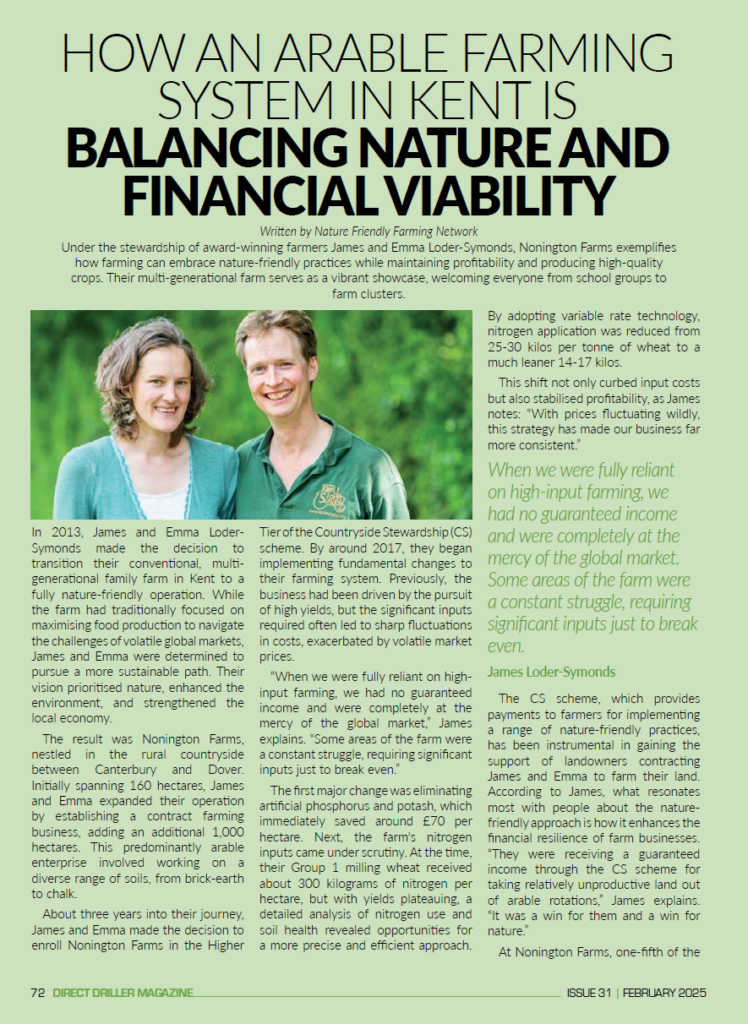
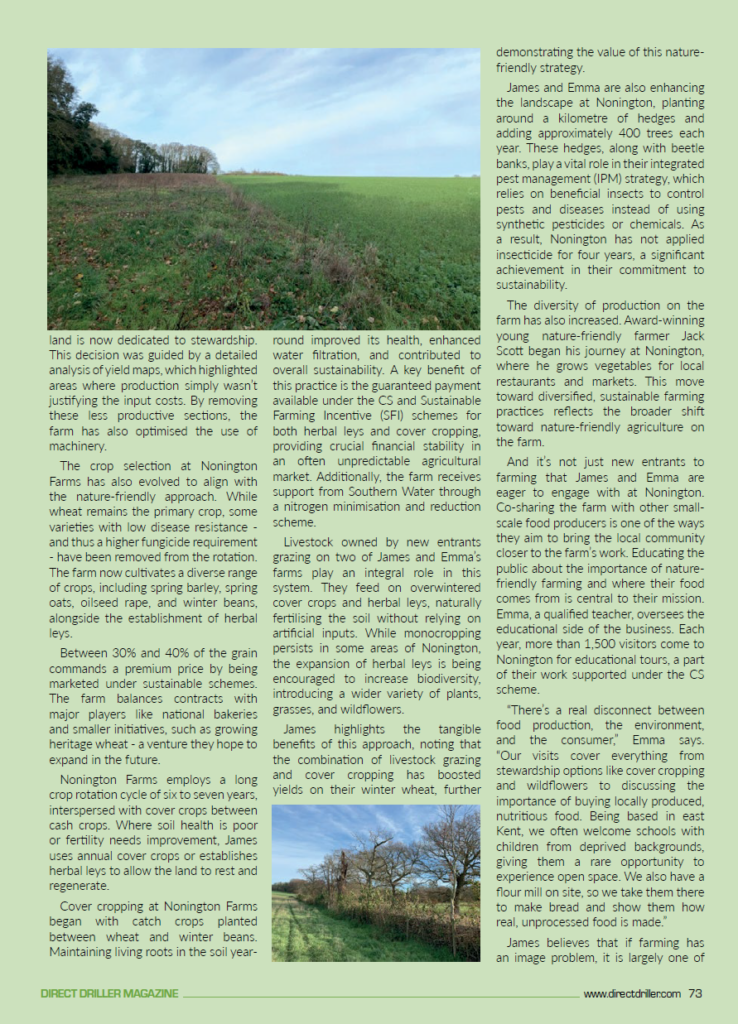
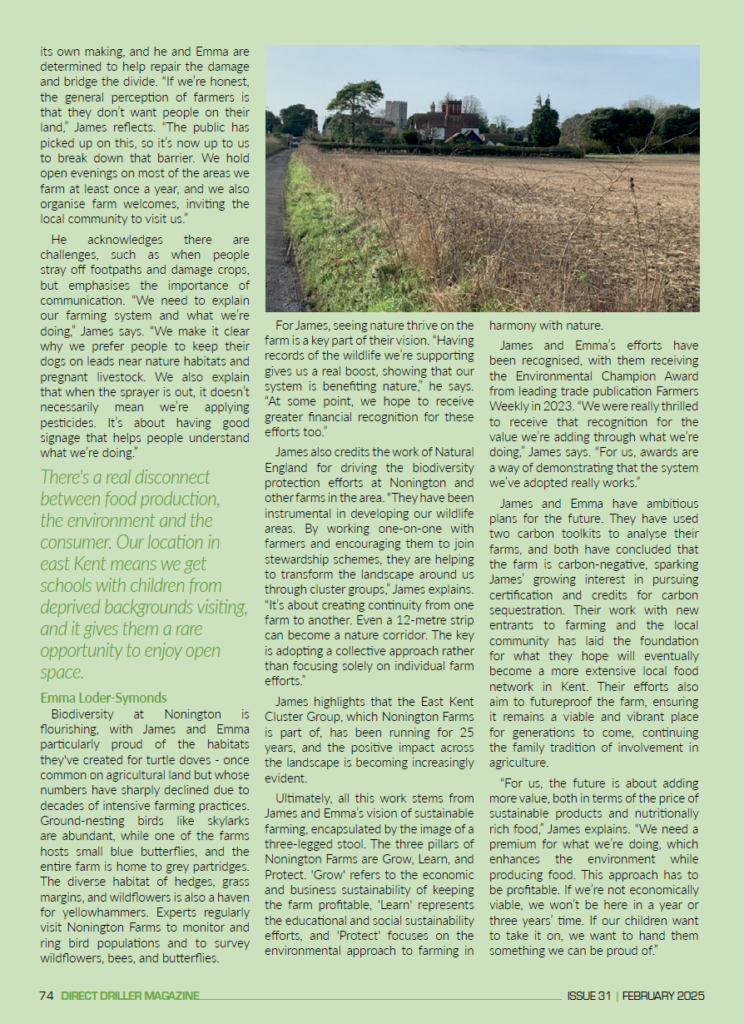
-

Enhancing Carbon Sequestration Through Regenerative Agriculture
By Indigro Ltd
Regenerative agriculture is proving to be a game changer in enhancing soil carbon sequestration and farm sustainability. Over four years, Indigro Ltd conducted a comprehensive survey of their clients, gathering invaluable data on how different practices influence soil organic carbon (SOC). The study, led by agronomist Charlotte Cook, provides a compelling case for integrating regenerative methods into modern farming.
To ensure accurate comparisons of crop carbon footprints and measure the impact of in-field changes without introducing too many variables, Indigro analysed the 637 separate carbon footprints, utilising the Cool Farm Tool. As members of the Cool Farm Alliance (CFA), this approach allowed Indigro to benchmark emissions, sequestration, and productivity across different farming systems with confidence. The tool provided critical insights into how regenerative practices influence emissions and sequestration, reinforcing their benefits for both economic and environmental sustainability.
The survey results demonstrated that the best regenerative farms consistently achieved the highest yields, the lowest emissions, and the best sequestration levels over all four years. This combination makes them the most profitable, as they produce better yields with lower input costs. Notably, the highest-emitting farms yielded an average of 9.2T for winter wheat, whereas the lowest-emission farms achieved a higher average yield of 9.7T across the four years, reinforcing the economic and environmental advantages of regenerative farming. Additionally, these farms are more sustainable, as they actively build soil carbon, improving long-term soil health and resilience. The study demonstrated that regenerative practices can be implemented without negatively impacting yield, proving that sustainability and productivity can go hand in hand.
Several regenerative techniques have emerged as particularly effective in improving sequestration. Cover crops and catch crops not only reduce erosion but also enhance microbial activity, leading to healthier soils. Spring barley under sown with herbal leys has been found to improve soil structure while reducing dependency on synthetic inputs. Permanent white clover understoreys offer a natural solution for nitrogen fixation and ground cover. Moreover, sustainable farming incentives (SFI) present a valuable opportunity for farmers to align financial benefits with environmental gains.
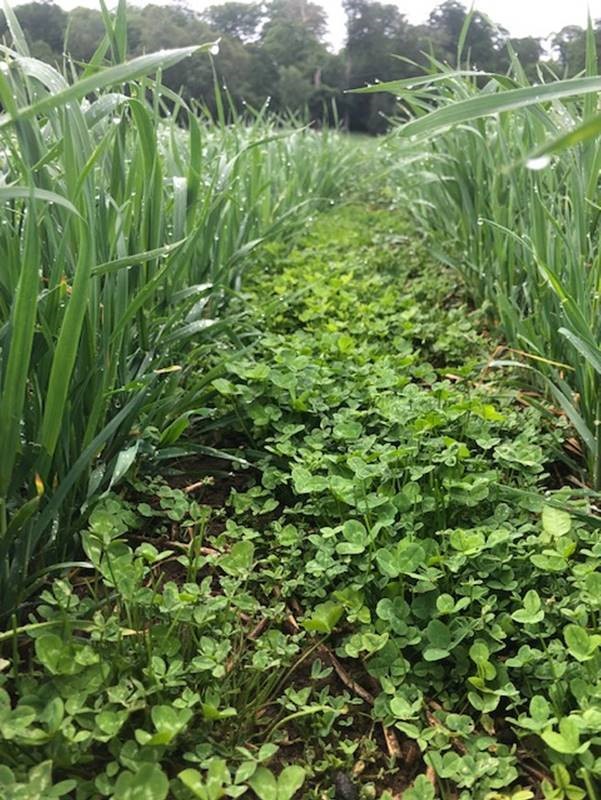
Clay content further determines a soil’s ability to retain carbon, highlighting the importance of tailored soil management strategies. A key factor in assessing a soil’s sequestration potential is the clay-to-carbon ratio. Clay particles protect organic carbon from microbial breakdown, allowing for greater long-term storage. Research suggests that a SOC-to-clay ratio of 1:8 corresponds to very good soil structure, while a ratio of 1:10 is the threshold between good and medium structural quality. Understanding this relationship enables farmers to benchmark their soil health and set realistic management goals for carbon sequestration.
The road ahead for carbon sequestration in farming lies in refining measurement techniques and enhancing confidence in carbon trading markets. With better tools and methodologies, farmers can be empowered to make informed decisions that not only improve soil health but also contribute to climate change mitigation.
At Indigro Ltd, we are committed to supporting farmers on this journey, integrating cutting-edge research with practical solutions to drive meaningful change in agriculture. Whether you’re looking for expert and independent agronomic advice or innovative strategies to enhance your farm’s sustainability and profitability, we’re here to support you.
Please visit www.indigro.co.uk for more information or connect with us on LinkedIn (@Indigro-Independent-Agronomy) and X (@Indigro1) to stay up to date with the latest insights and industry updates.
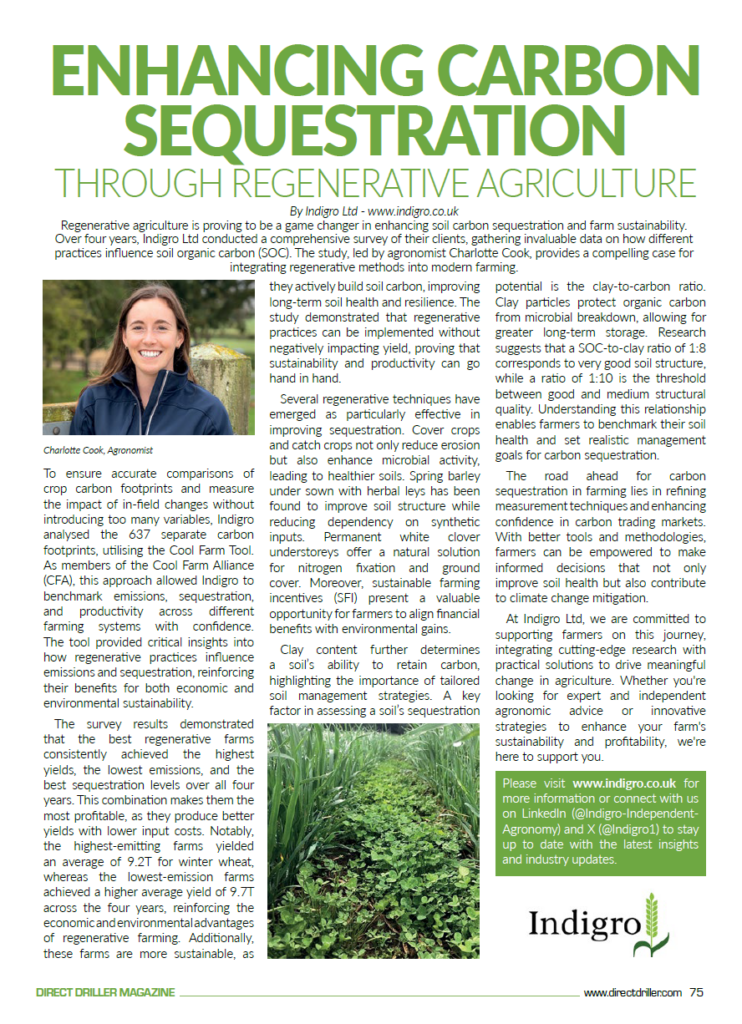
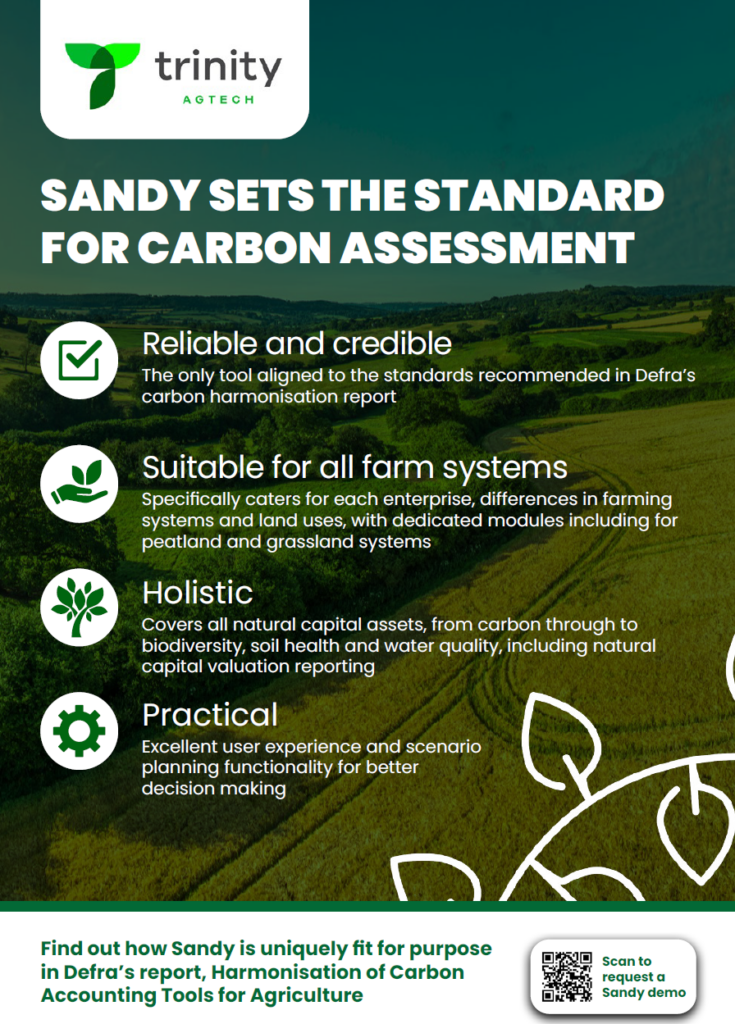
-
Issue 29 Contents
Found In:
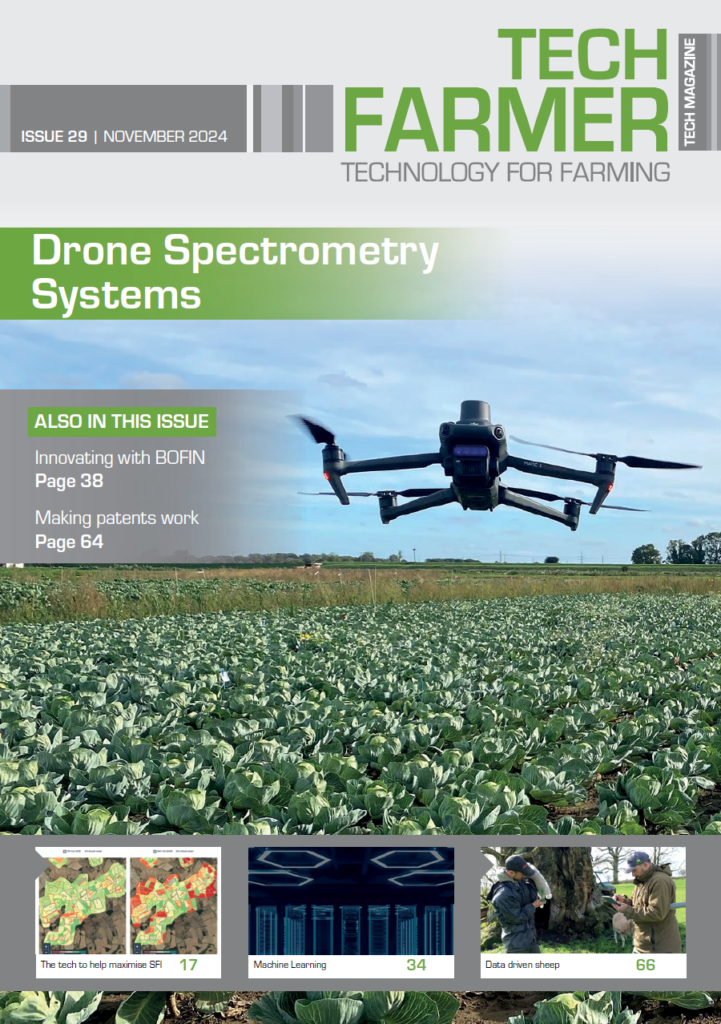
Inside this issue:
- Step or Incremental Change: A Strategic Decision
- Can Tech save Carbon from a crisis?
- Harnessing the power of the sun
- A Revolution in Bio-Positive Agriculture
- Living up to the SFI and its actions
- Using Farm Tech to Maximise and Manage the Sustainable Farming Incentive (SFI) Opportunity
- In pursuit of pixel perfect
- Agronomist in Focus – Simon Francis
- We can benefit from innovation
- First look: Innovations that might be on your farm
- Ensure Your No-Till Vision is 20/20 with Precision Technology
- New technology connecting the lab to the field
- Learning about machine learning
- Farm management software gets an EasyPlan
- The optics of pest invasions
- Leveraging NDVI for Sustainable Land Management: Enhancing Natural Capital for Farmers and Landowners
- OSR monitoring network strengthened to help predict CSFB migration
- Safety and stewardship with closed transfer systems
- 3 Reasons Why Regen Farmers Should Use More Precision Technology
- Digital Technology Farm Network explores data-driven ‘fields of the future’
- Patents – how to make them work for you
- Data driven sheep management
-
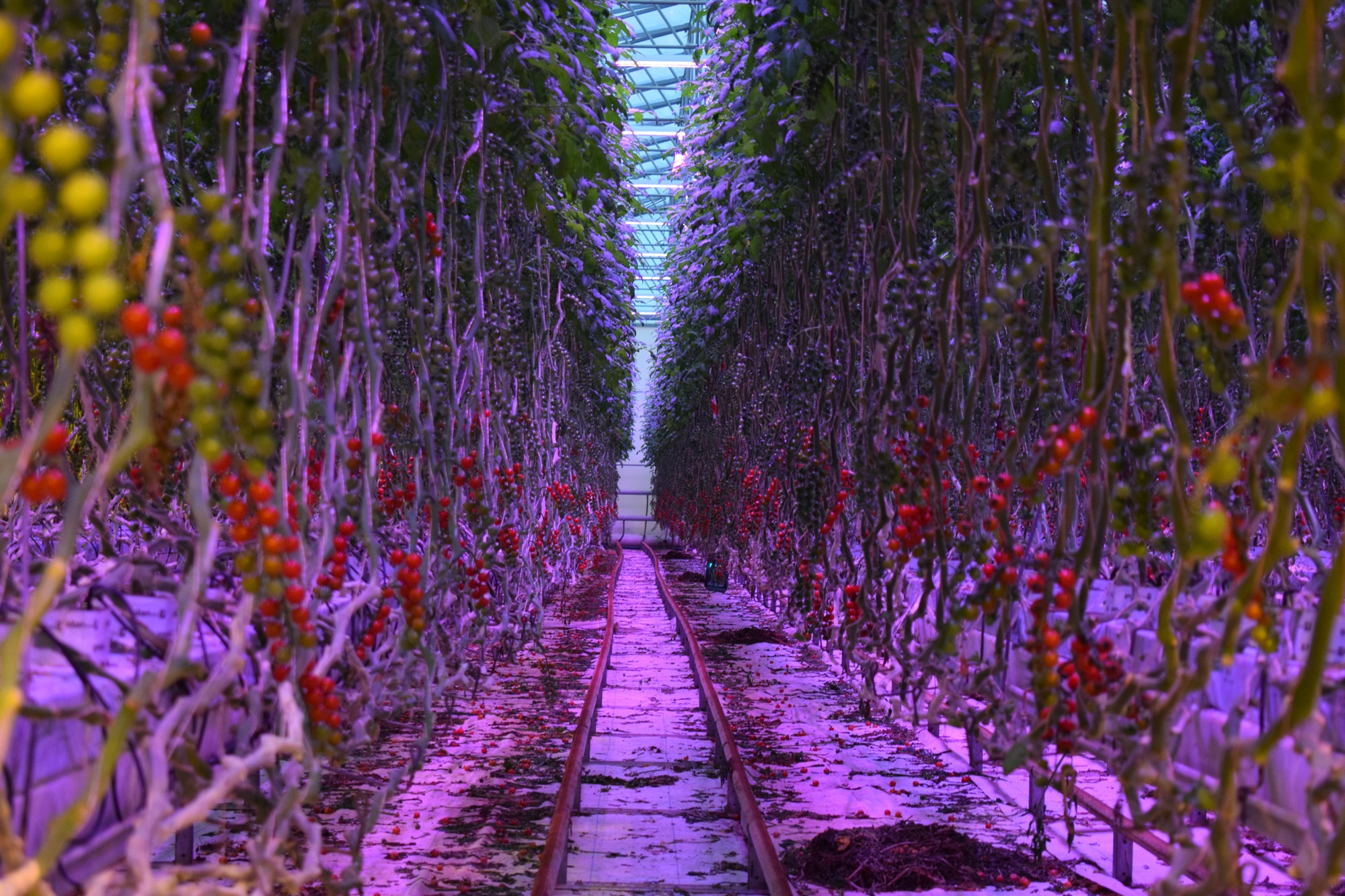
Step or Incremental Change: A Strategic Decision
When many people think about technology in farming, they envisage the big step changes such as the complete move from manual picking
to robotic picking. Or big tractors to little robots. And these changes have happened before in farming. But more often, technological change has been incremental, giving a small benefit over previous actions.Understanding the difference between step change and incremental change is a lot like knowing when to use a big tractor versus when to take a more careful, hands-on approach. A step change is like bringing out the big tractor, making a big impact, and able to transform things fast. On the other hand, incremental change is like walking the fields and tending to the crops by hand—slow, steady, and deliberate, leading to gradual but steady progress over time. Both have their place on the farm, depending on what’s needed to get the best results.
But let’s face it we all love big tractors!
You as farmers are confronted with a choice, a strategic crossroads that can significantly influence the direction and ultimate profitability of your farms: should you embrace a radical rethinking, known as a step change, or choose the measured journey of progressive evolution, the path of incremental change?
When you think of technology on your farm, are you thinking big or incremental. A step change often requires a comprehensive rethinking of farming processes and commitment to whole new machinery. Even getting the timing right of such a big change is a massive decision. But this sort of decision has the power to change a business overnight, ignite new feeling and renew business growth. With these big rewards, step change carries inherent risks as well.
How will staff react to the change, how stable and reliable is the new technology? Lots of things to consider. In contrast, incremental change is a journey of progressive evolution, promoting the process of continuous improvement. This approach excels in stable environments where change is slow and where predictability is critical.
For farms constrained by limited resources, incremental change offers a path to controlled growth. It also acts as a safety net, offering a cautious progression when the risks associated with drastic changes loom large. Crucially, incremental change allows a farm to evolve while preserving its core values and staff culture. That said, changing slowly may be too slow if others around you are moving faster.
The agricultural landscape does change around you and farmers need to make sure they aren’t left behind. A balance is required and knowing when you can take small steps and when bigger ones are needed is complicated. And so, the choice between a dramatic decision —step change, and a graceful slide—incremental change, isn’t a binary decision. You are going to need to make a some big changes and lots of little steps. Many of these will be dictated by the latest technology available and we discuss many of these in this magazine. From choosing a different wheat to grow next year, though to adding a vertical farming container to your farm.
There are now so many ways a farm can change what it grows, with some of these changes being a radical shift based on the history of what you have grown. But you have the land, the power and the resources (like this magazine) to choose what decisions suit you (and your family). Farms have lots more options than many businesses as they have space.
That should be seen as a good thing, even if it complicates your decision-making process. Have a read of the rest of this magazine and see what makes you think of taking some big steps on your farm and what will help you make those smaller incremental changes. While remembering, the ideal strategy harmonises the radical transformation of step change with the steady progression of incremental change. Get this right and your farming will thrive and you will also learn a lot along the way.
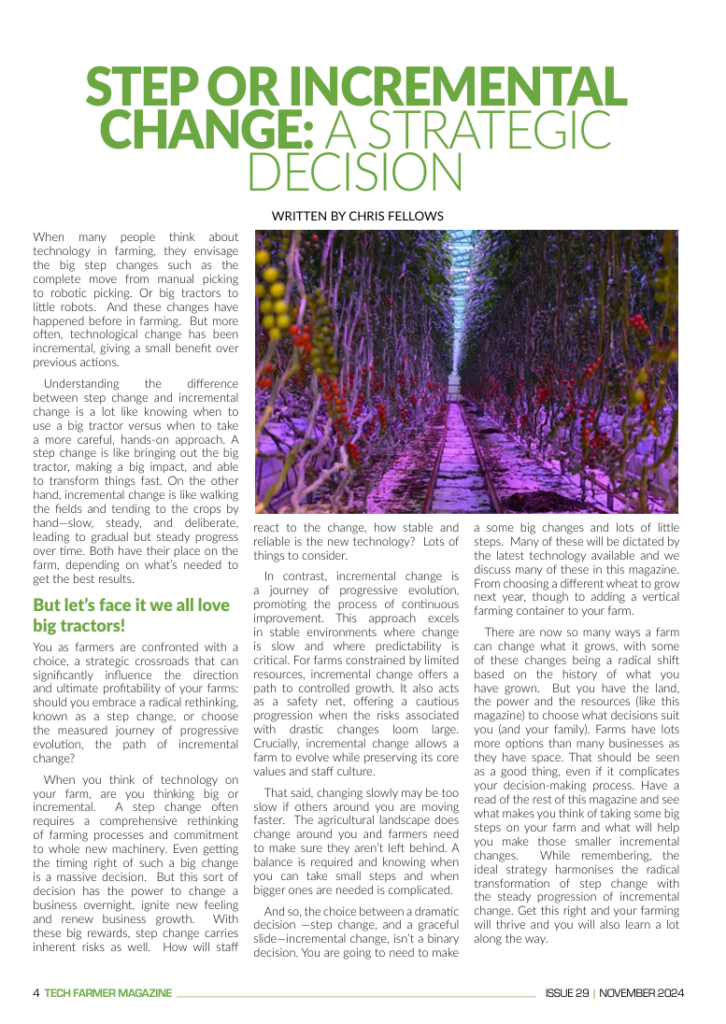
-

Can Tech save Carbon from a crisis?
Tom Allen-Stevens travels forward to 2030 and looks for the farmers who would emerge strengthened if the bubble burst on the carbon market.
Here in 2030, it’s very easy to claim the benefit of hindsight. But it’s fair to say few could have foreseen the depth of the scars that would lash the farming landscape when the carbon bubble f inally burst. In the UK, this wasn’t helped by the disastrous and now notorious family farm tax the incoming Labour government introduced in its first budget, back in 2024. As land rapidly changed hands, its value as a carbon sink was overplayed by unscrupulous traders, keen to sucker in a new generation of hapless landowners.
The deregulation brought in by the Trump administration in the US fuelled worldwide growth in carbon markets that many economists warned was dangerously unstable. Following market collapse, the question many in the food industry are now asking is whether the measures brought in by the new Lib/Lab coalition will stem the current meteoric growth in food prices. It’s probably too late for family farming businesses to come back into land ownership and make a credible difference to food security, following its dive to a reported 40%.
The NFU has also dismissed the proposed food security capital fund the government is intending to pour billions into – this won’t be incentive enough for new landowners to rebuild the farming infrastructure lost over the past five years, they say. But the carbon market has now stabilised in the US, thanks largely to measures the new president brought in shortly after she took office. So could confidence in carbon tempt landowners to make the investment needed for farmers to grow the nation’s food on so much of the UK’s land that’s just been left to deteriorate? There is a glimmer of hope.
One sector of the carbon market that remains rock-solid is where it’s built on the new Regenerative Carbon Standard. This came about because scientists worked directly with farmers to develop on farm new technologies in measuring and understanding the soil microbiome. And that’s where the benefit of hindsight comes in. If you have retained your 2024 copies of Tech Farmer, you can leaf through the pages of those early editions and remind yourself of the tech you saw first, and that’s now underpinning the standards of more sustainable farming systems. It was why we featured Rachel and Jacob Holmes back in November 2024.
At a time when there was precious little scientific measurement of practices claimed to build soil health, they were determined to bring this into play across A more scientific understanding of the soil microbiome could be the key to a rock-solid carbon market. their farm on the Isle of Wight (see Issue #31 p41). Photosynthetic promoters are another example (see p6). Working with scientists, farmers trialling those early, pre-commercial products developed an understanding of their crops’ biosynthesic pathways. It’s this knowledge that now forms the backbone of cropping solutions for carbon capture that can be reliably measured and consistently improved.
Then there’s the World AgriTech Innovation Summit (p26), the biennial event that takes place in San Francisco and London, now recognised as the stimulus for pioneering farmers on both sides of the Atlantic to take on new tech. Few growers in 2030 would trust anything other than RNA diagnostics for a truly accurate and measurable picture of crop health. This was first presented at WATIS San Francisco in 2024. Perhaps the most promising tech for sustainable and reliable soil carbon capture is now coming from precisionbred crops, however. Cast your mind back to November 2024 and the launch of #PROBITYPledge, the campaign that encouraged farmers to find out about this new technology and help shape how it should be introduced on farm (p39).
These are among the technologies we now consider as fundamental to delivering a robust and sustainable agriculture. But five years ago, in 2024, they were seen as fairly remote, with the opportunities they held unclear. They would never have made it into the field had it not been for pioneering farmers who diligently undertook the trials to acquire the knowledge the entire industry now relies on. So what were you testing in your fields back in 2024, and what will you glean from the pages that follow in this issue that could stave off a catastrophic crisis in five years’ time? Happy hunting.
Tom Allen-Stevens farms 170ha in Oxfordshire and leads the British On-Farm Innovation Network (BOFIN).

-

Harnessing the power of the sun
Farming in a greener way generally involves increasing efficiencies in pursuit of the goal for crops to produce more from less. Tech Farmer explores some novel technologies that use energy from the sun to enhance crop production.
Written by Lucy de la Pasture
About 93 million miles away the sun powers all of life on Earth, providing solar energy for plants to capture and turn to chemical energy through the process of photosynthesis. And it’s this solar energy that’s being harnessed to develop products that can help crops be more efficient in a surprising number of ways.
Photosynthesis is naturally an inefficient process, with plants only able to use about 1% of the solar energy available to them. That’s because plants evolved to harness the sun’s energy for the sole purpose of supporting growth sufficient to produce seeds, thus ensuring continued survival of the species. But humans ask much more of plants as they push the boundaries of food production, farming at scale, and despite the tremendous advances in crop production, a biological limit to yield remains because of a plant’s natural ability – or inability – to process light.
But what if the photosynthetic process could be more efficient, remove more carbon from the atmosphere and increase crop yields without using more fertiliser? This is exactly what ex-Bristol University researchers Dr David Benito and Dr Imke Sittel set out to achieve and they’ve been so successful in their quest that they founded Glaia in 2019 to commercialise a photosynthetic promoter.
The company is licensed to use the technology in biostimulant products to help increase crop yields in a sustainable way. The first product of this kind, Fragaria, has just been launched in the UK and Netherlands for use in strawberries, with availability in Spain and the US soon to follow.
“If we could increase the efficiency of photosynthesis to 2%, we could double the yield of crops. But we’re not there yet,” explains David.
Drawing inspiration from the carbon-based nanomaterials found in nature, the photosynthetic promoter uses a nanocarbon material derived from sugar. These sugar dots open up the photosynthetic process inside plant cells so they can take in more solar energy and convert it into more biomass. Essentially, it fine tunes nature’s engine, giving plants the potential to increase efficiency at a molecular level.
So how does this happen? David explains that plants capture energy from sunlight in the leaf, causing electrons in the chlorophyll to become ‘excited’. “It’s this energy stored in the chlorophyll that’s used to split water and generate oxygen. Additionally, electrons are transported down the photosynthetic chain and incorporated into high energy molecules that are then used with CO2 and nutrients to form carbohydrates.
“But the biological processes involved in transporting those electrons can’t cope with all the available energy, so the plant uses mechanisms to protect itself against light. What it does in very simplified terms is to stop photosynthesis when the light is very intense,” he explains.
A feedback loop switches the process back on when light intensity falls and it’s this ‘on/off’ switch that contributes to the inefficiency of photosynthesis, adds David.
“Our photosynthetic promoter allows plants to process more of that energy because it facilitates electron transport, enabling plants to capture more solar energy and transform it into chemical energy. And because less damaging, unused energy is left in the leaf, the plant doesn’t have to switch off photosynthesis for so long and there’s an overall improvement in photosynthetic efficiency.”
Although the technology hasn’t yet improved photosynthetic efficiency enough to double the yield of crops, trials are producing a very respectable 20% yield increase with no additional nitrogen inputs, effectively producing more food without increasing CO2 emissions, he says.
“We saw an opportunity for this technology to change the way we produce food in the sense that it can help reduce the climate impact of agriculture. Its mode of action improves the photosynthetic efficiency of plants by allowing them to utilise more sunlight, capture CO2 and increase yields sustainably because no extra nitrogen is required.
“By applying the Glaia technology, there’s an increase in yield and that’s because it improves nutrient use efficiency as well. It translates to an overall reduction in CO2 emissions per tonne of produce by at least 15%,” he claims.
The company aims to bring its biostimulant technology to all crops, with the biggest impact on CO2 emissions possible in arable crops, highlights David. Trials in winter wheat are underway and earlier work has already shown average yield increases of 18%, underlining its potential in broadacre crops.
“Because there’s a more limited opportunity to apply a photosynthetic promoter in wheat than in strawberries, we’re developing an application protocol that won’t involve an extra pass for growers,” he adds.
Another biostimulant technology with solar radiation at its heart is being developed by Hertfordshire-based SugaROx. The company was spun out of Rothamsted Research and Oxford University in 2021, bringing together the knowledge gained by researchers to improve sucrose allocation in crops, thereby increasing yield.
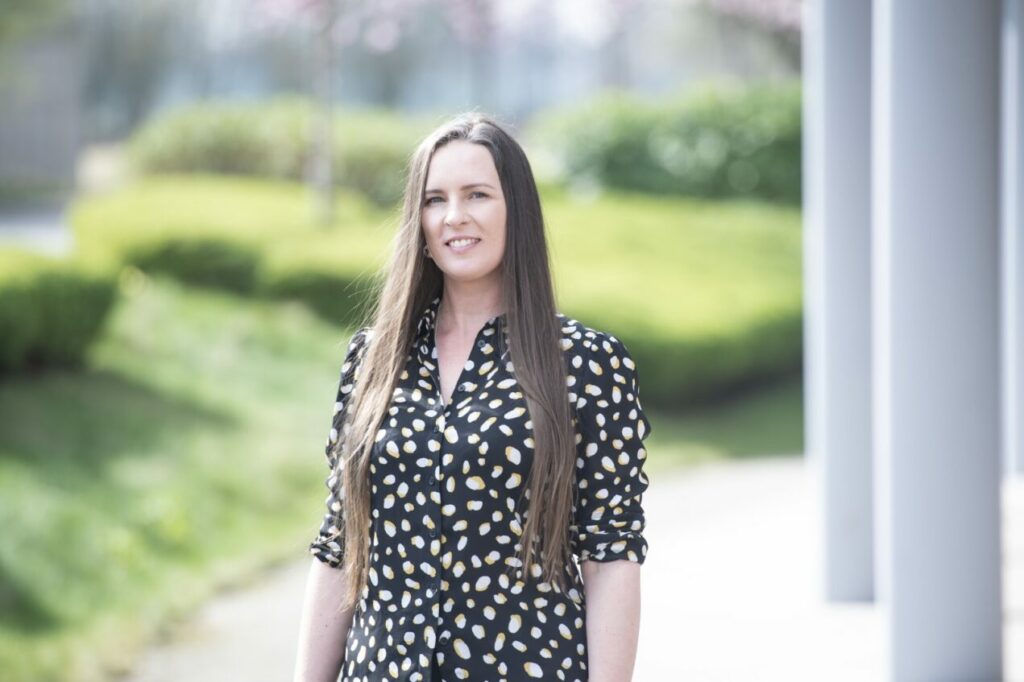
T6P marries up with innate plant chemistry, causing T6P levels to spike and supercharging the grain fill process, explains Dr Cara Griffiths. The technology is patented and licensed and will be the only authentic trehalose-6-phosphate (T6P) synthase technology available to growers, born out of the decade of research undertaken to develop it, explains Dr Cara Griffiths, co-founder and chief technology officer of SugaROx.
T6P is a signalling molecule and an intermediary of the trehalose biosynthesis pathway, in which endogenous levels are synthesised to match sucrose content. “You can think of T6P as a sucrose fuel gauge and it’s a mechanism that’s present in all plants to regulate sucrose use and allocation.”
It does this by interacting with an enzyme called SnRK1, explains Cara. “It’s a major sucrose utilisation enzyme, and it has two kinds of modes – feast and famine. This is where T6P comes in; it can switch the plant from famine into feast mode by telling the plant that there’s lots of sugar around so that it can transport it to where it’s needed and store more sucrose in its tissues.”
The discovery of the role of the signalling molecule highlighted the potential for manipulating the T6P mechanism for crop improvement purposes.
“Our aim was to find a way of increasing T6P and carbon allocation in a non-genetically modified way. To achieve this, we had to create a novel version of T6P,” she comments.
The products SugaROx is developing are a modified version of T6P, with a chemical group added to the molecule. “Essentially, it’s a caged T6P compound which acts as a T6P delivery system,” explains Cara.
This was needed as in unmodified form, T6P can’t be taken up by plants when applied as a foliar spray, she adds. “T6P itself is very polar, so once sprayed onto a leaf it will just sit on the leaf surface rather be taken up by the plant. The chemical addition that we’ve added changes the charge of the molecule, helping the uptake of T6P within the plant.”
And this is where solar energy has an important role. “Sunlight is needed to cleave this group off the modified T6P, which was added to aid its transport. The T6P is then released into the plant where it’s biologically active.”
The SugaROx technology is particularly suited for crops with a sink-based yield, such as wheat where Cara describes it as “a magnet for sugars and nutrients”. By applying during grain development, the applied T6P marries up with innate plant chemistry, causing T6P levels to spike and supercharging the grain fill process.
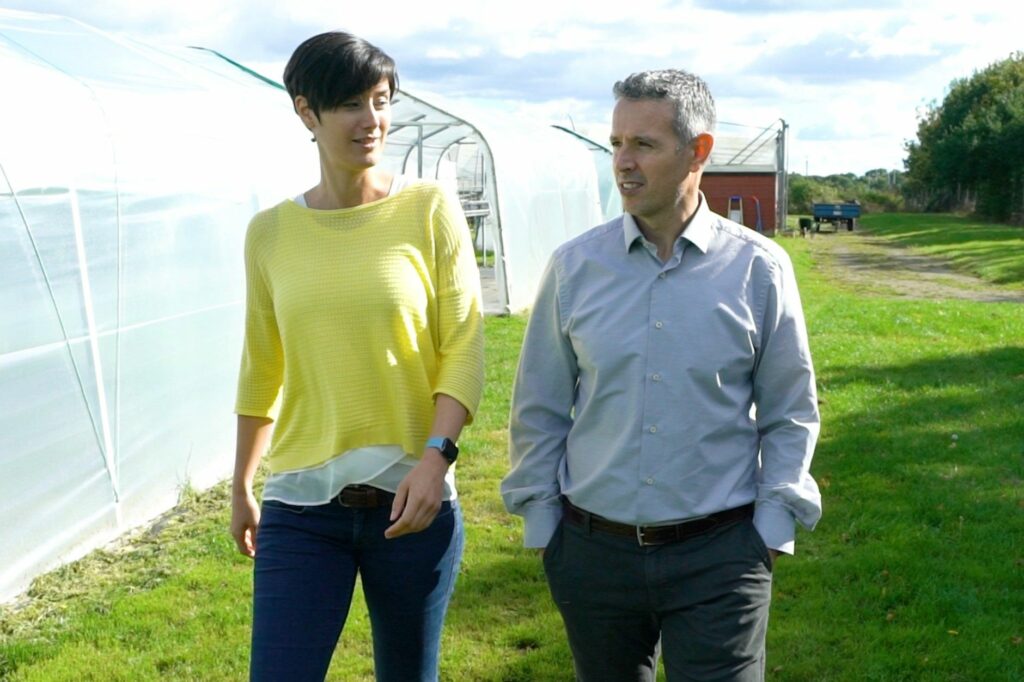
Dr Imke Sittel and Dr David Benito are commercialising a photosynthetic promoter to help plants process more light into sugars. “It switches on the SnRK1 enzyme which pulls everything that supports good yield production into the ears of the plants, producing yield increases of up to 22% in the field,” she claims.
The interaction of T6P and SnRK1 affects a number of plant pathways, including sucrose use and allocation, starch conversion and storage, as well as a general nutrient uplift into the area, explains Cara.
“Essentially, T6P is signalling to the plant that there’s lots of nutrition around and it should turn on all of its processes to do with growth and resource allocation. We’re just enhancing processes the plant already uses itself.”
The use of solar energy isn’t limited to influencing photosynthesis and sugar metabolism, it can actually initiate a process that simultaneously removes pollutants and greenhouse gases from the air while also fertilising the crop.
Photocatalysts such as titanium dioxide have long been known for their powers of detoxification but can only absorb light in the ultraviolet spectrum. This would limit their efficiency as an application to UK crops.
And it’s this problem that Crop Intellect has solved by processing titanium oxide in a way that makes it able to function as a photocatalyst under normal daylight conditions. The technology is available as R-Leaf, a sprayable suspension concentrate which acts as an alternative source of nitrogen and can replace 25% of the total nitrogen applied, according to the company’s trials data.

The science behind sucrose levels and allocation, Source: SugaROx “This is the first time that photocatalysis has been used in agriculture as a way to generate nitrates, but the story does not stop there,” says Alvaro Montero Bockos, Crop Intellect’s chief operating officer and sustainability lead.
“While the conversion of NOx air pollutants into nitrates produces an input to support crop growth and reduce fertiliser usage, R-Leaf brings a key difference to traditional fertilisers through its capacity to remove N2O greenhouse gas at the same time.”
The effectiveness of the photocatalyst used in R-Leaf has also been verified by researchers at Manchester Metropolitan University. Their work has shown the R-Leaf material is 10 times more effective in photocatalysis, both under UV light and normal daylight, compared with the unprocessed material. The results confirm that under daylight the product works close to that of the performance of titanium dioxide under UV light.
R-Leaf has been six years in development and is already on the market, with limited quantities available in the UK and Europe since 2022. This year up to 60,000 litres is scheduled for production and looks set to grow as distribution also begins in the United States
According to Alvaro, the technology is already firmly embedded in some agricultural supply chains because of its unique sustainability credentials.
“Instead of being a source of nitrous oxide, as all synthetic nitrogen-based fertilisers can be, R-Leaf converts these and pollutant NOx gases from the air into plant fertiliser, with an overall environmental impact of 5.4 t CO2e removed per year,” says Alvaro.
The company’s claim has been verified by the Climate Impact Forecast Tool and relates to the recommended two applications of R-Leaf at 1 l/ha and 25% nitrogen reduction.
So how does it work? “When R-Leaf is sprayed onto the crop, the photocatalysts it contains are charged with daylight. Electrons and hydrogen ions are produced which react with oxygen and water from the air to form powerful oxidising agents which break NOx down into nitrate and water,” he explains.
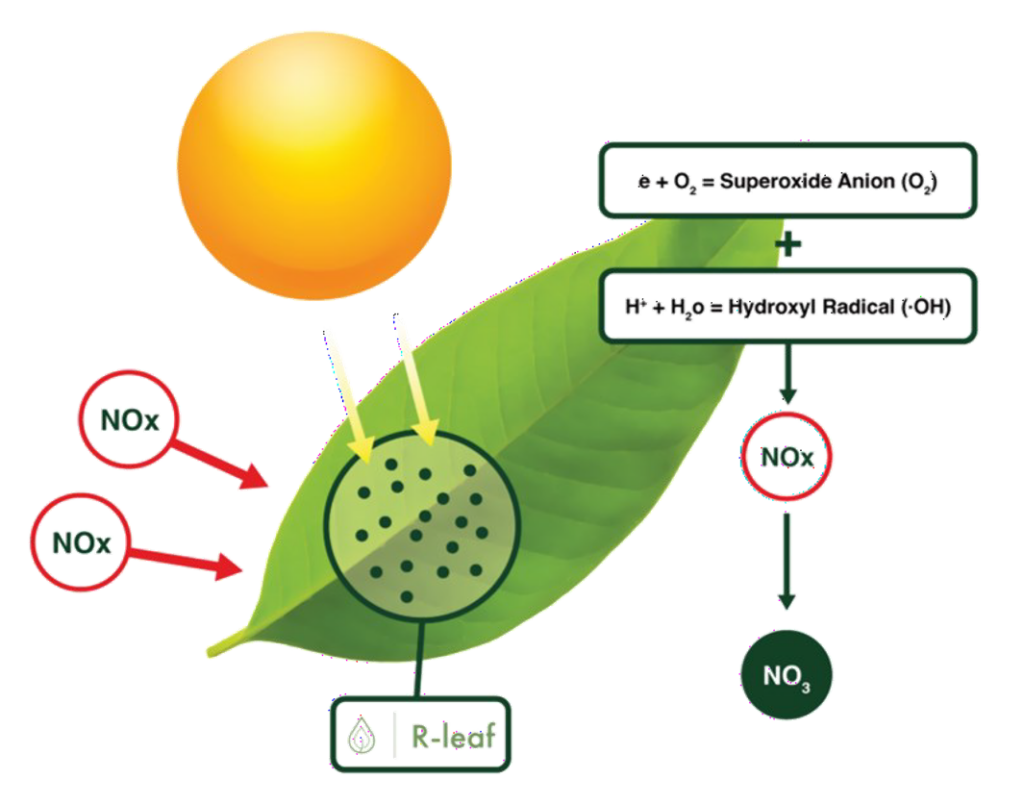
When R-Leaf is sprayed onto the crop, the photocatalysts it contains are charged with daylight. Electrons and hydrogen ions are produced which react with oxygen and water from the air to form powerful oxidising agents which break NOx down into nitrate and water. The nitrate produced in this reaction solubilises on the leaf, enabling foliar uptake by the crop. Because the photocatalyst is persistent on the leaf, lasting around six weeks, plant growth is supported by a slow daily release of nitrate.
“During the same process, when interacting with N2O gases, R-Leaf breaks it down into inert nitrogen and oxygen gases, effectively removing a GHG from the air. This brings additional sustainability benefits by reducing the overall carbon footprint.”
This removal has been confirmed by Ostrava University which showed a daily 10% removal capacity in the laboratory under simulated outdoor conditions. “Pollution is transformed into a positive. We have seen in the past three years of trials that we are able to generate 50-100KgN/ha and we have data that shows R-Leaf supports plant growth in a better manner than current fertilisers,” he adds.
Photocatalysis experts at Imperial College London have also quantified the amount of nitrate produced by R-Leaf under a system that simulates conditions in the field. They showed that R-Leaf provided the equivalent of 90kgN/ha over three months, explains Alvaro.
Cutting back on nitrogen from the bag may require a leap of faith for some farmers but Alvaro is confident the agronomic benefits from R-Leaf application add up. “Normally our recommendation is a 25% reduction in synthetic fertiliser when using R-Leaf and we consistently see an increase in yield of 5-10%,” he says.
The novel product is tank-mixable and the company recommends applying with T1 and T2 fungicide applications so that no extra sprayer passes are required.
The product has been trialled in a number of other crops including potatoes, carrots, peas, brassicas, and grassland with good results, the company claims. Interestingly, peas have also shown a yield response to R-Leaf application. It’s a surprising finding given the leguminous crop is often adversely affected by nitrogen application which reduces its nitrogen fixation and makes it more susceptible to disease. In three years of trials in the crop, yield responses of up to 20% have been obtained, according to Alvaro.
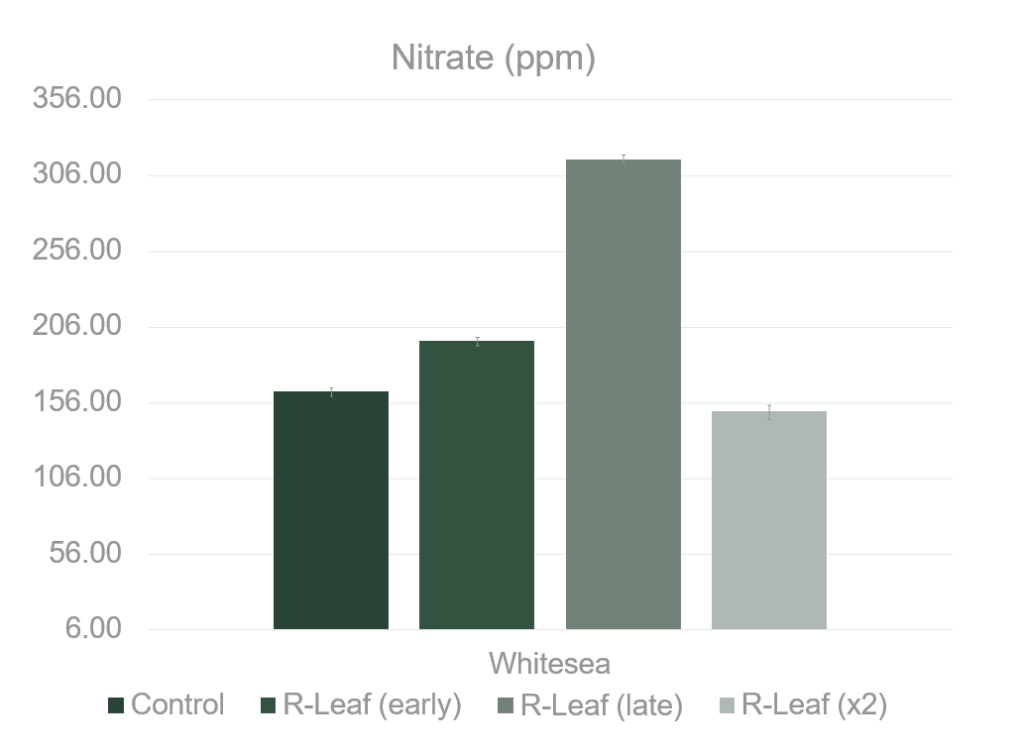
R-Leaf peas trial – nitrate. The additional nitrogen available to the pea crop after R-Leaf application seems to have a beneficial effect on growth and yield. Crop Intellect has just been awarded funding from Innovate UK for a project which will investigate the use of R-Leaf with endophyte products to further boost the sustainability of growing arable crops by potentially halving nitrogen inputs.
The project consortium is led by Crop Intellect and includes Barworth Research, University of Lincoln, CHAP, The Allerton Project, and Dyson Farming Research.
Multi-location field trials hosted at Dyson Farming will test how R-Leaf can be used with endophyte prototypes to combine their nitrogen-fixing benefits. The trials aim to reduce an estimated 50% of synthetic nitrogen fertiliser applied to wheat under standard farming practice.
Richard Meredith, head of Dyson Farming Research, adds: “We see large potential in how this can help reduce farm input costs while improving soil health through reduced synthetic nitrogen fertiliser use. It will contribute directly towards net zero emission targets in agriculture and impact positively across the entire agri-food supply chain, from farm to retailers and end consumers.”
And that’s the exciting potential of agricultural innovations such as these, believes Alvaro. “Potentially R-Leaf could be a simple solution to help limit farming’s GHG emissions – every leaf could be an R-Leaf.”
